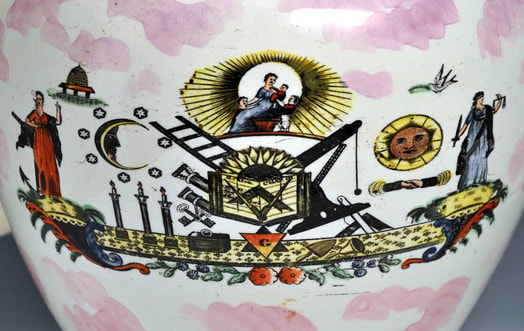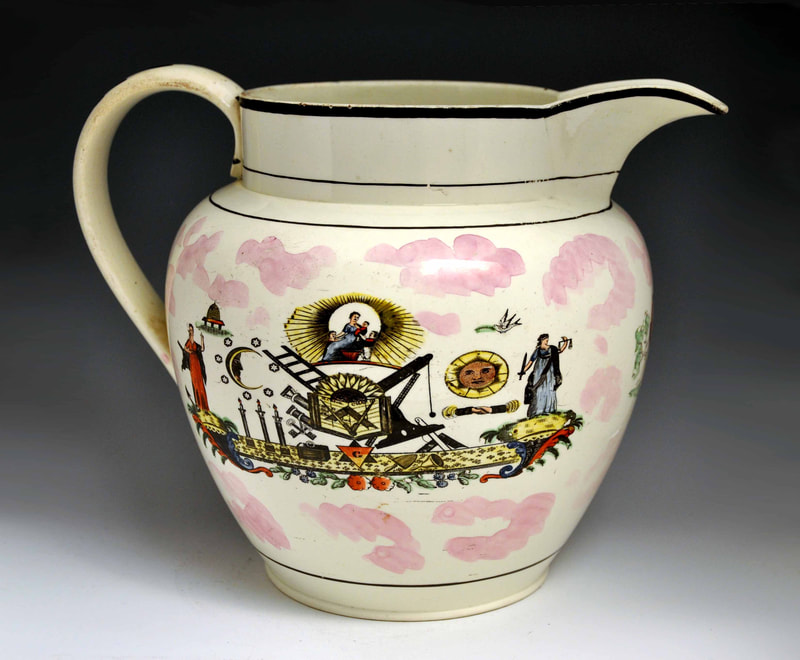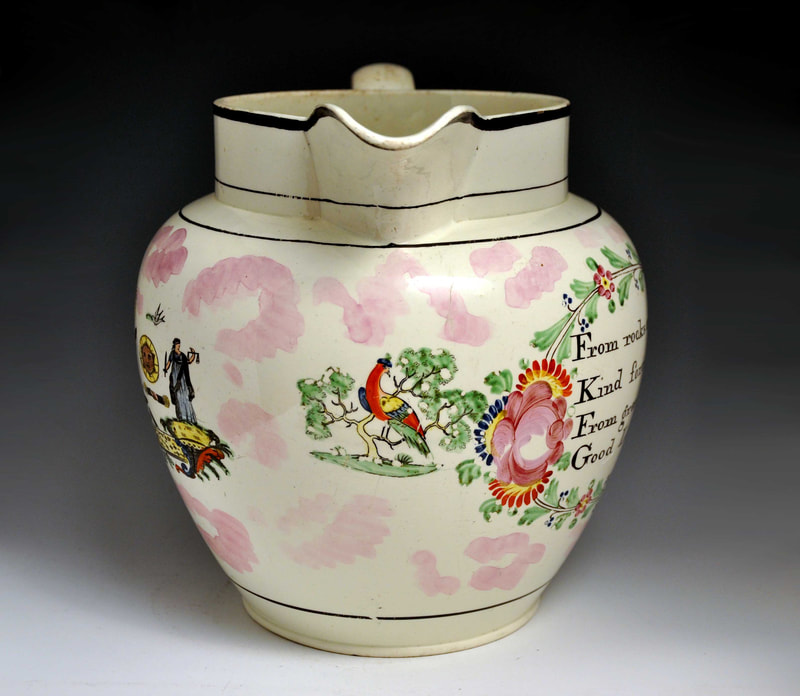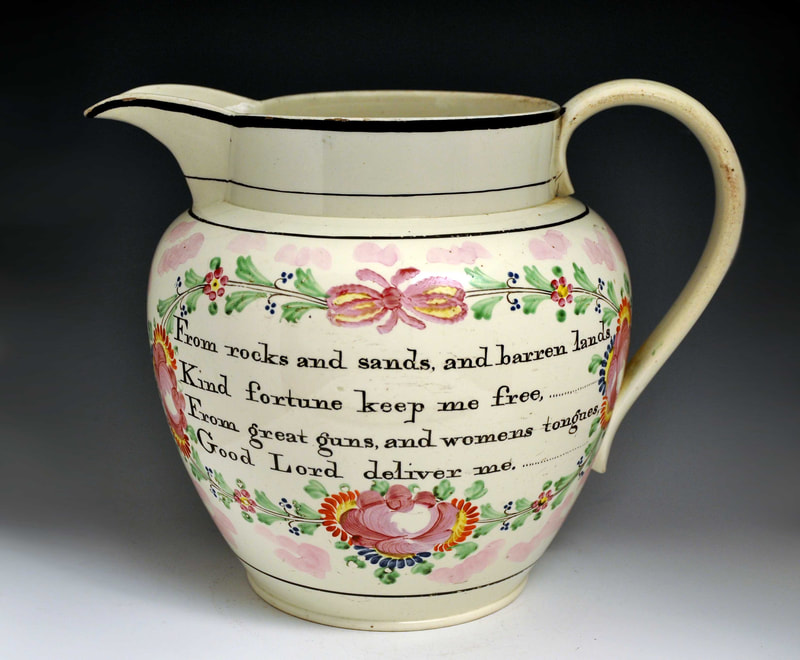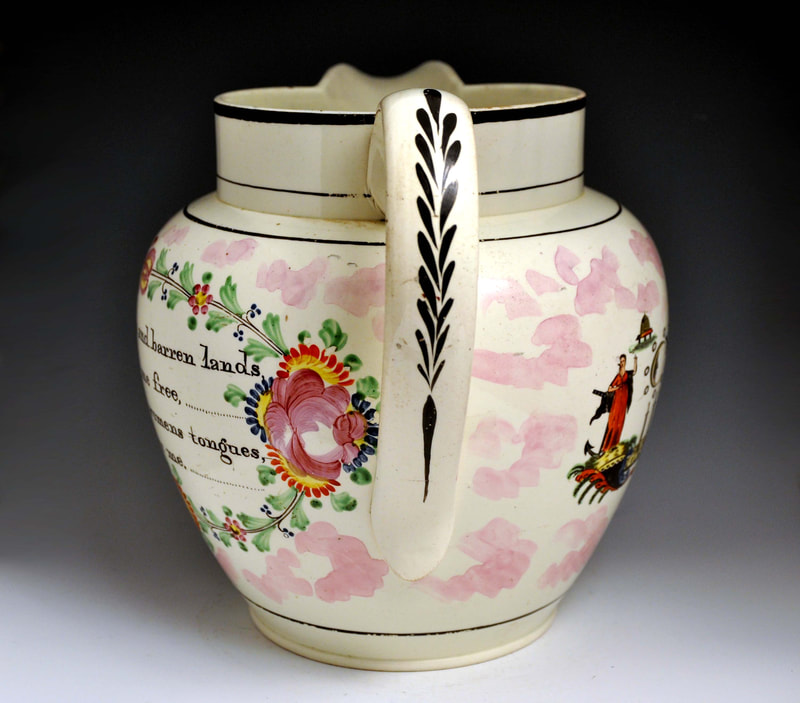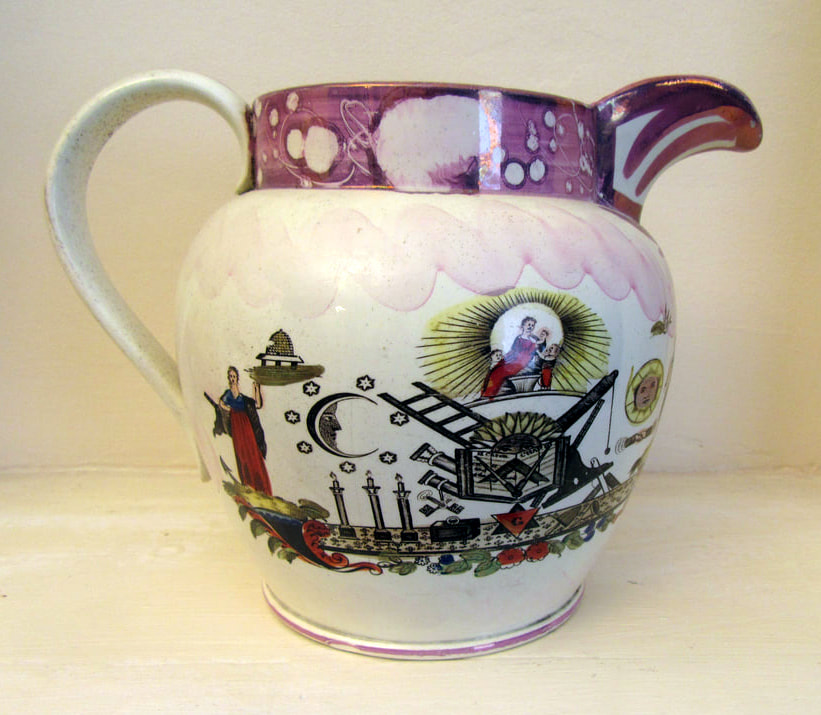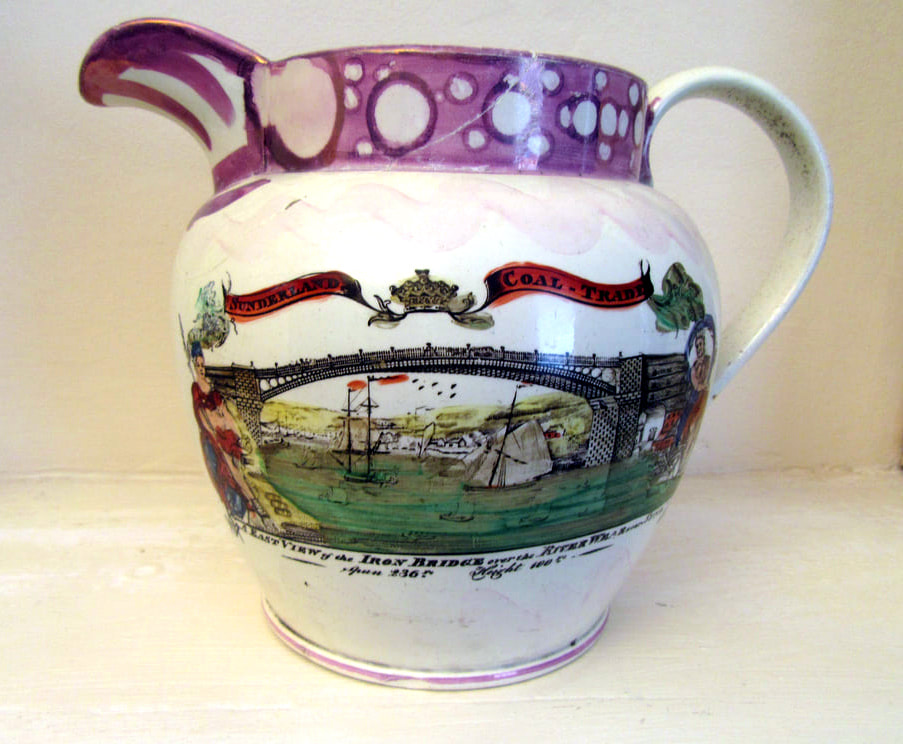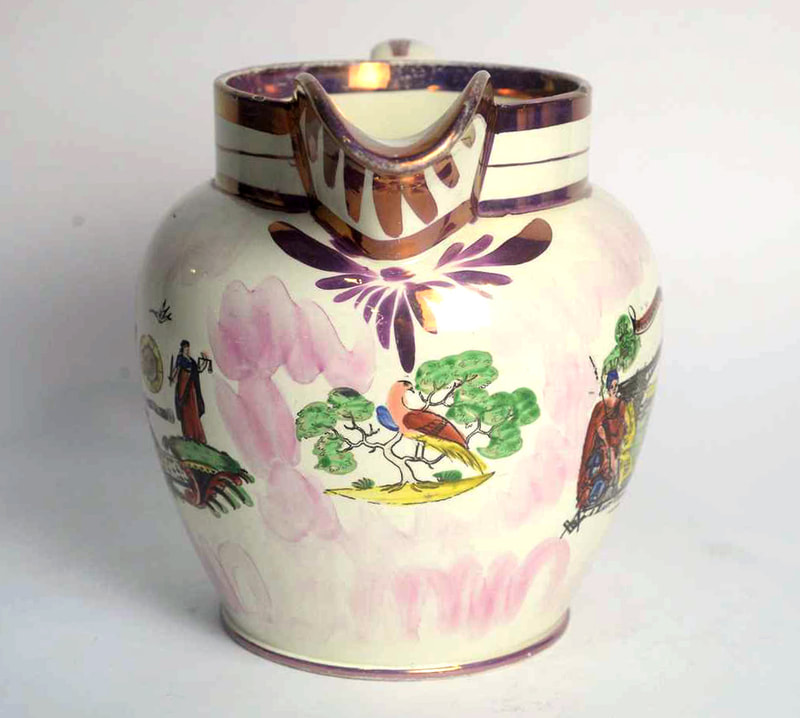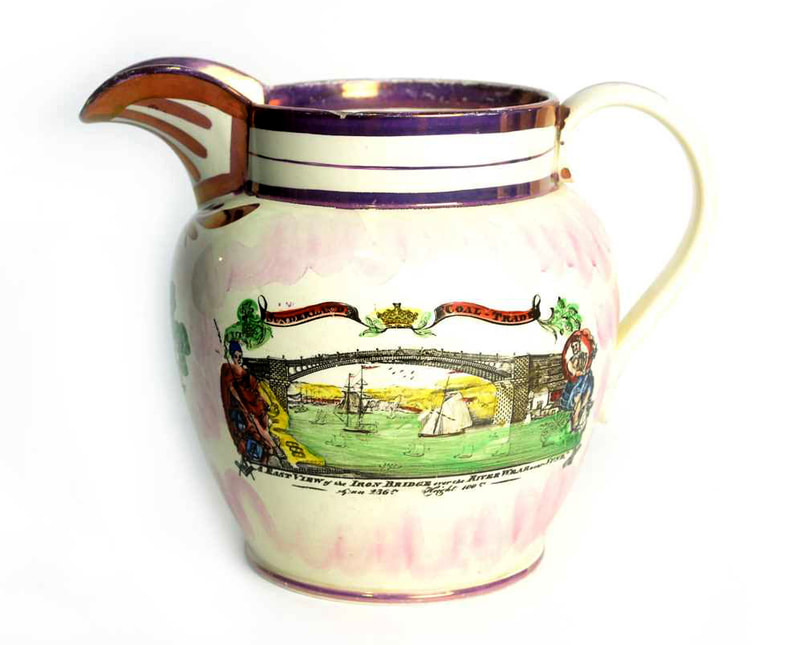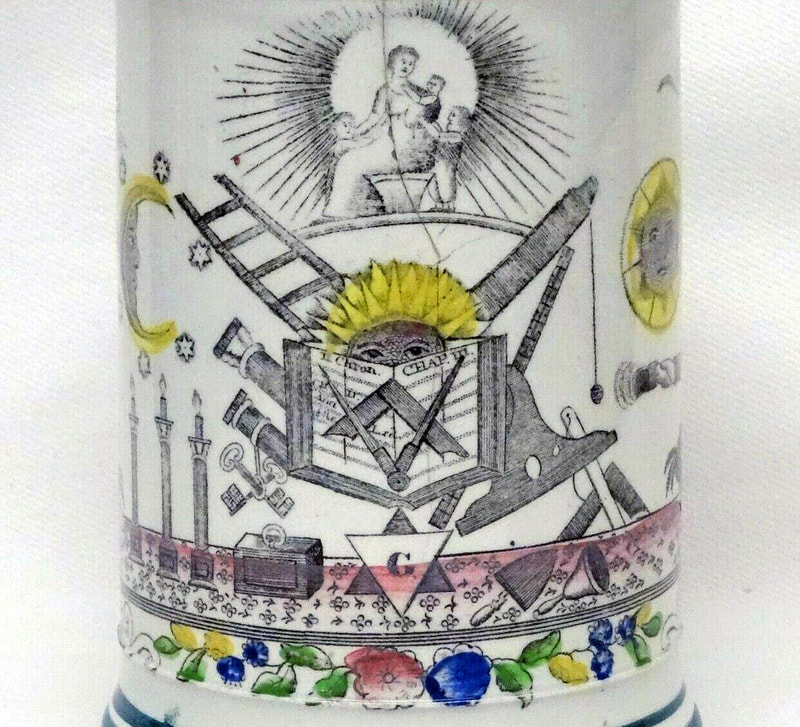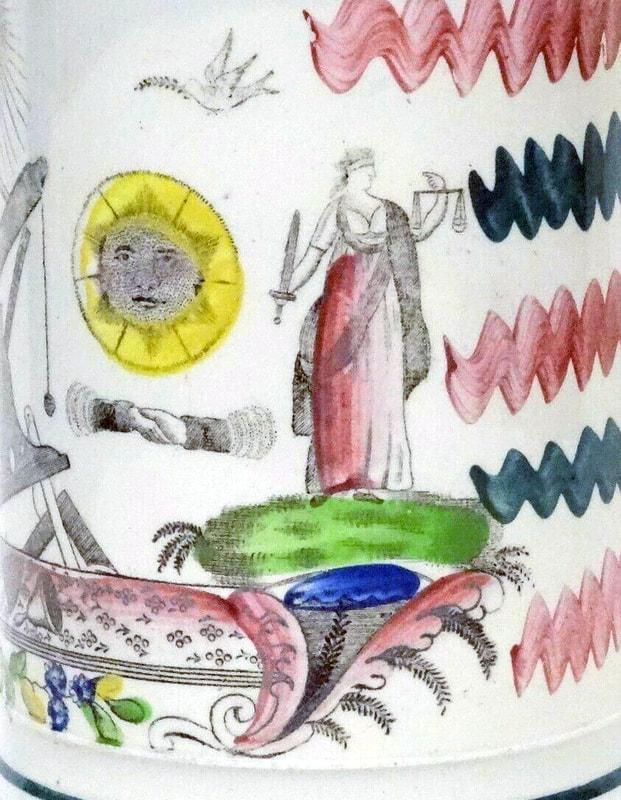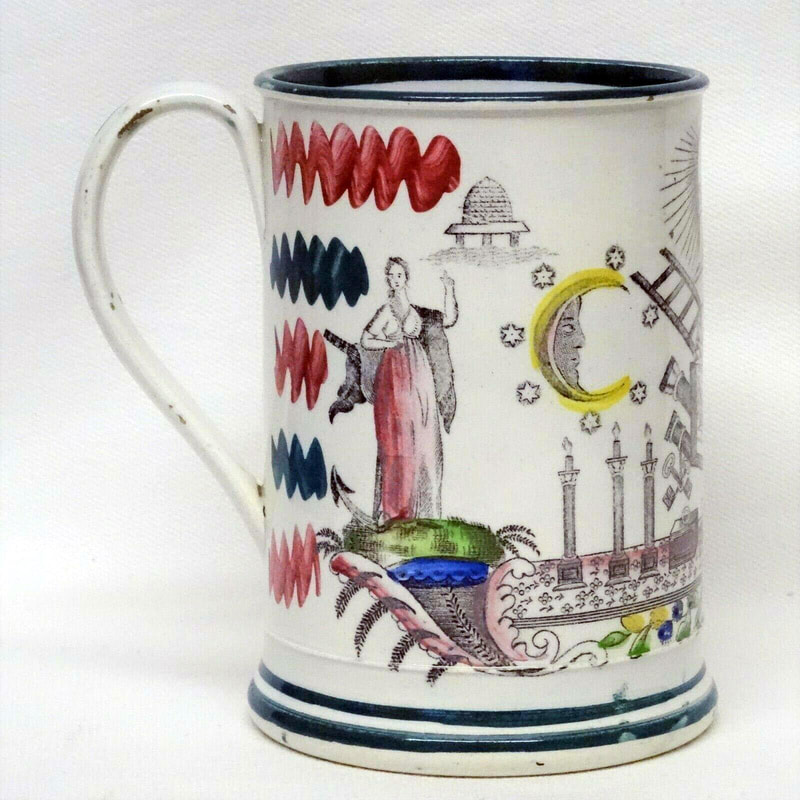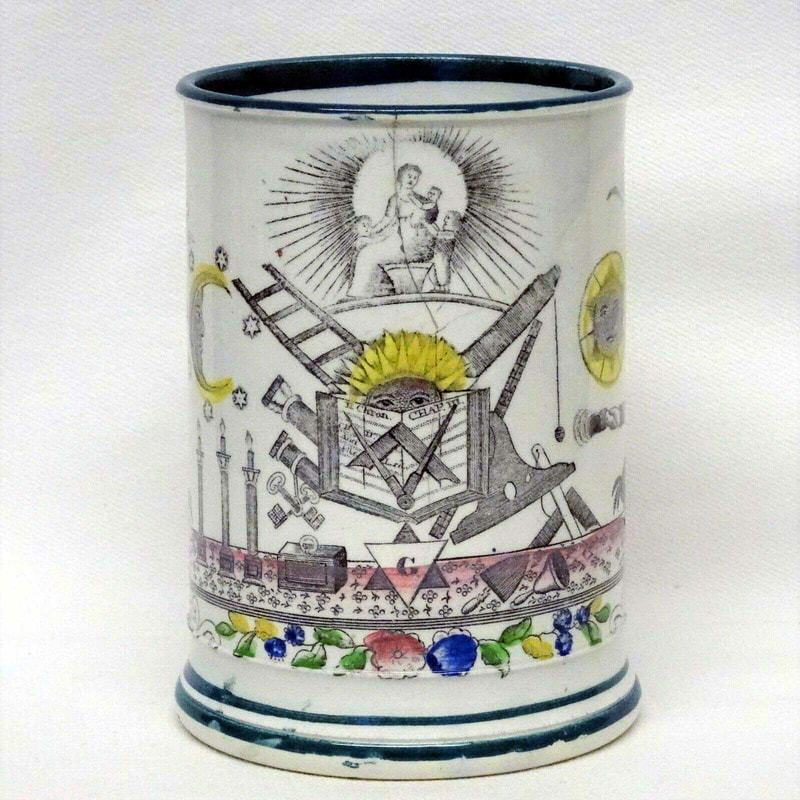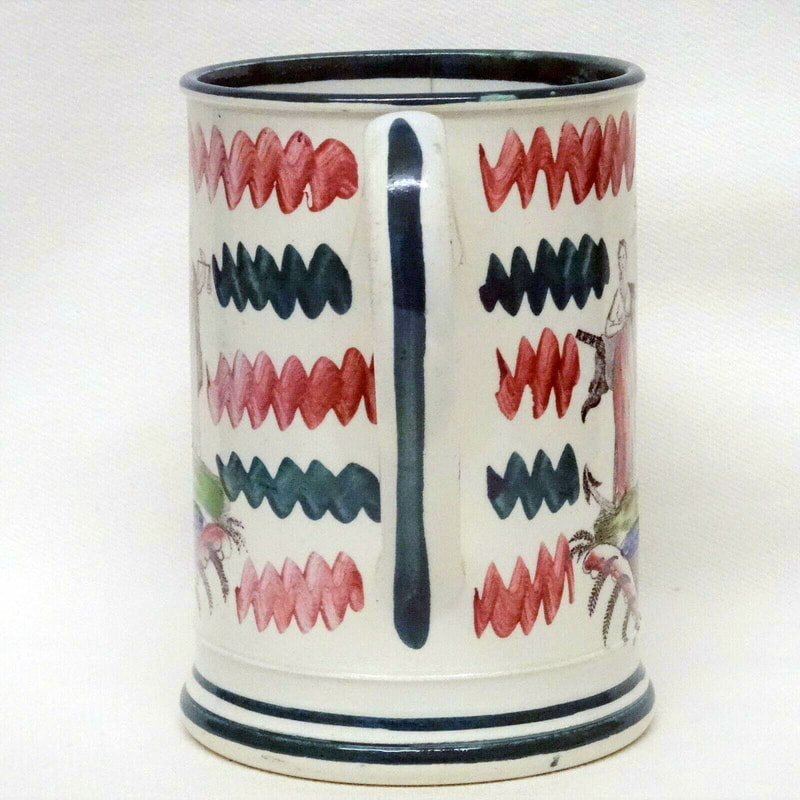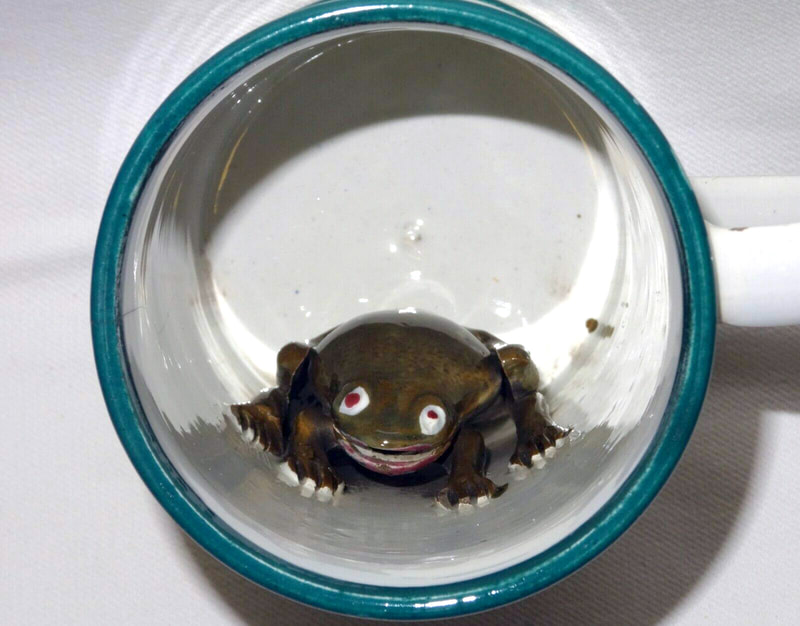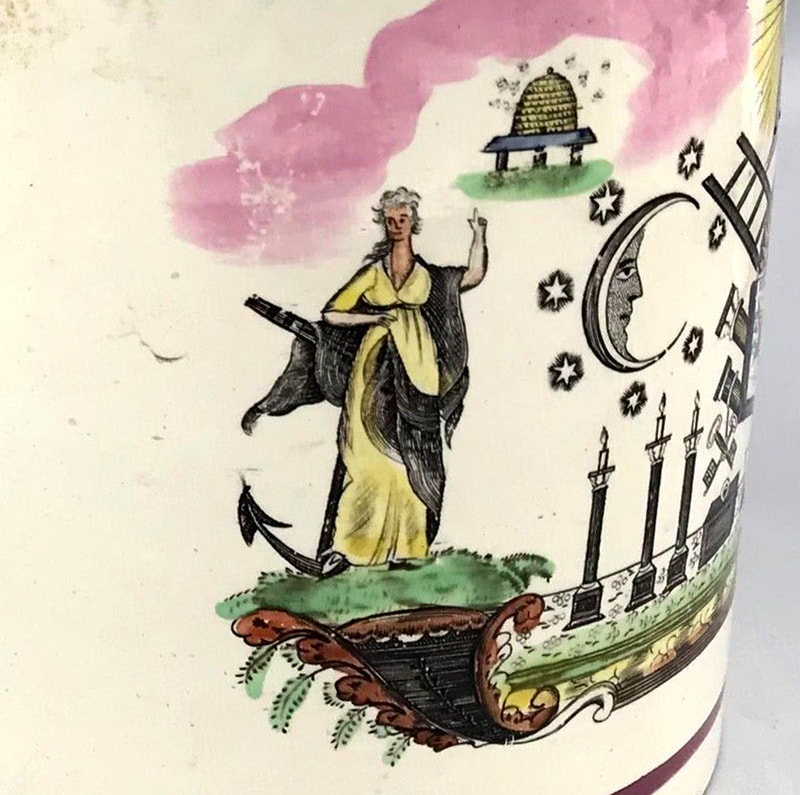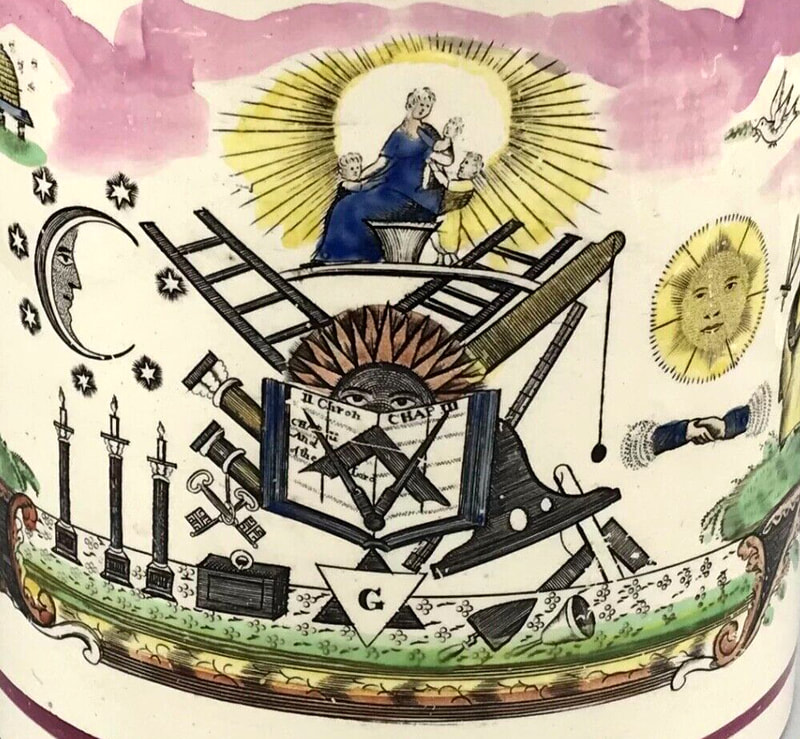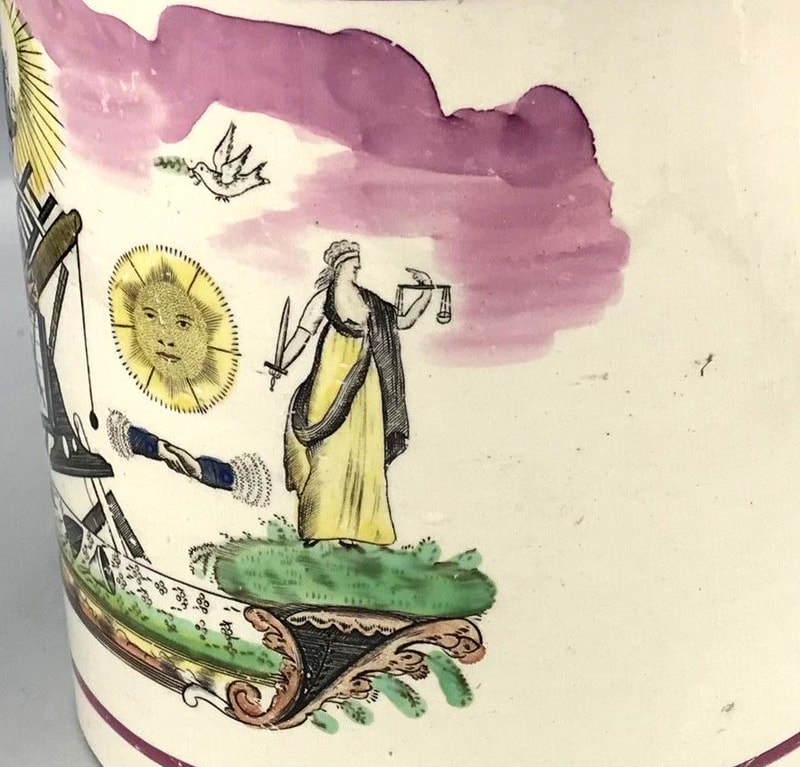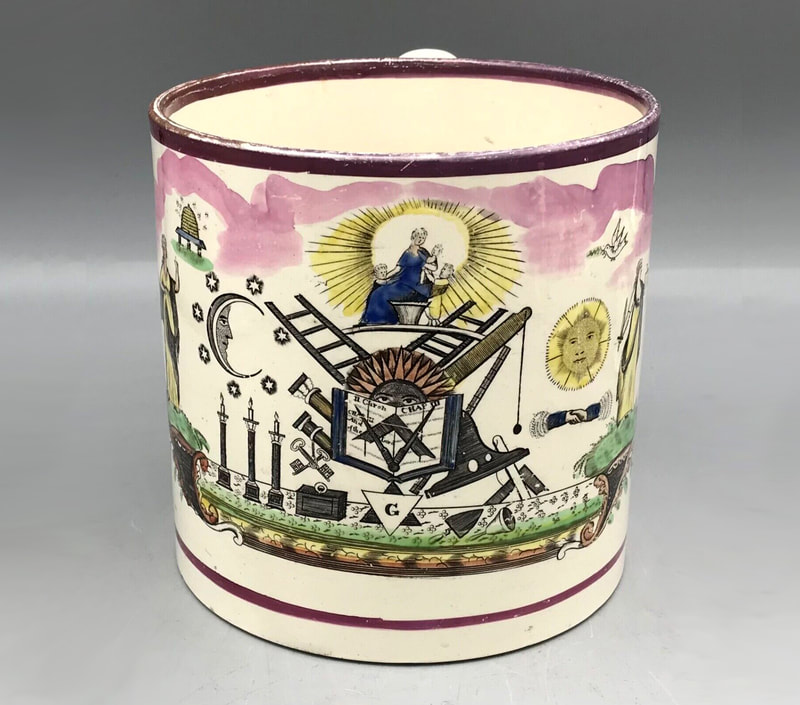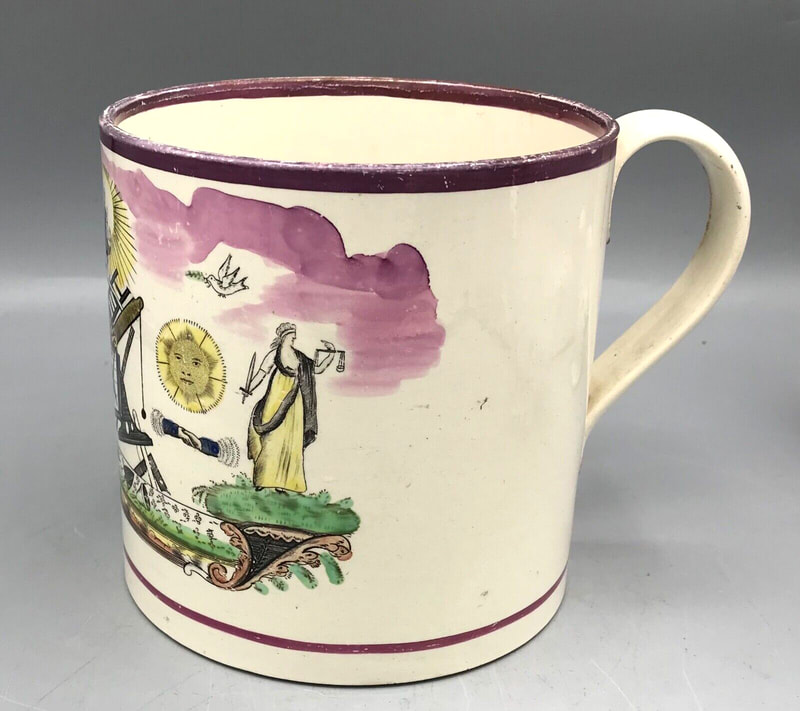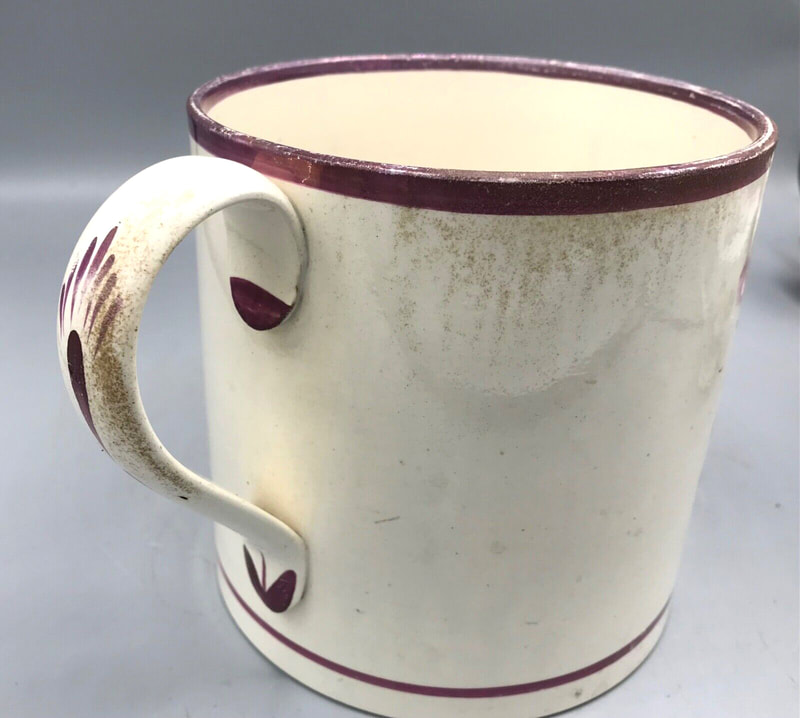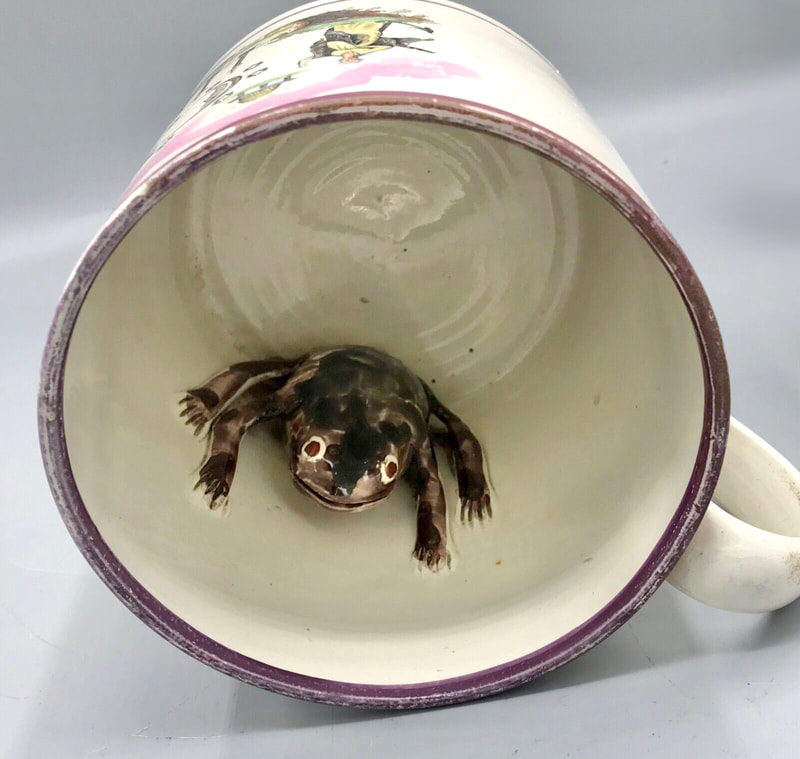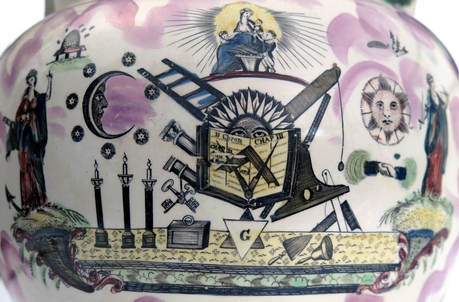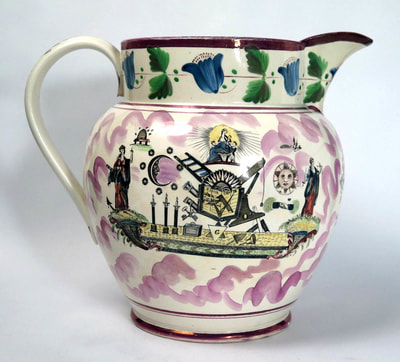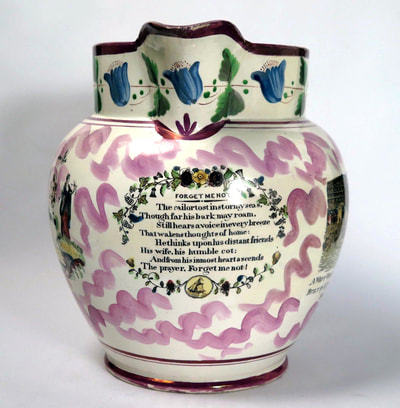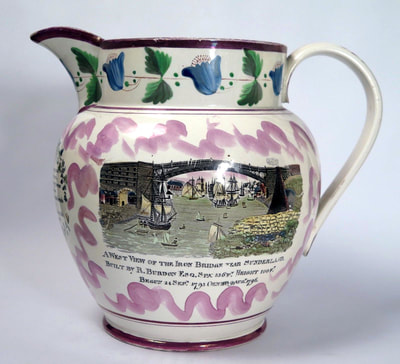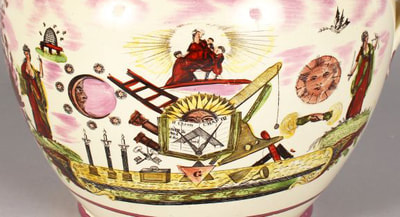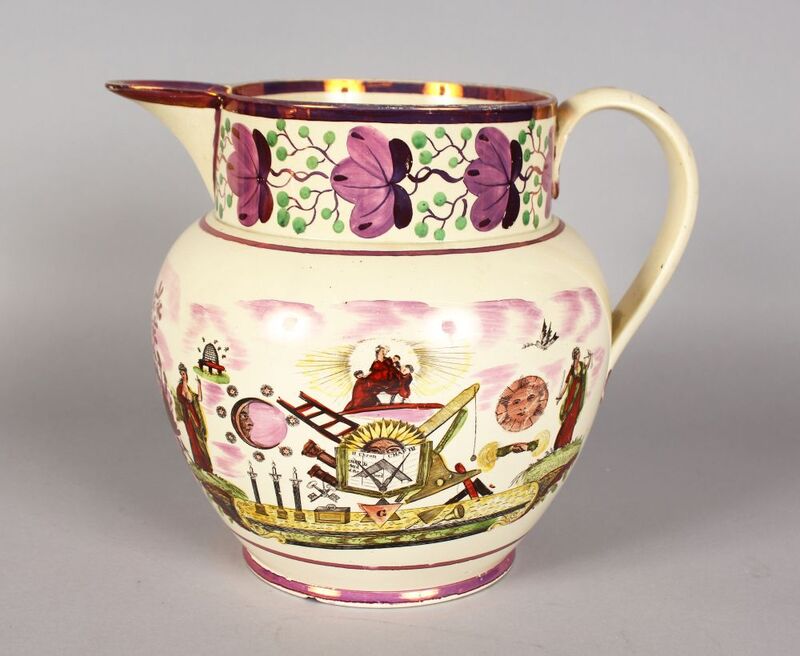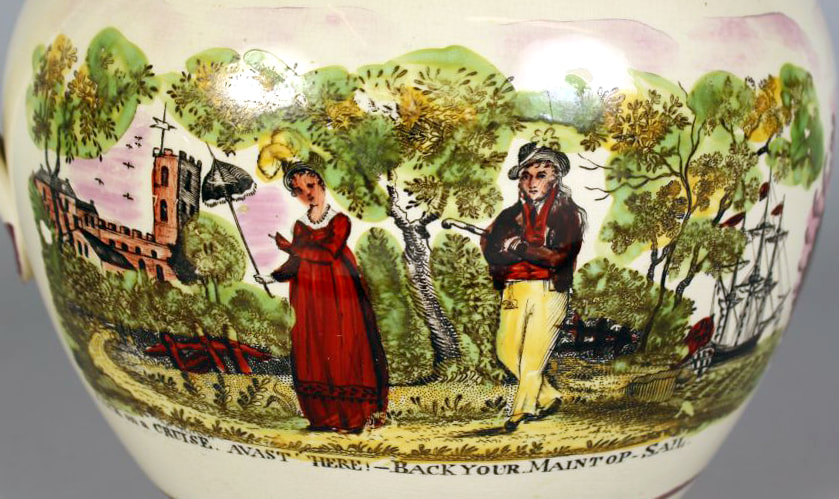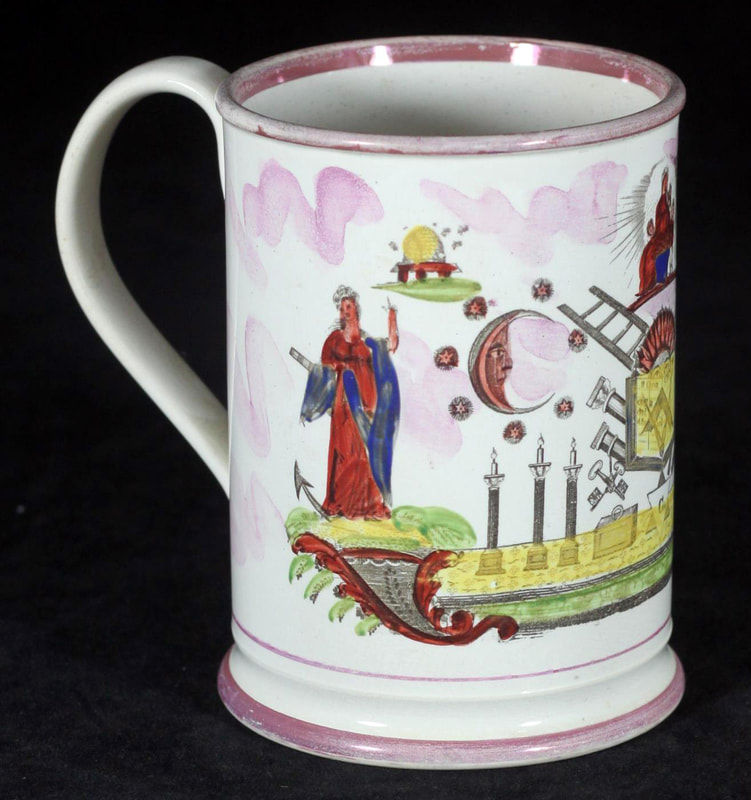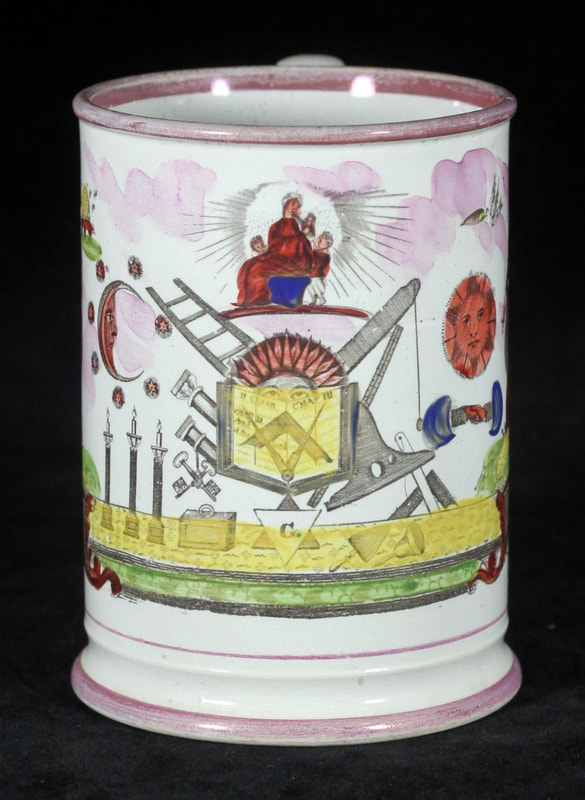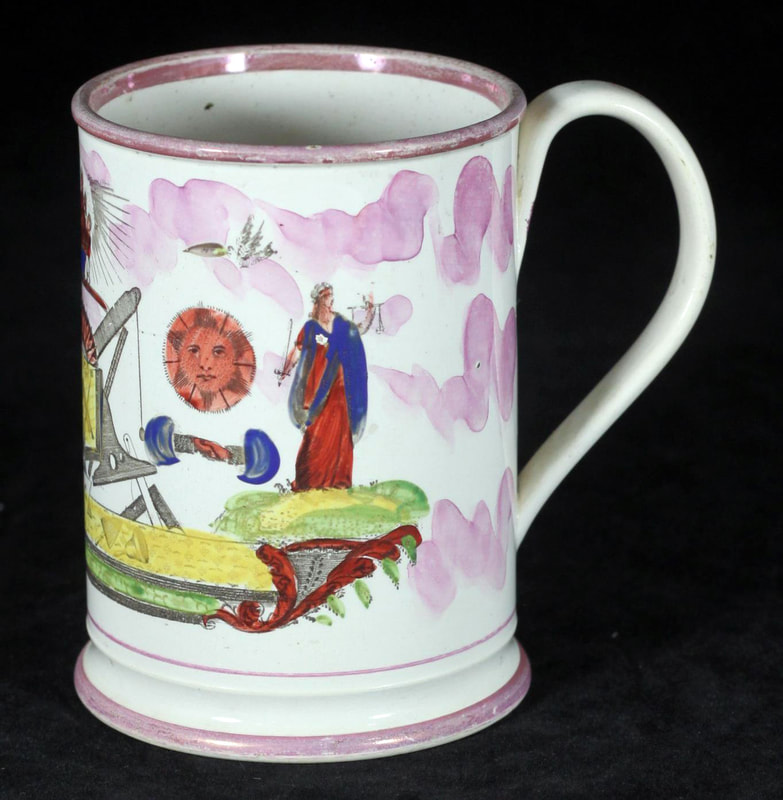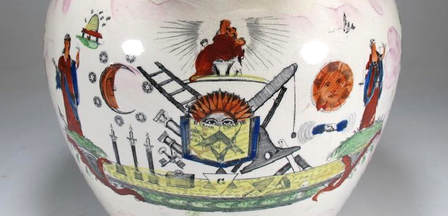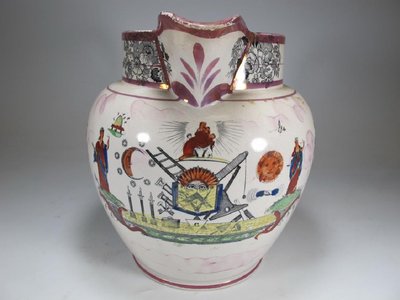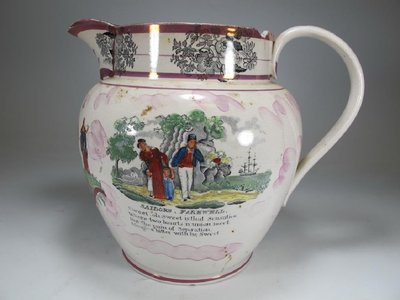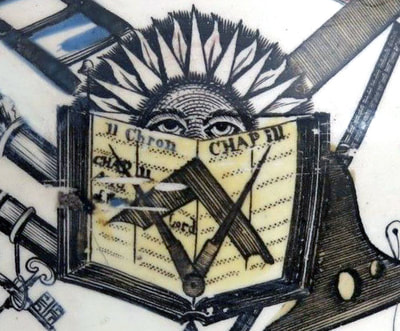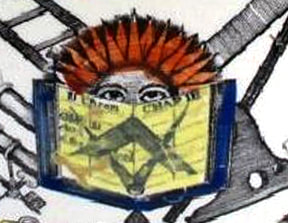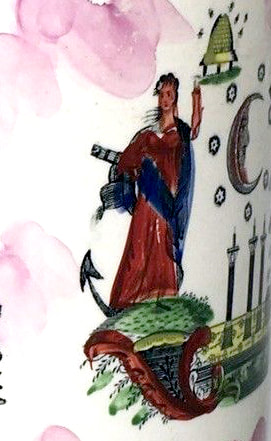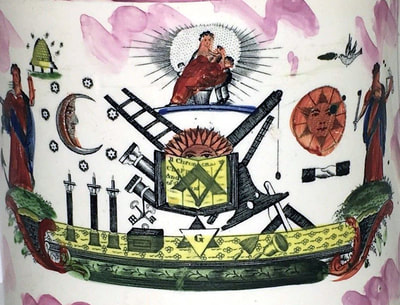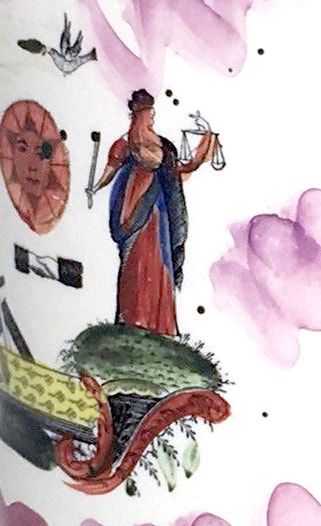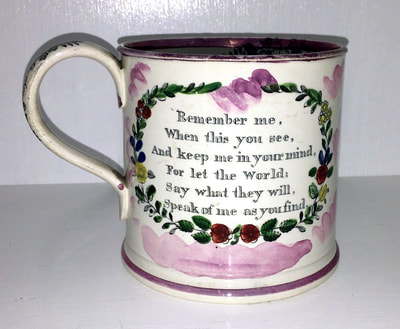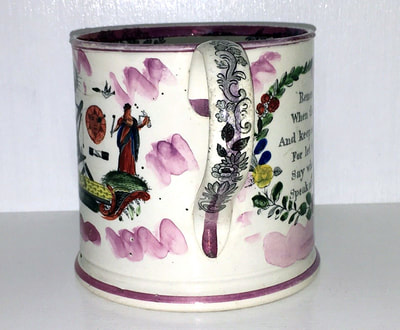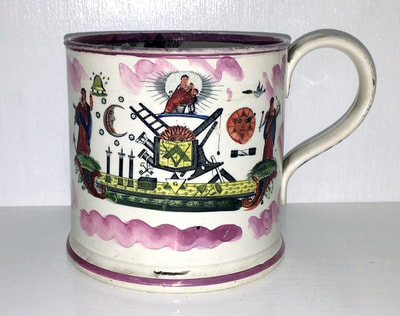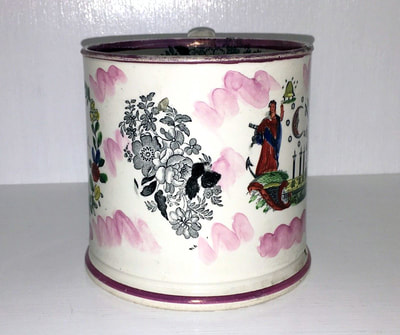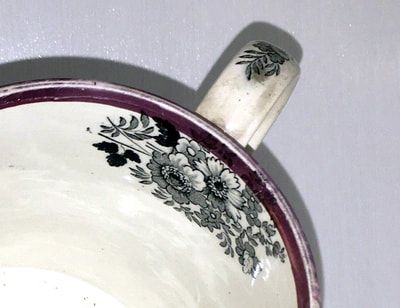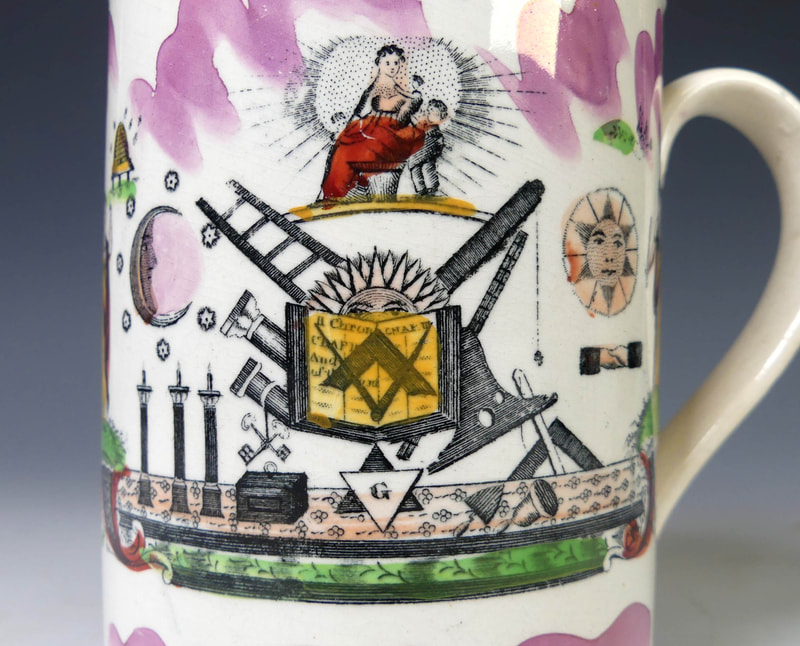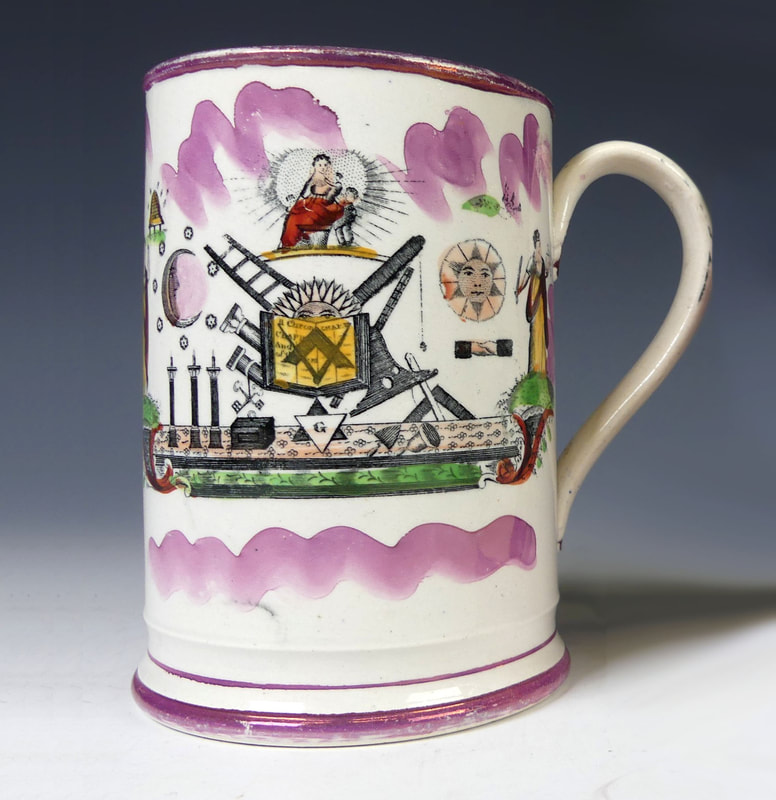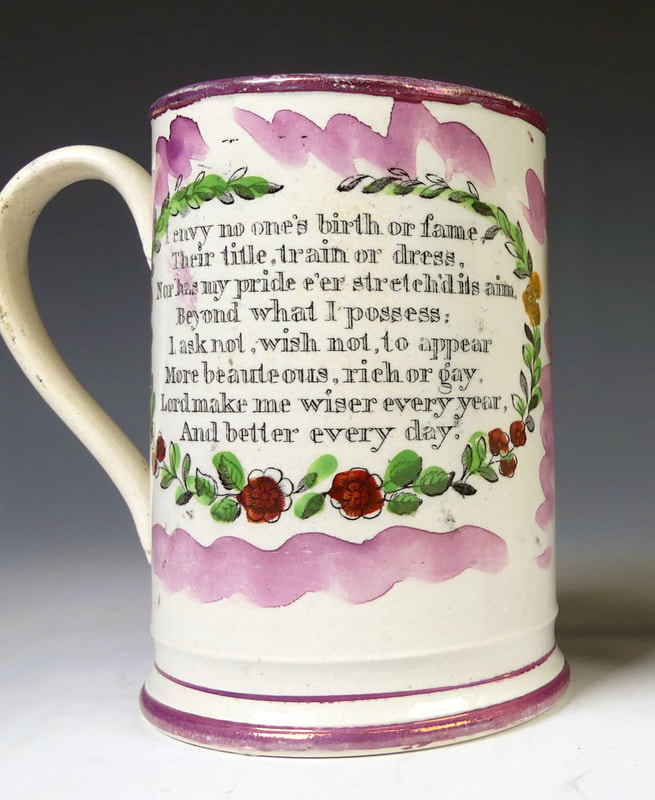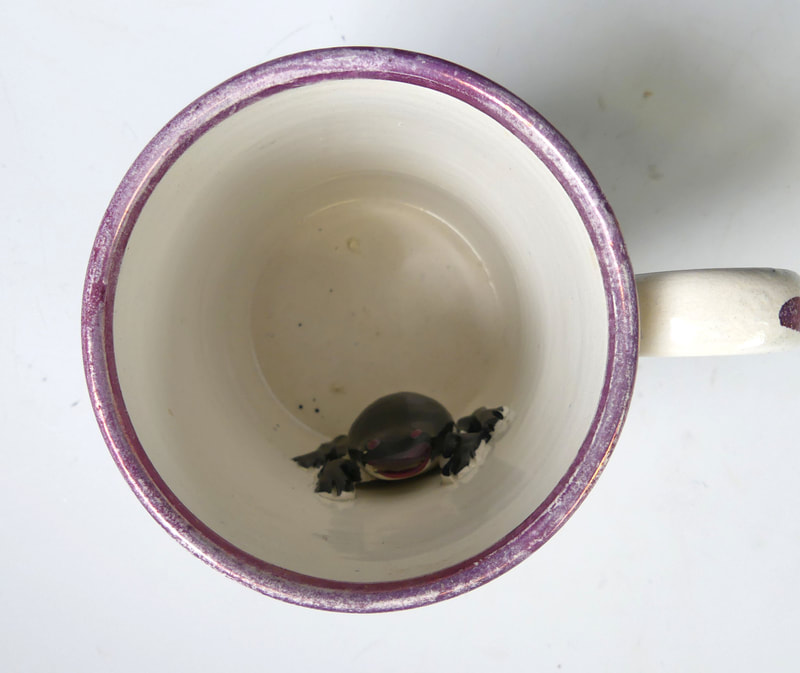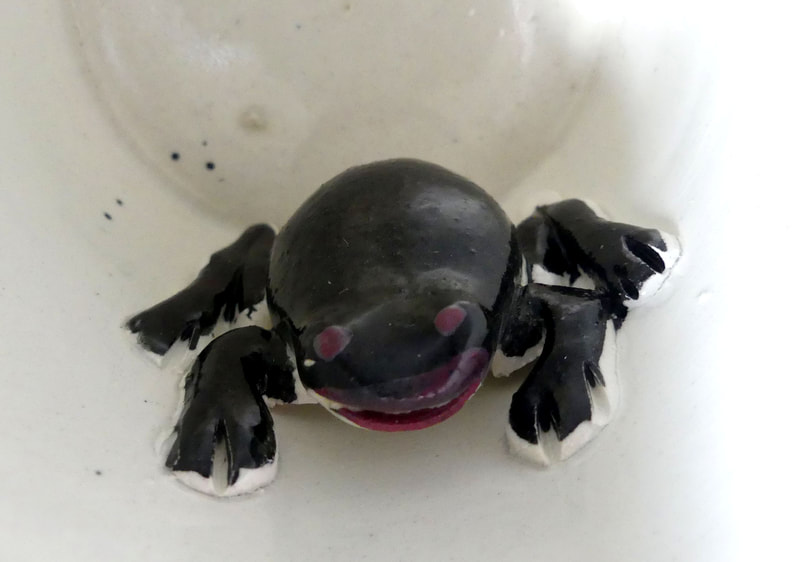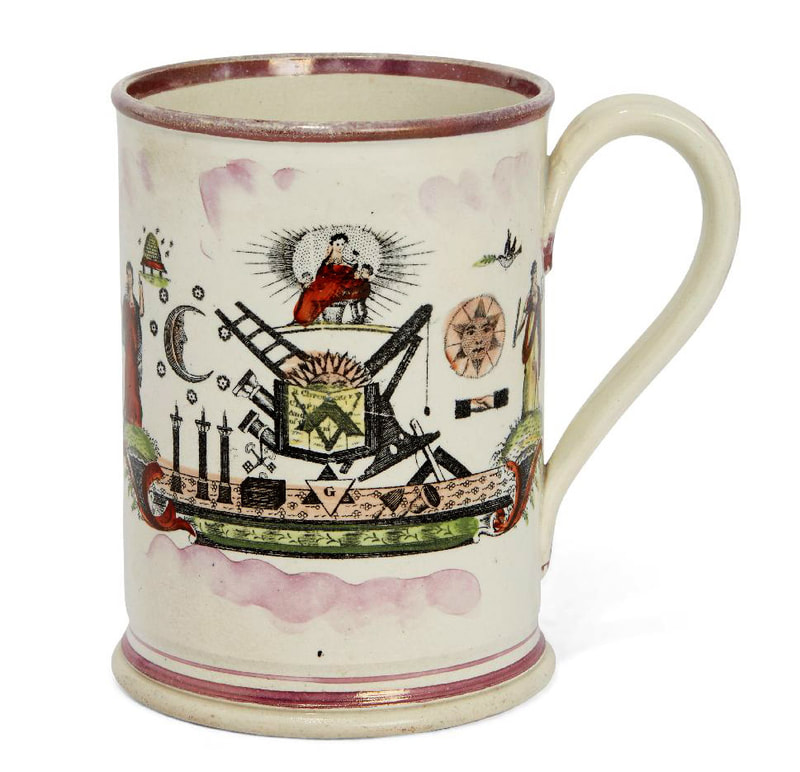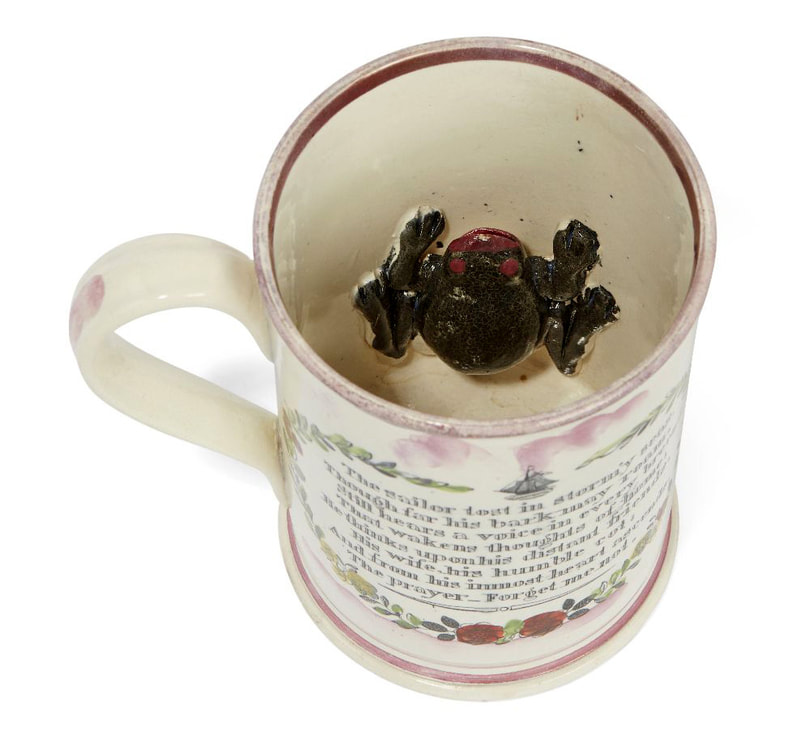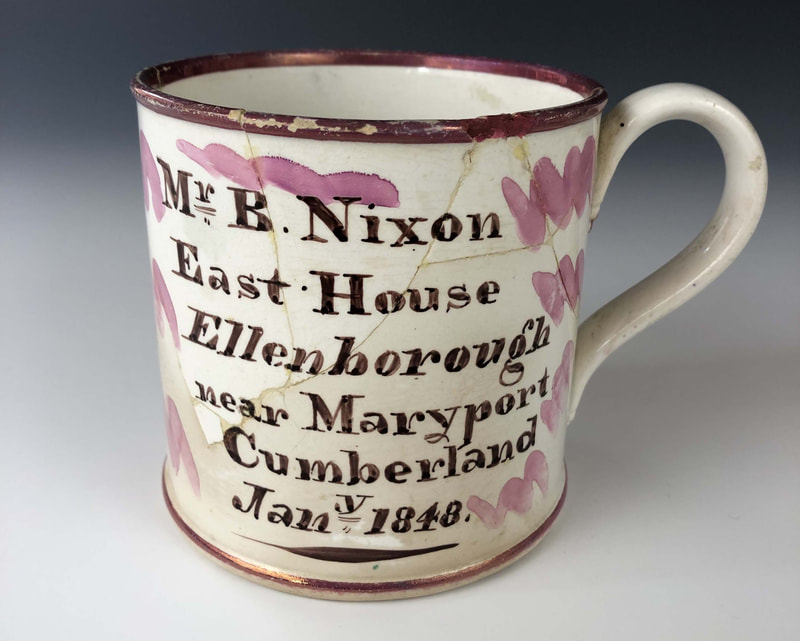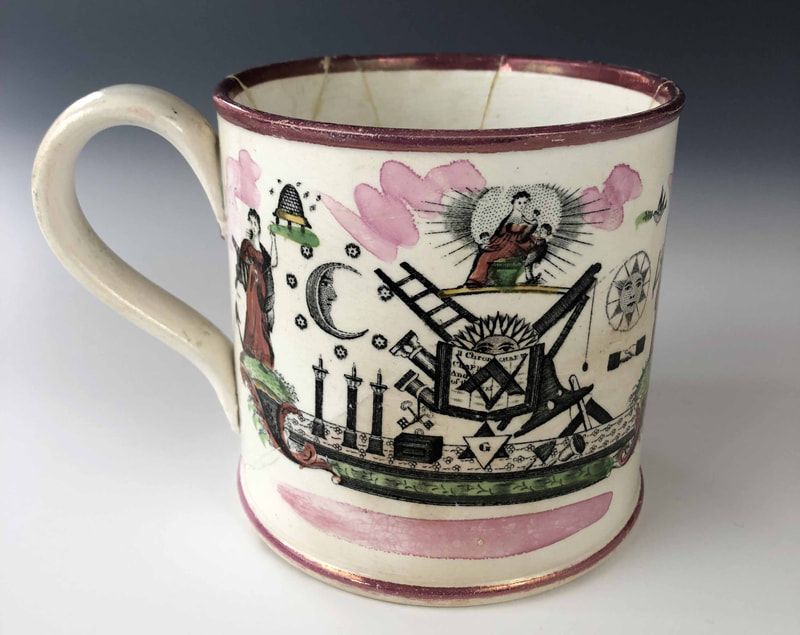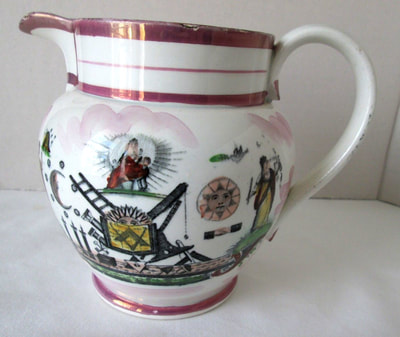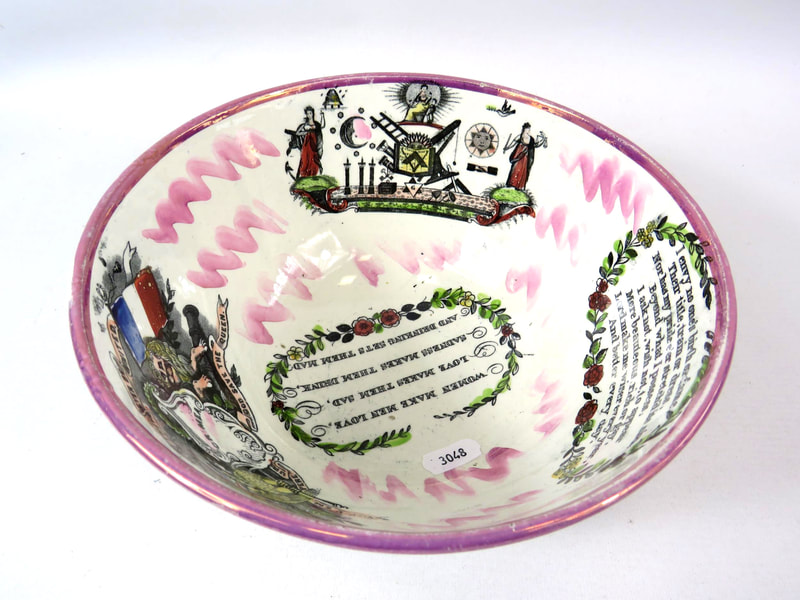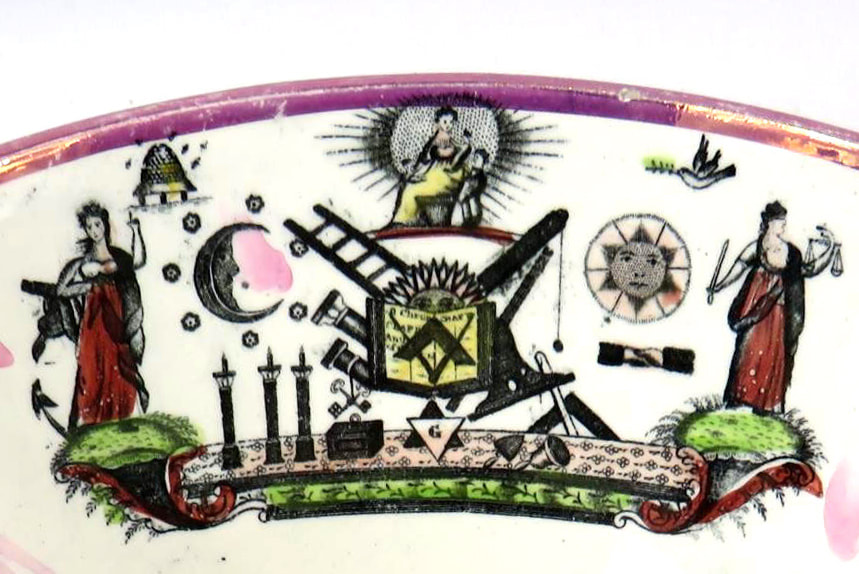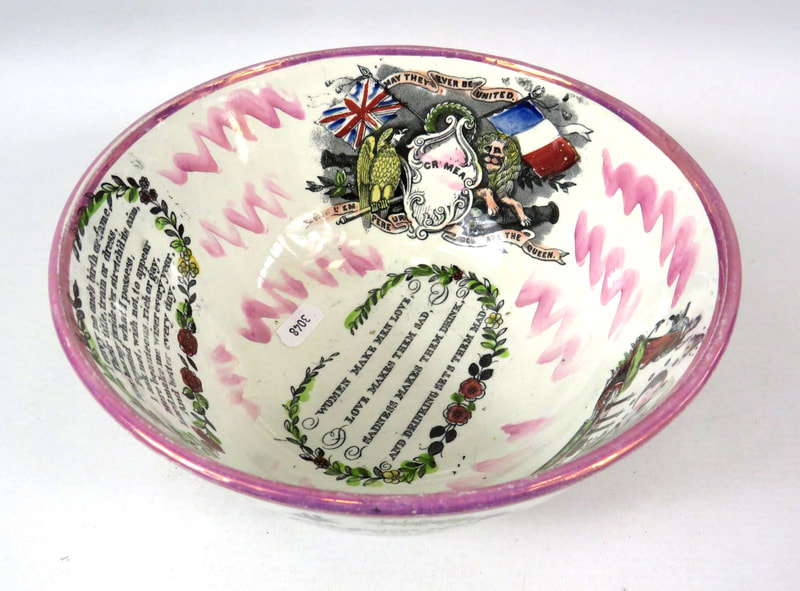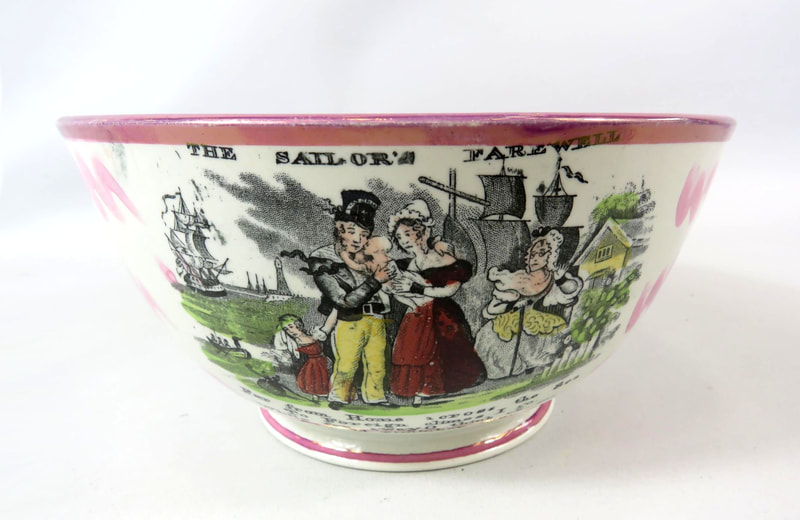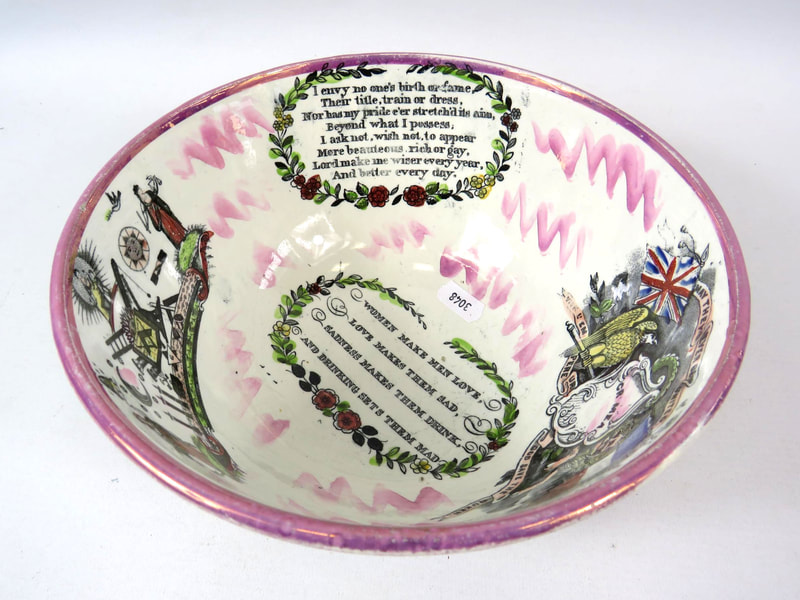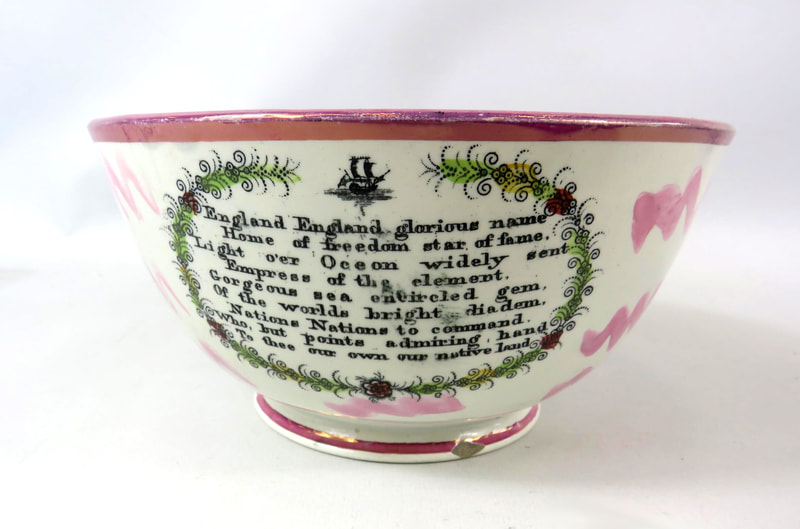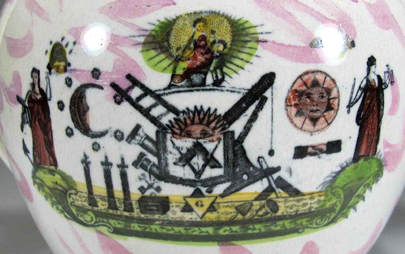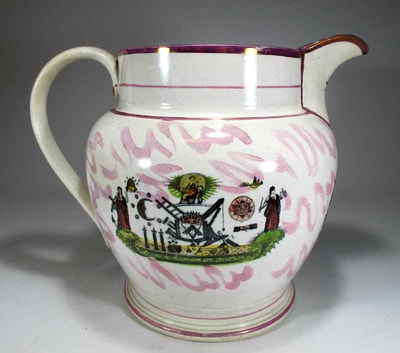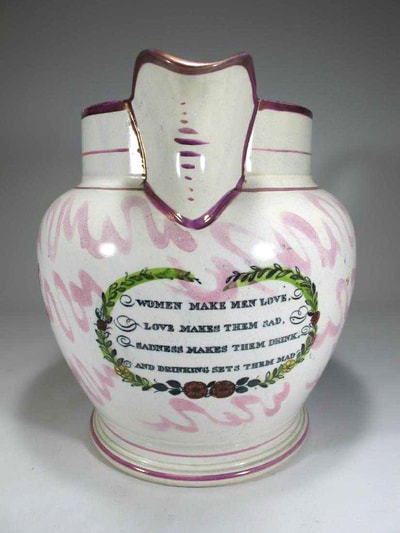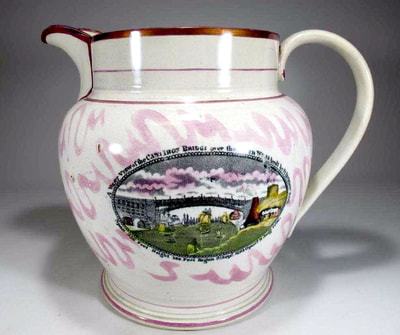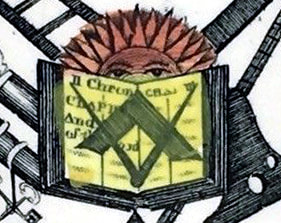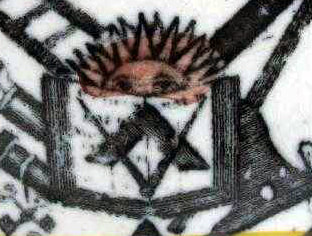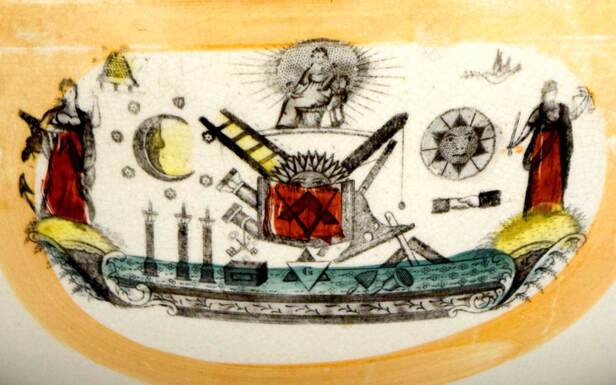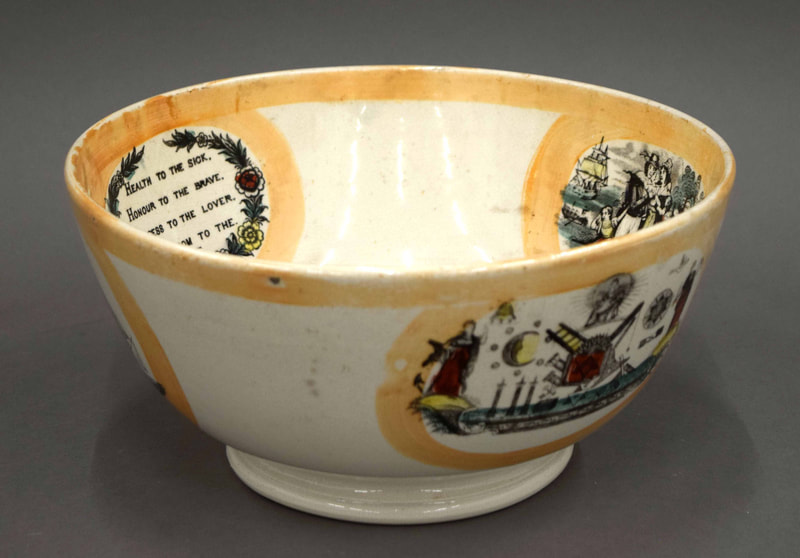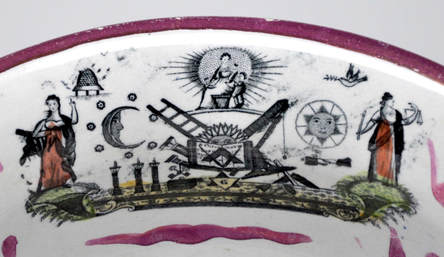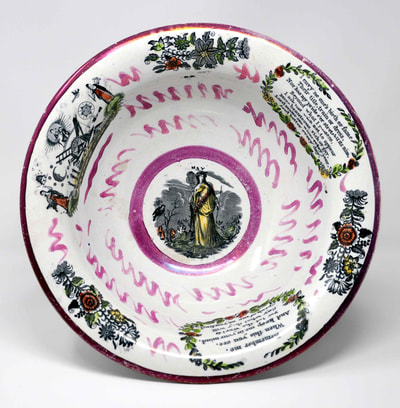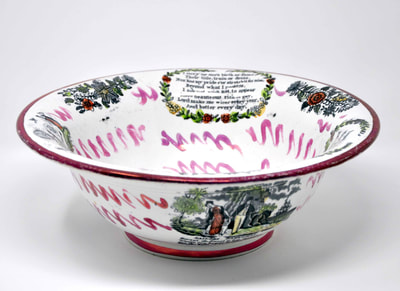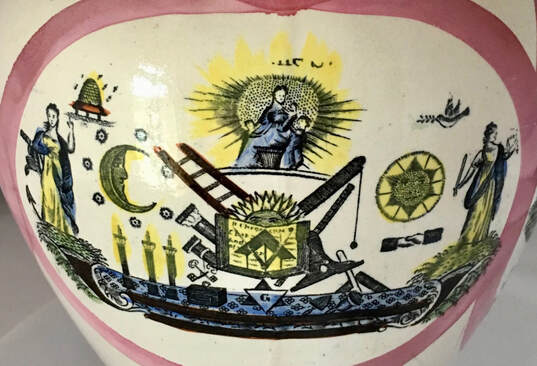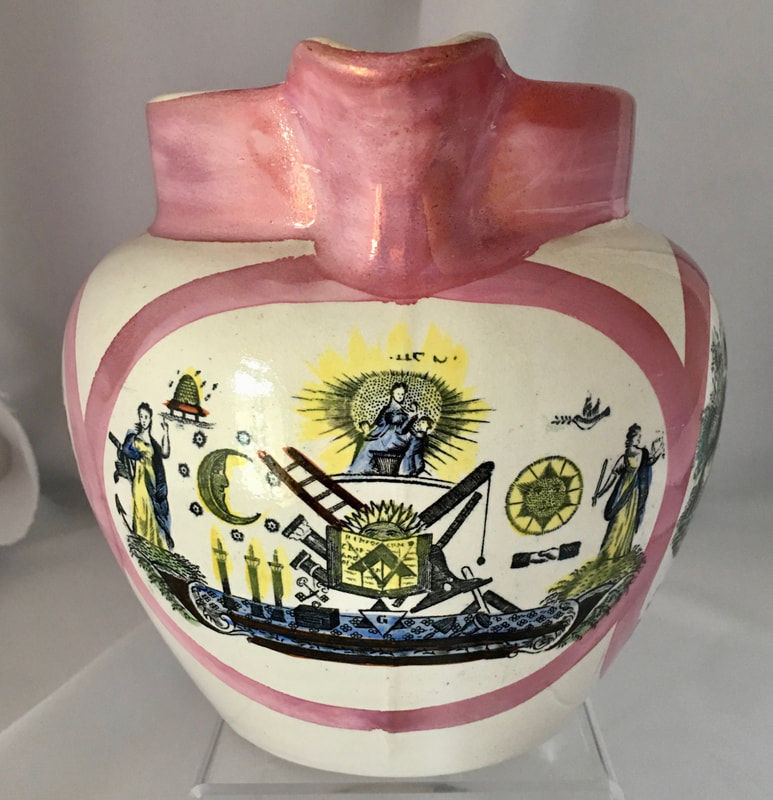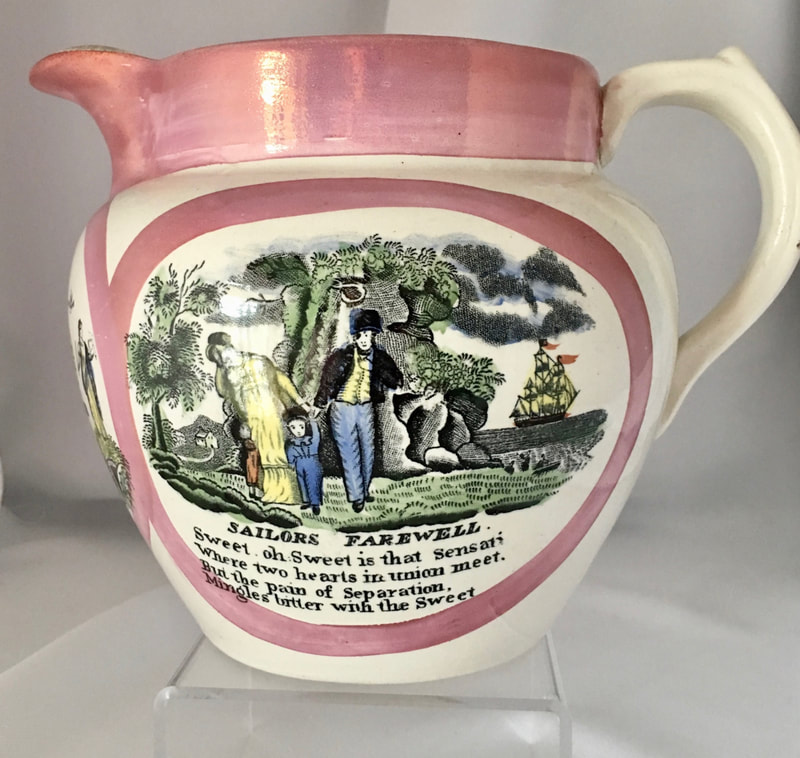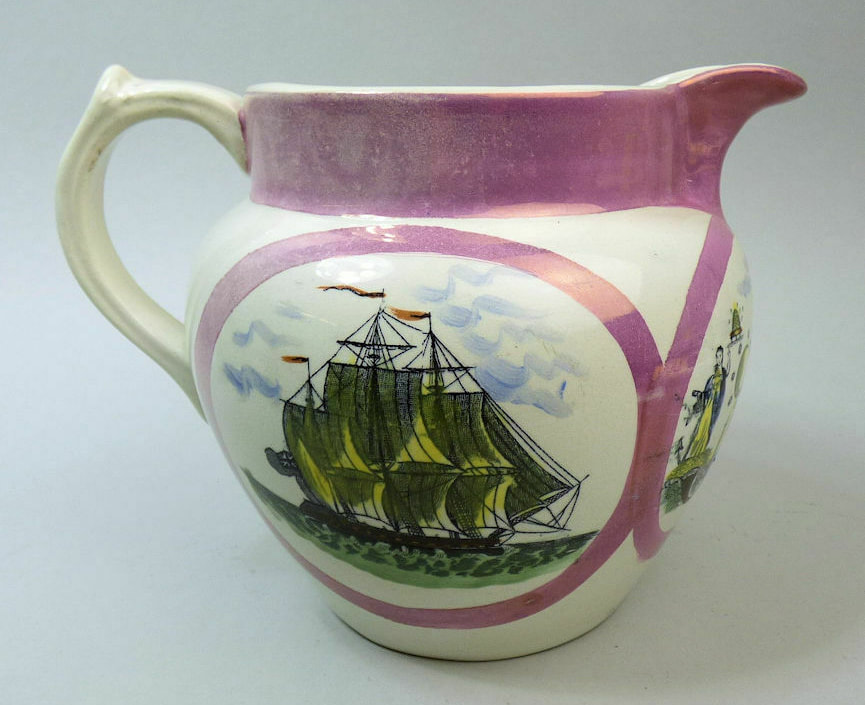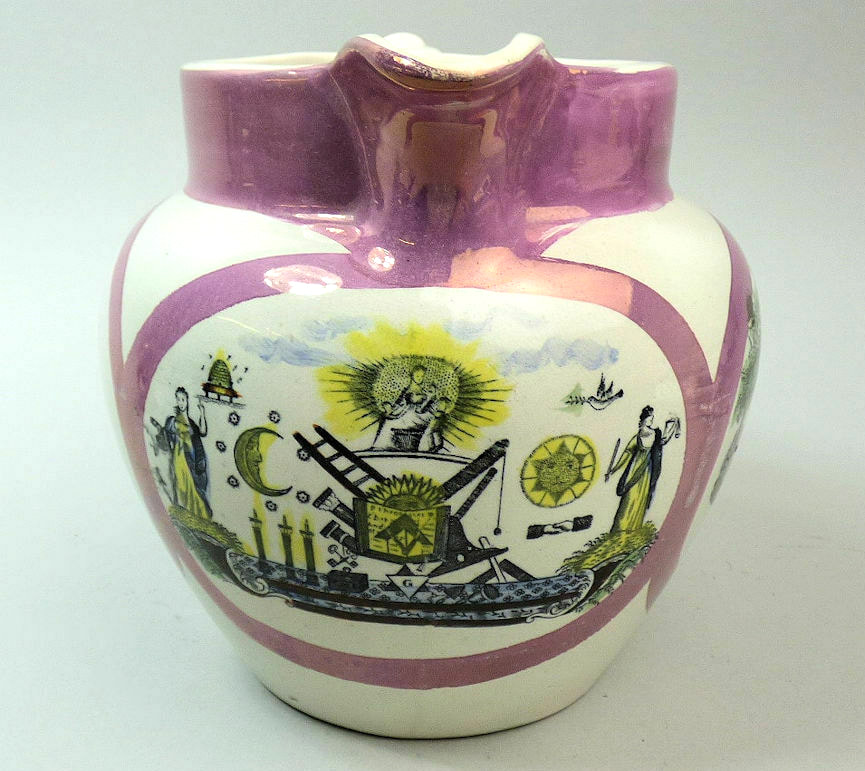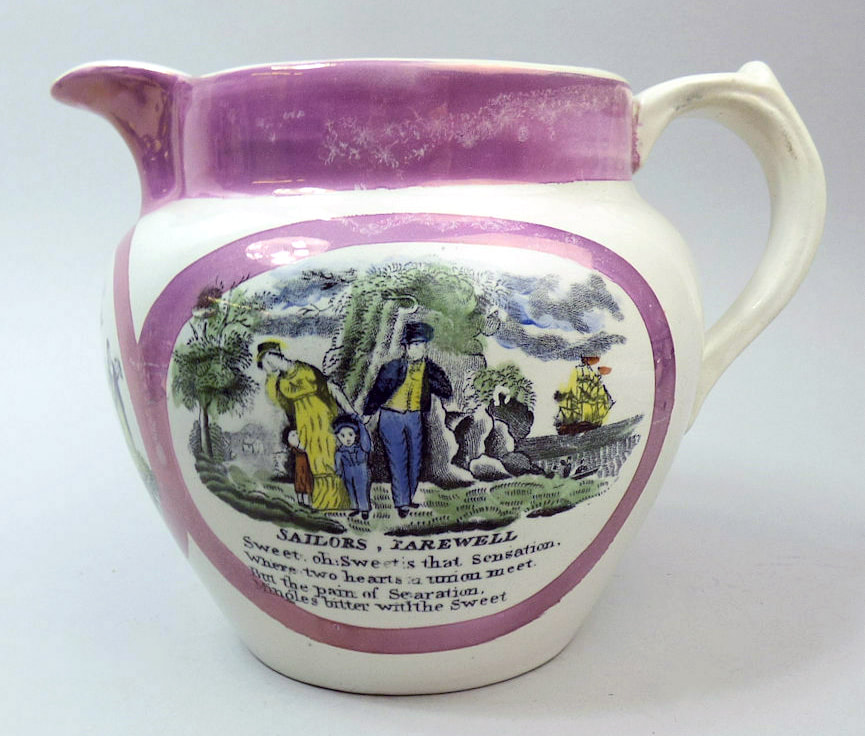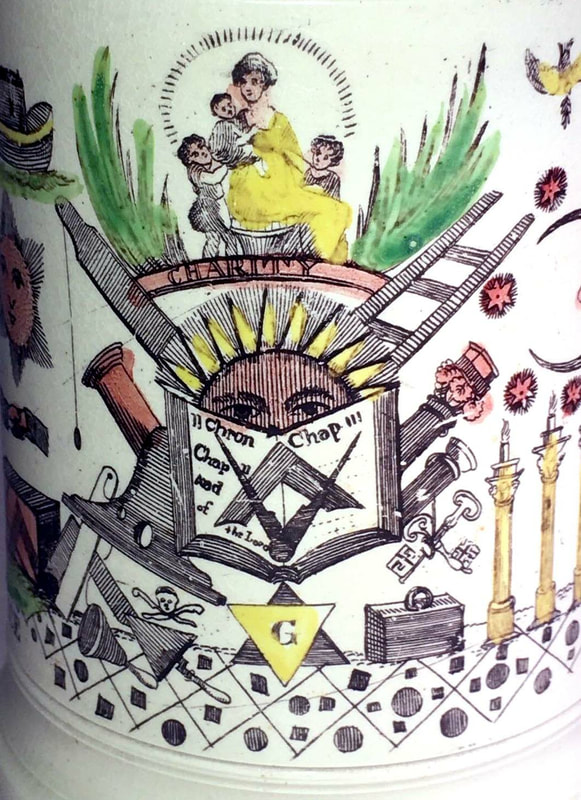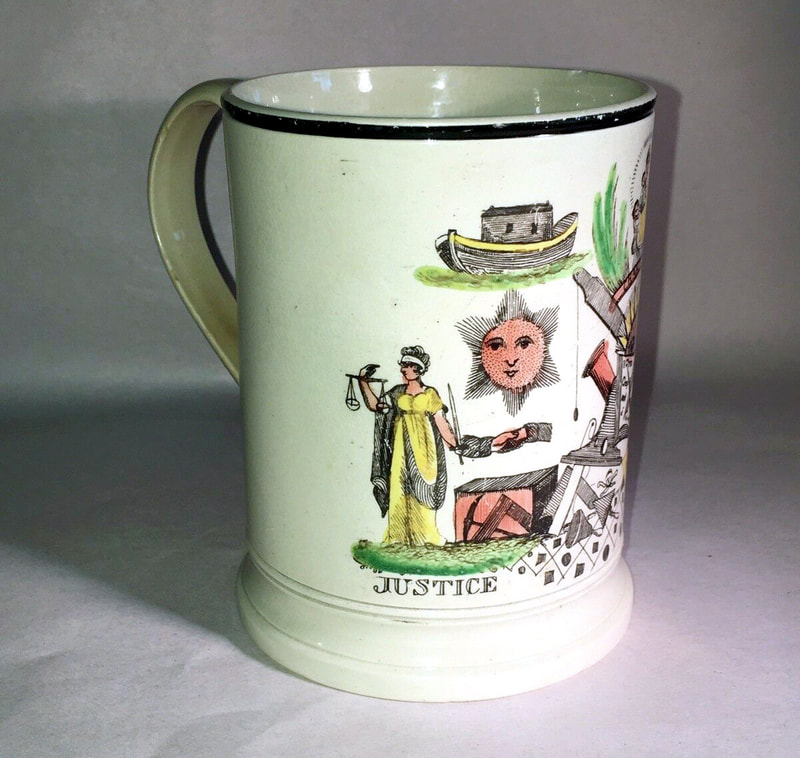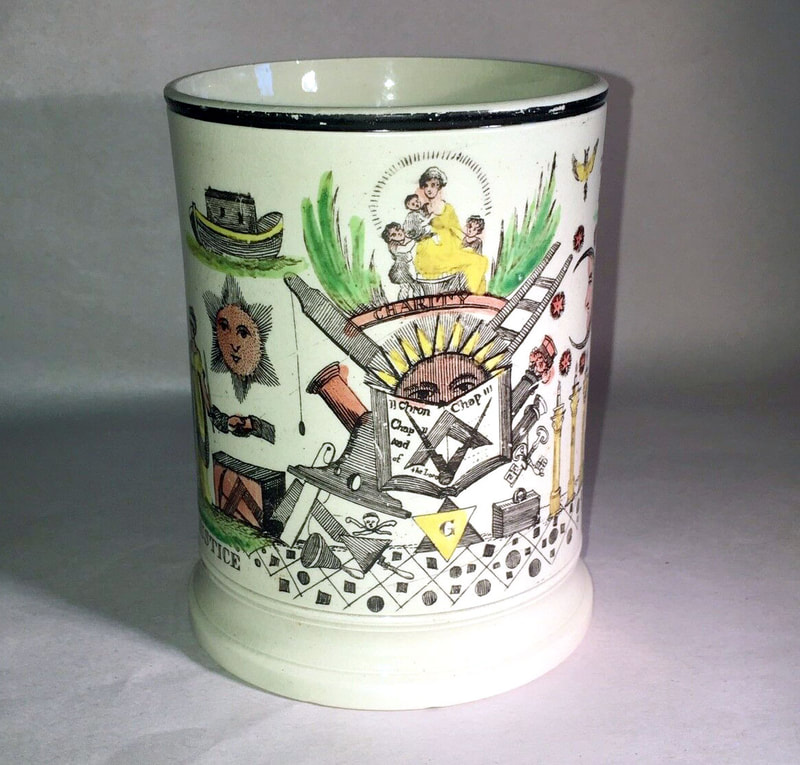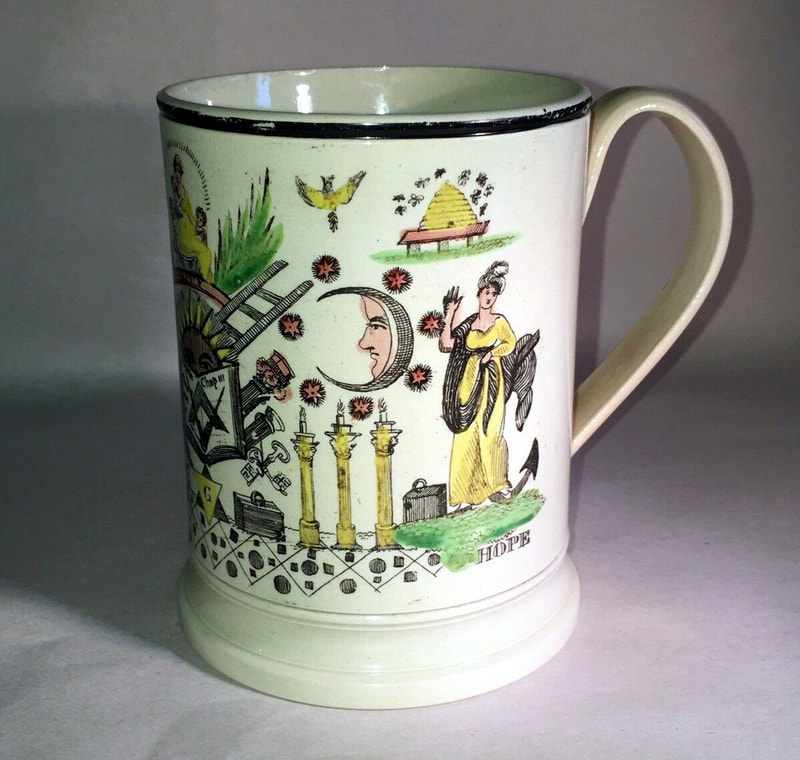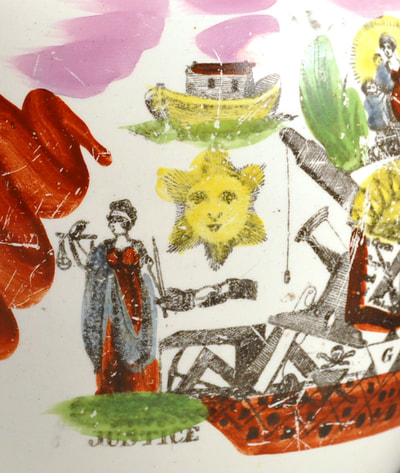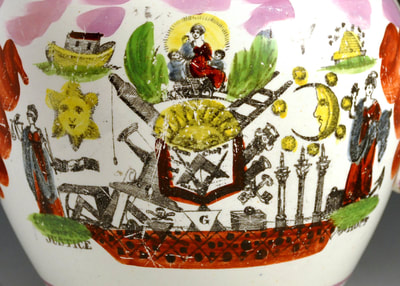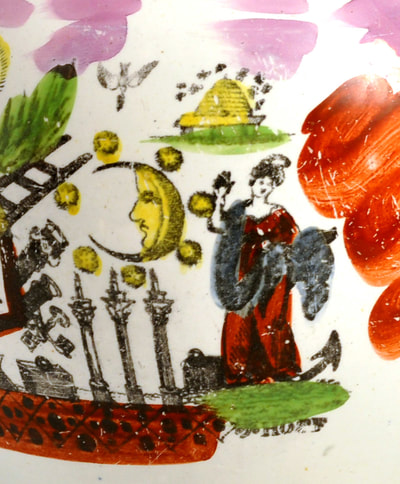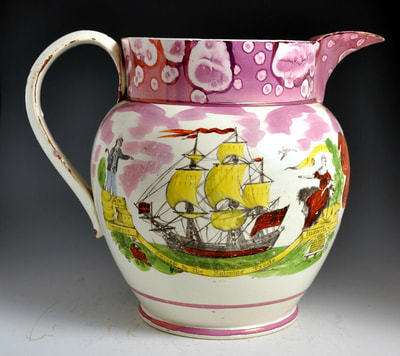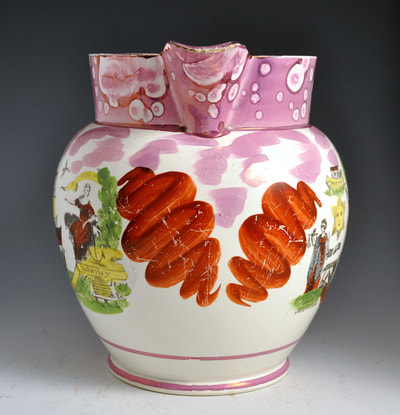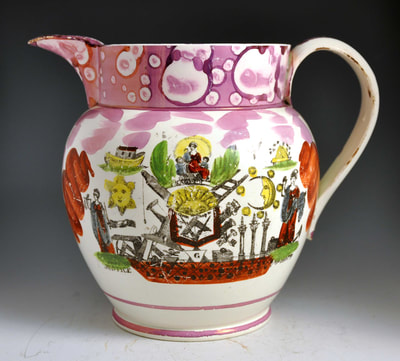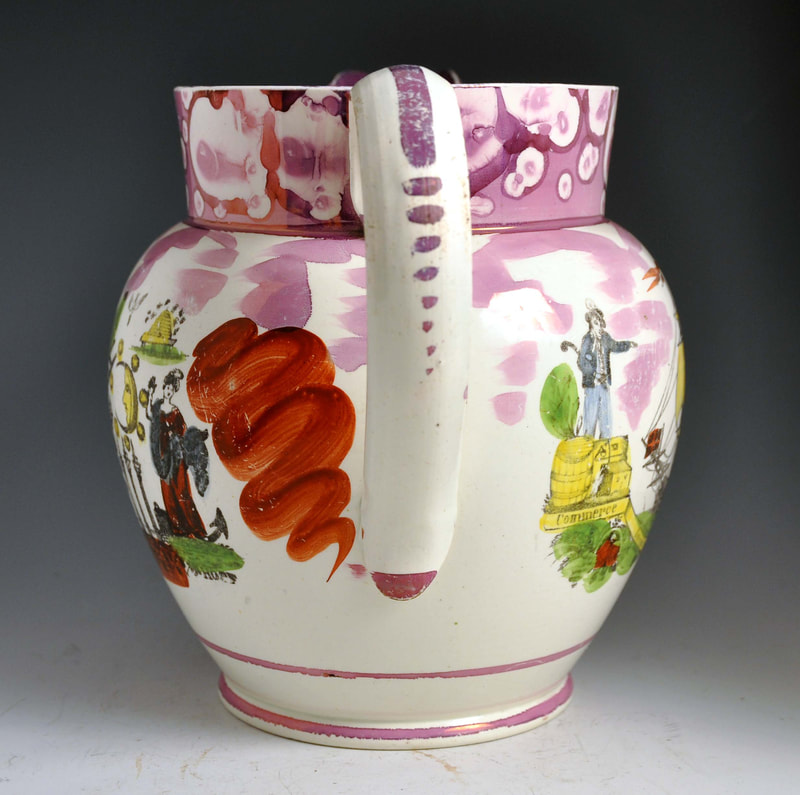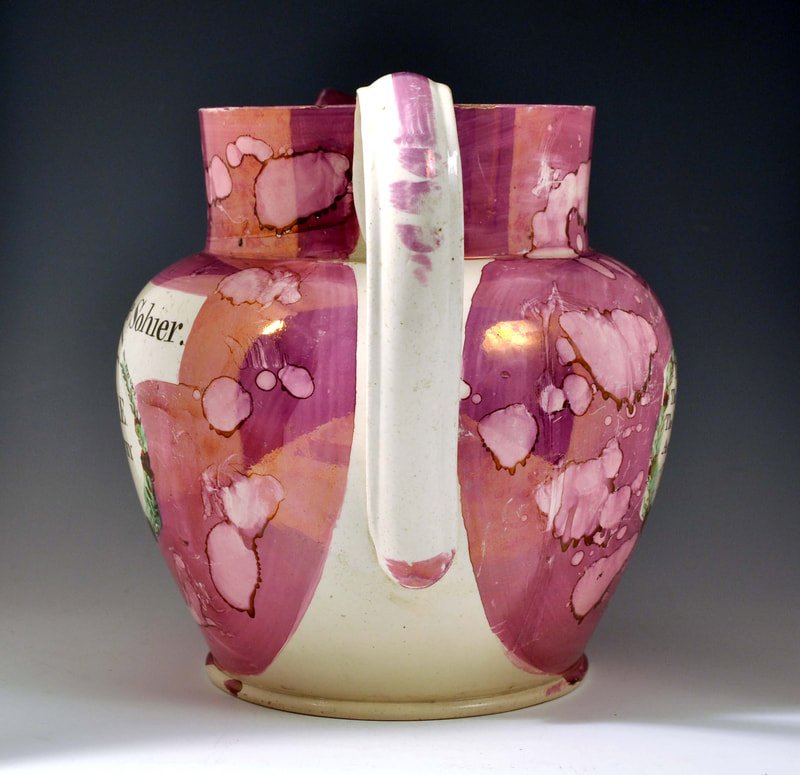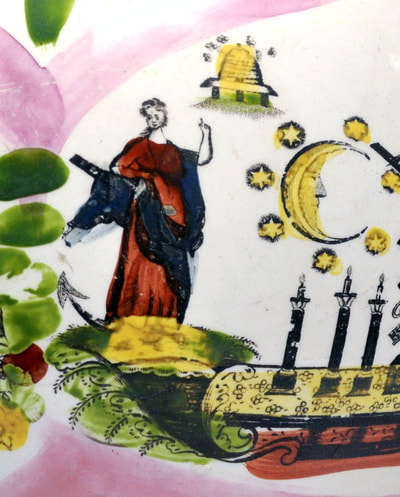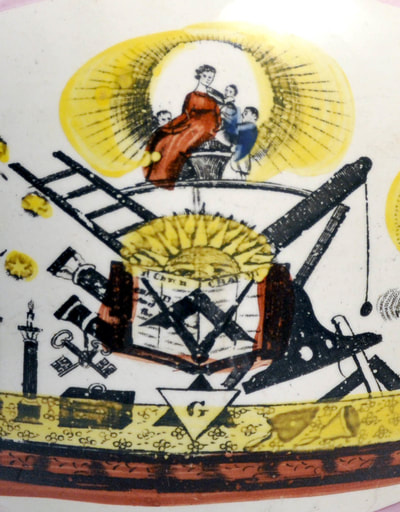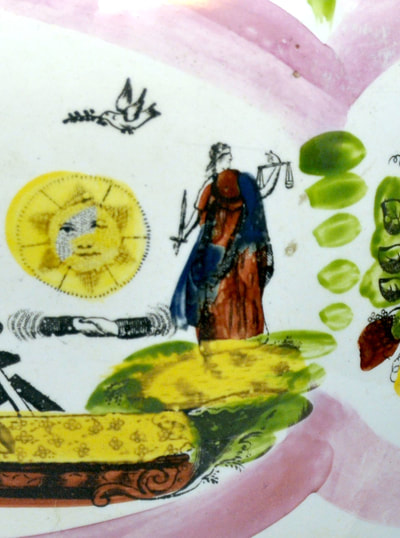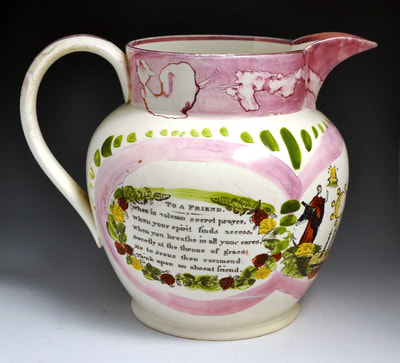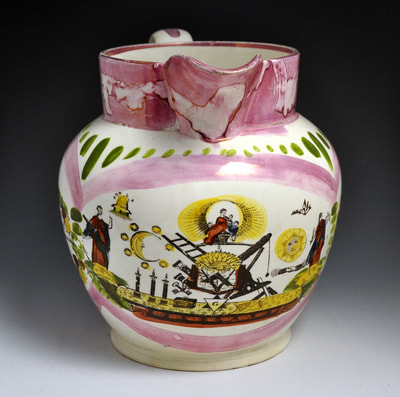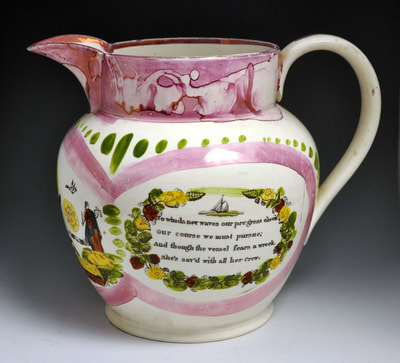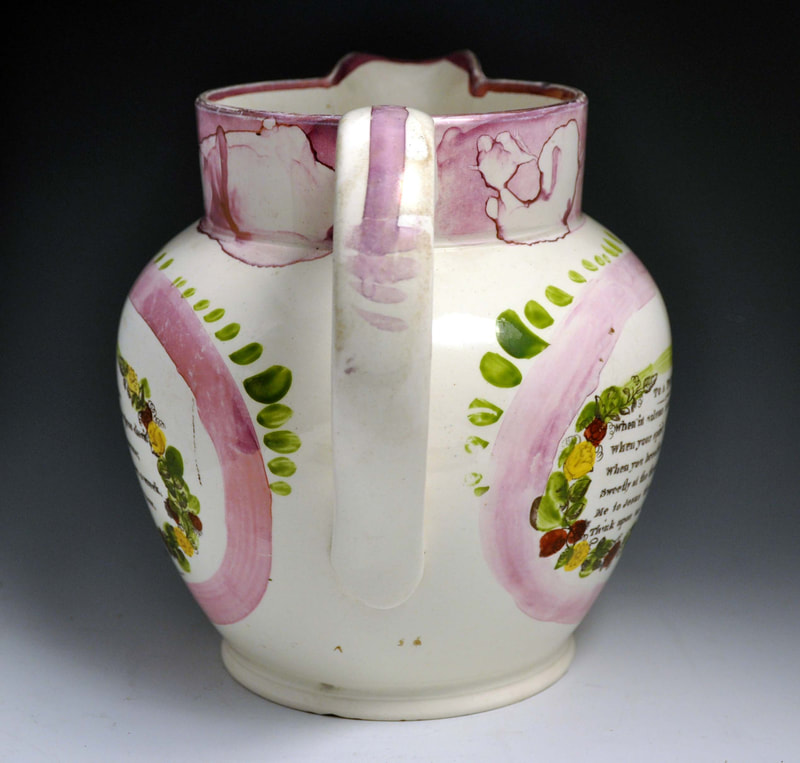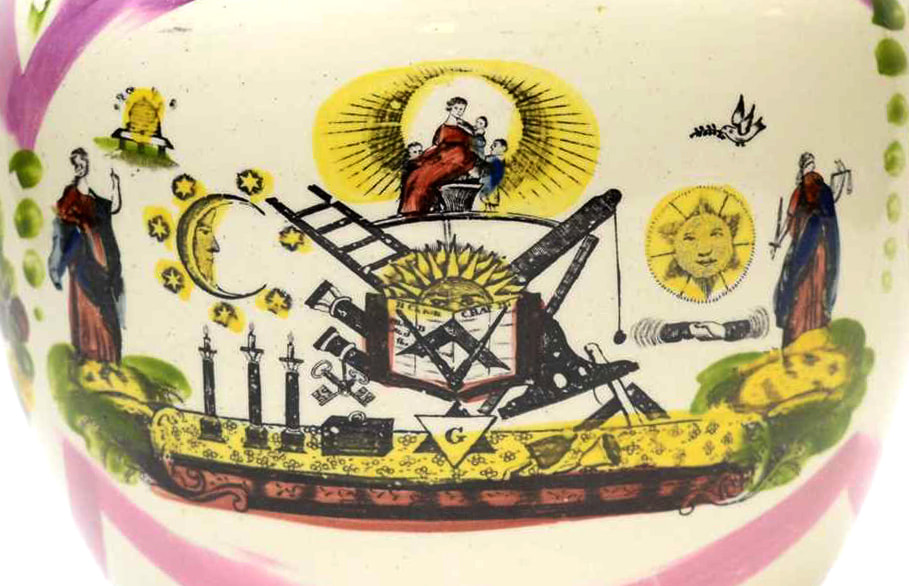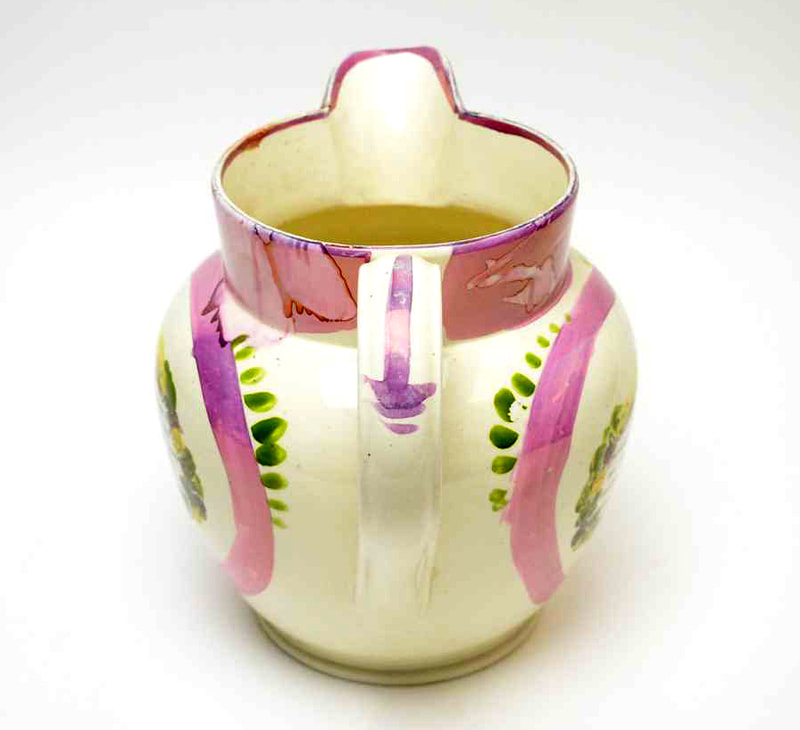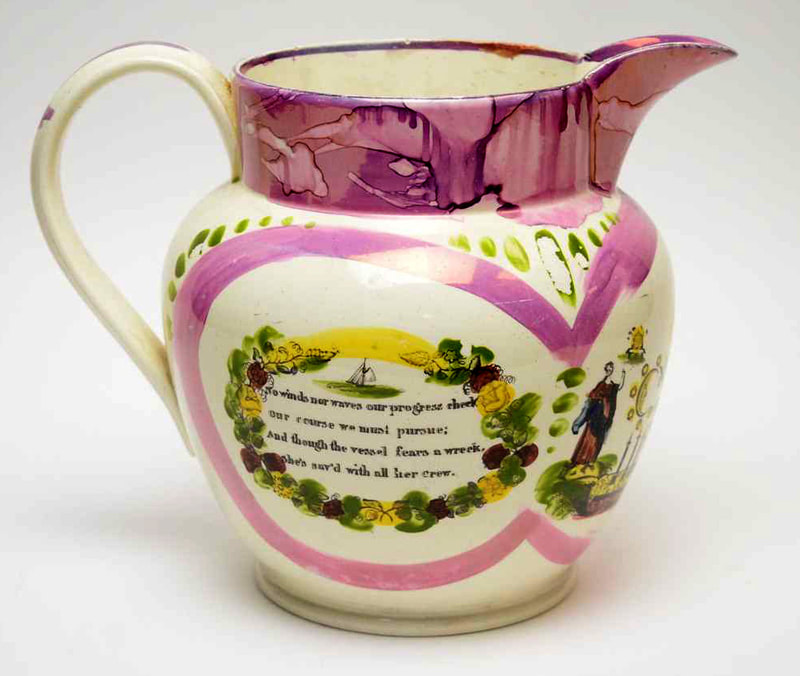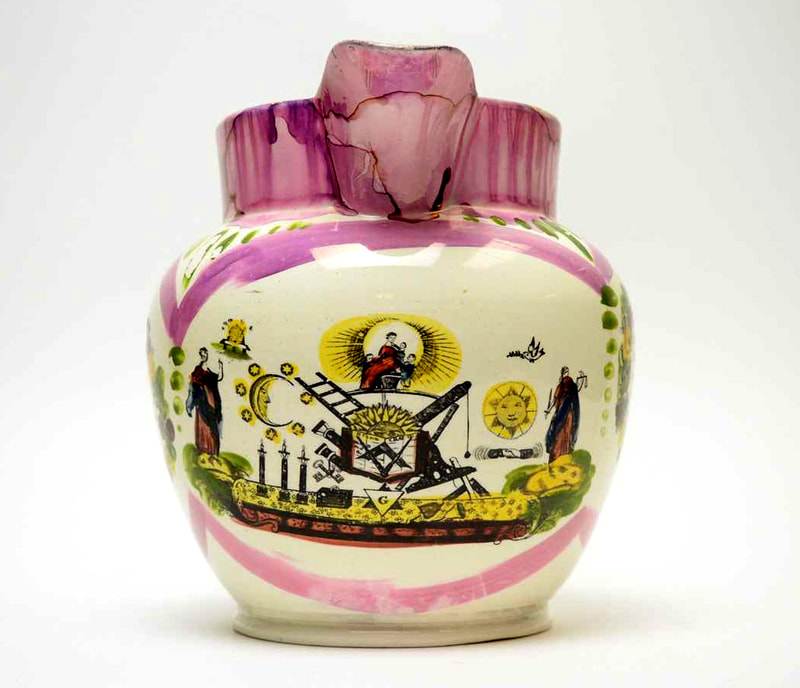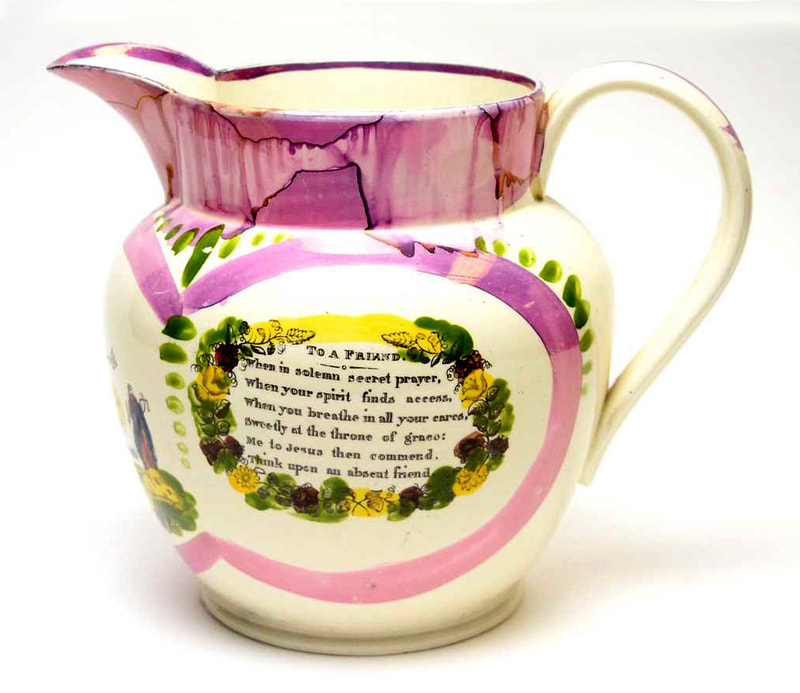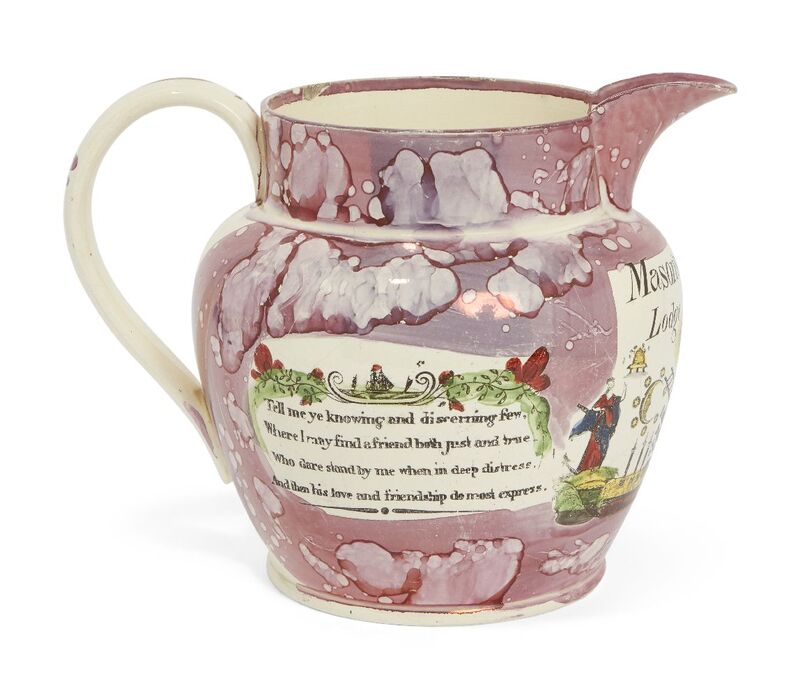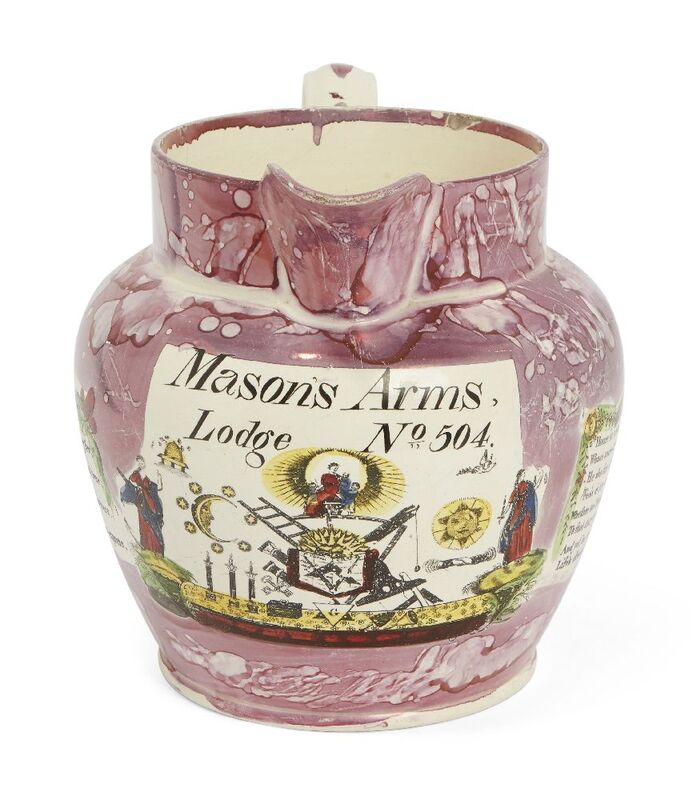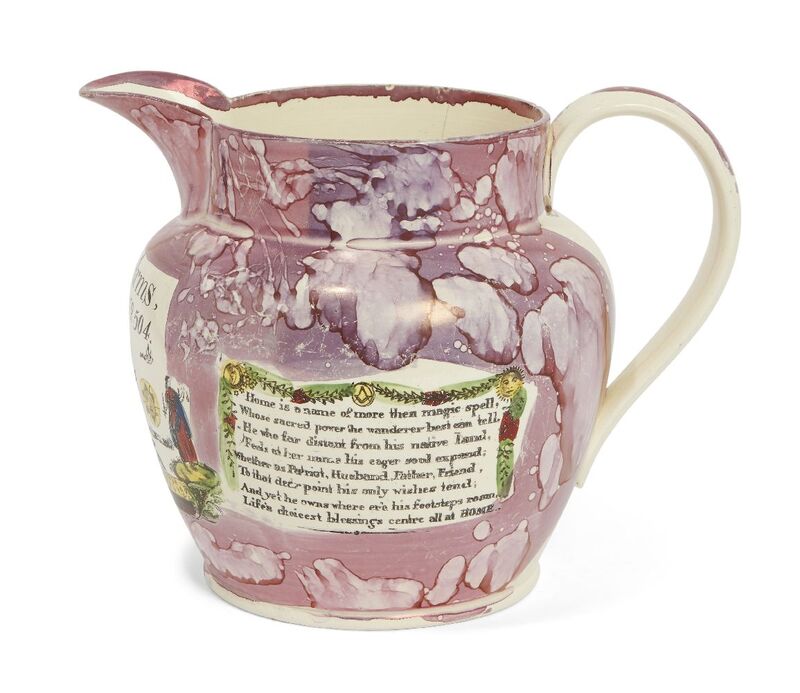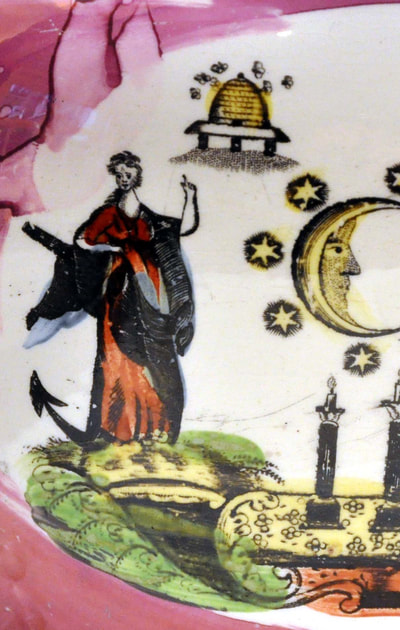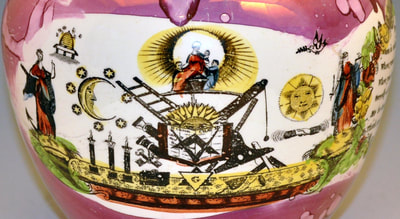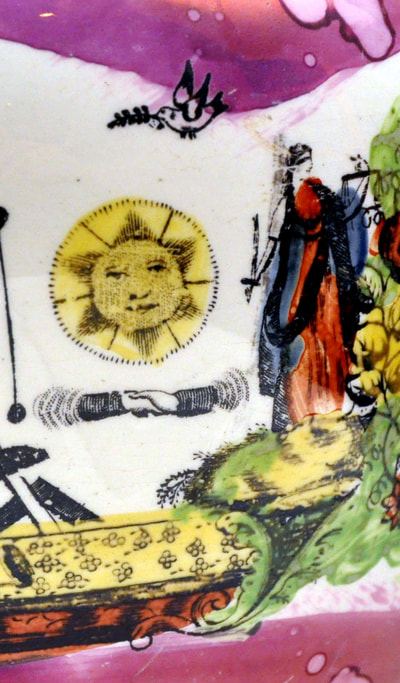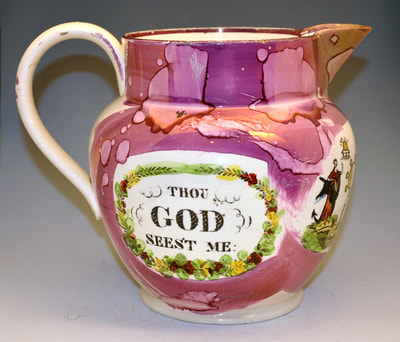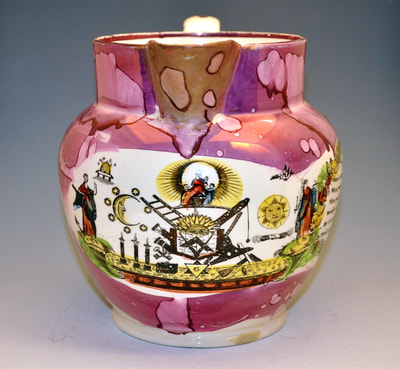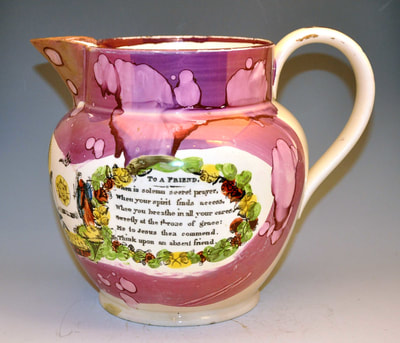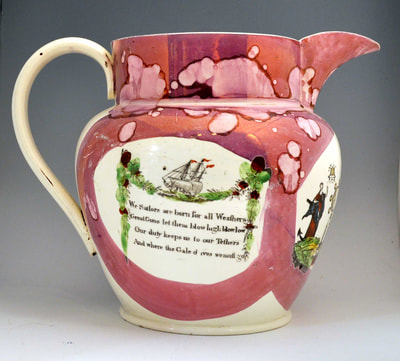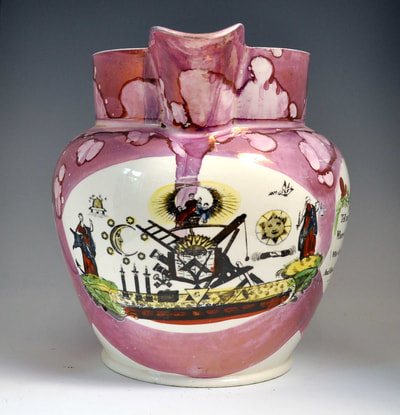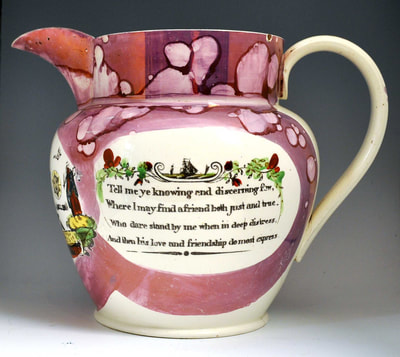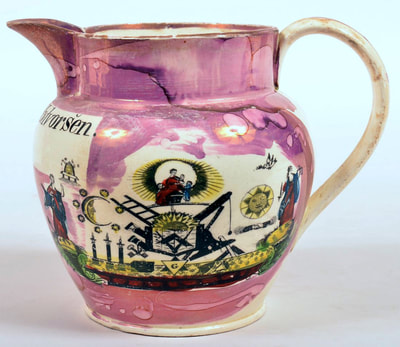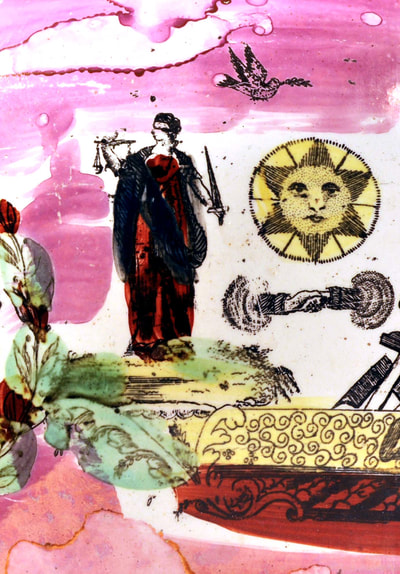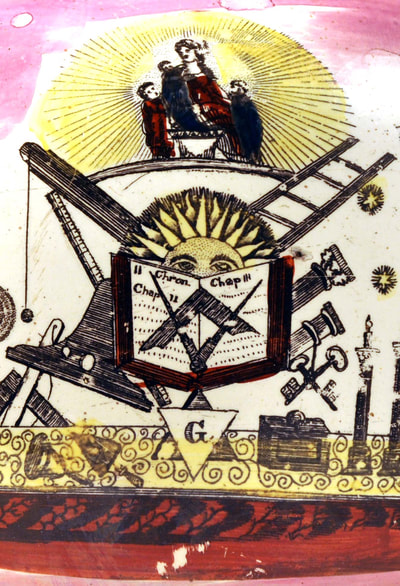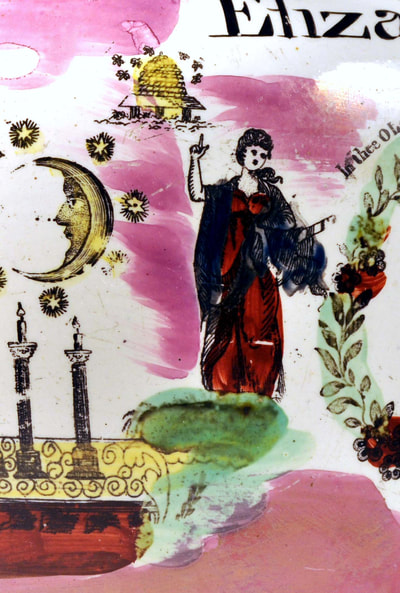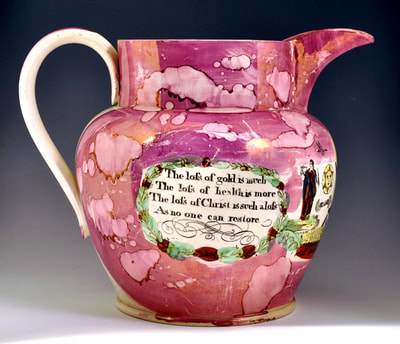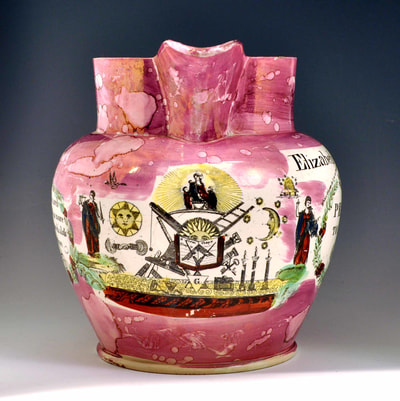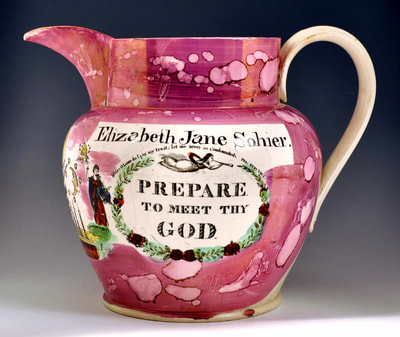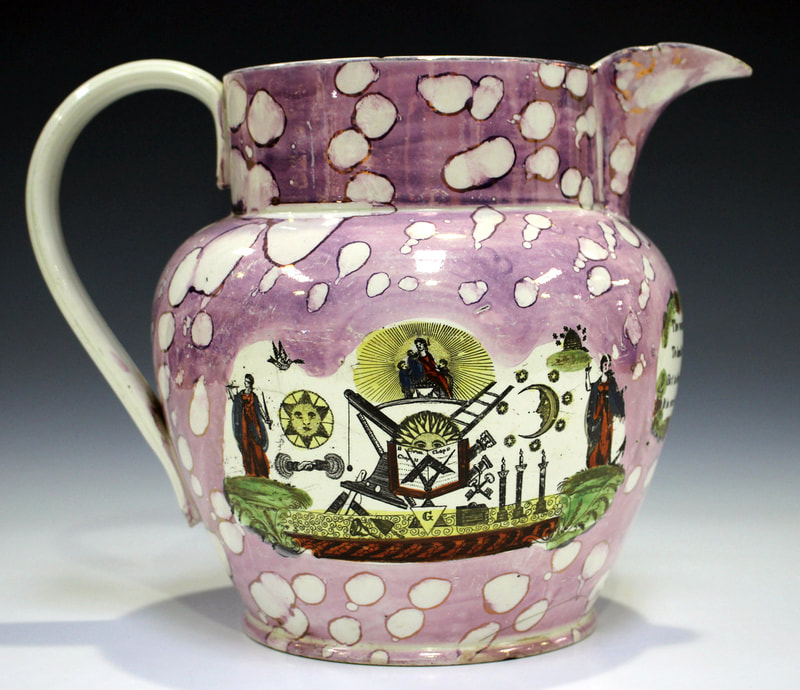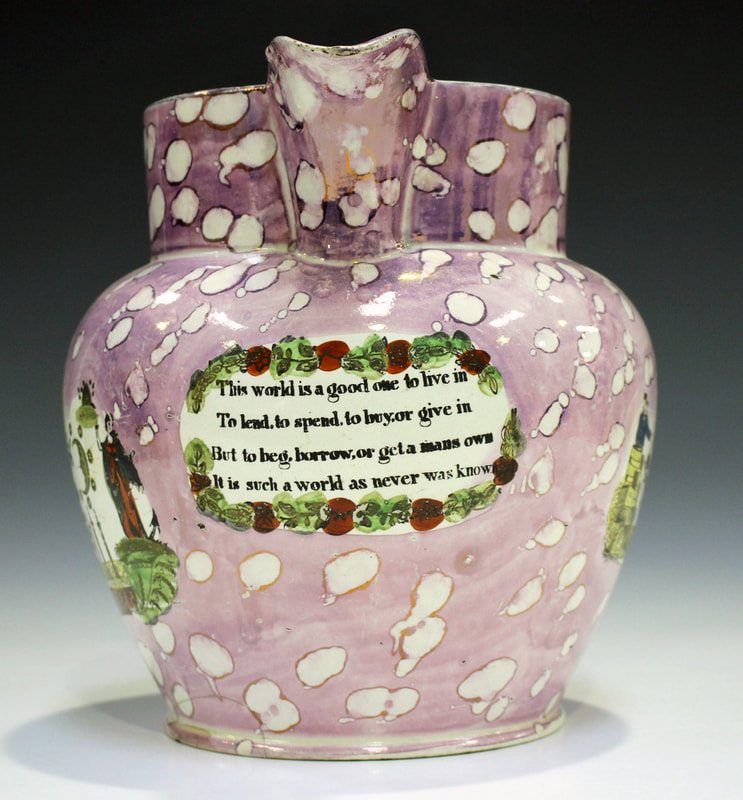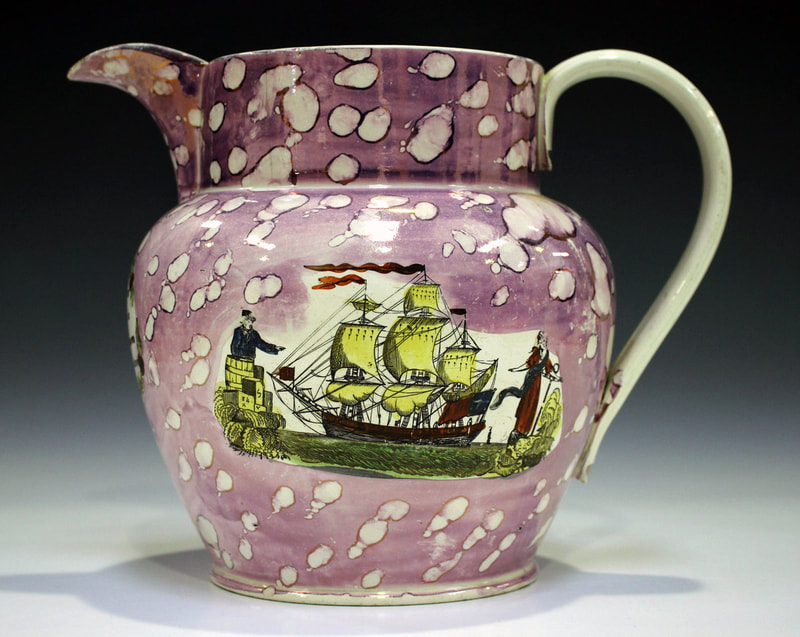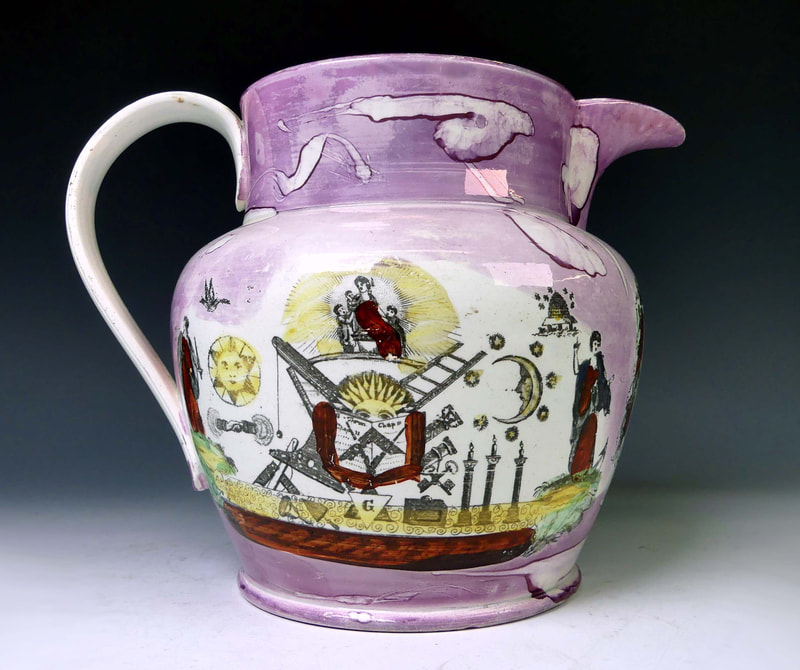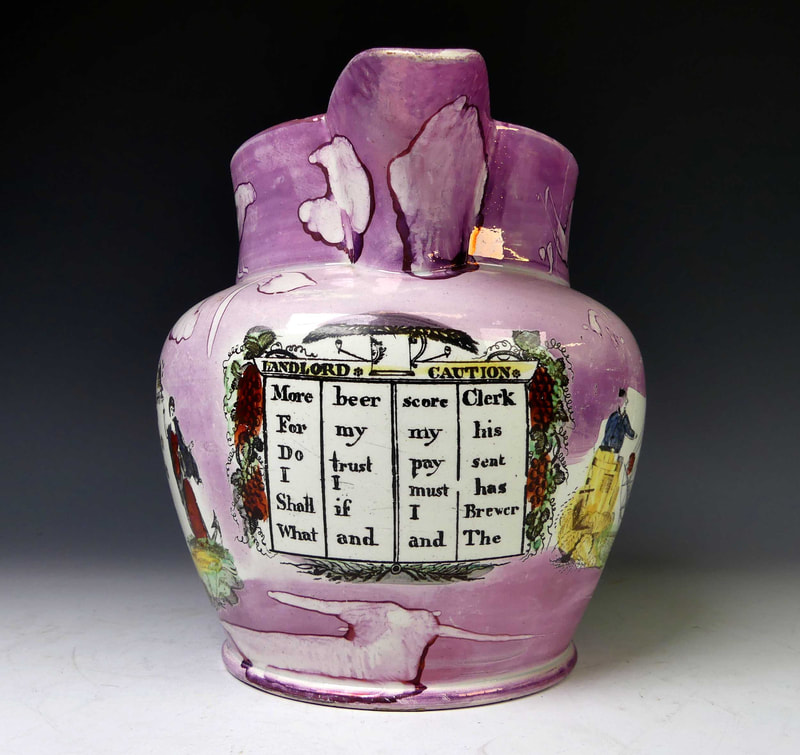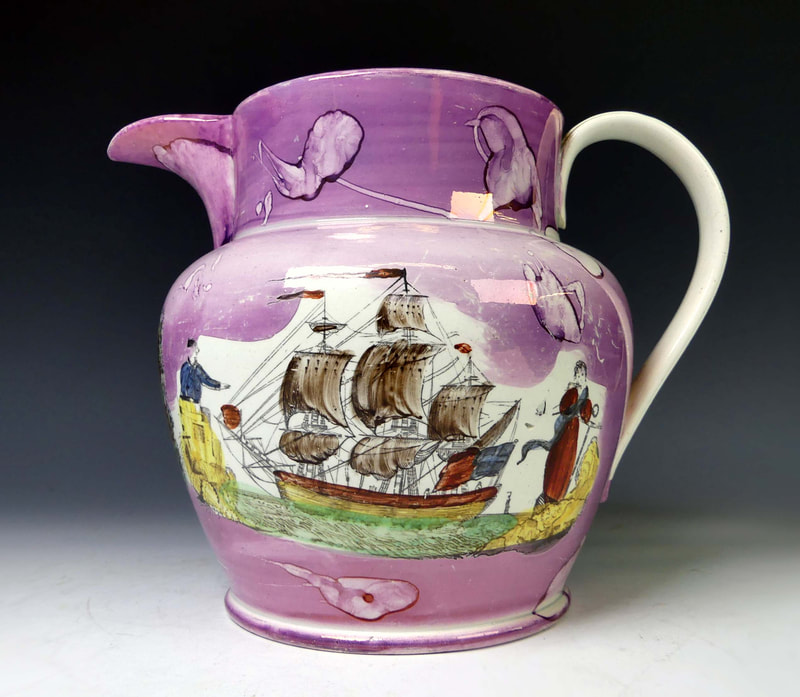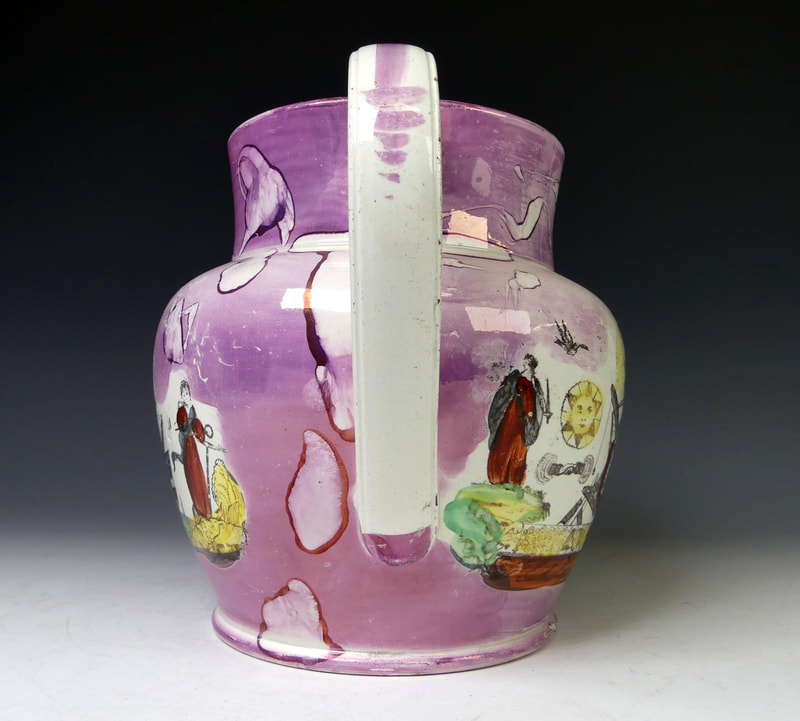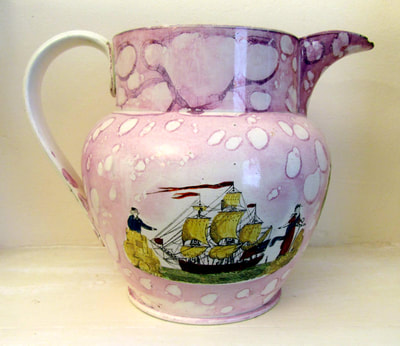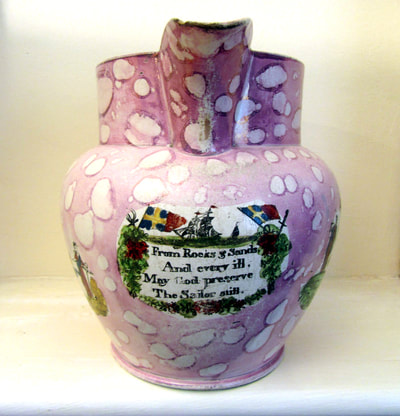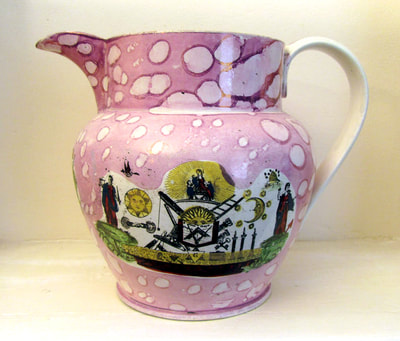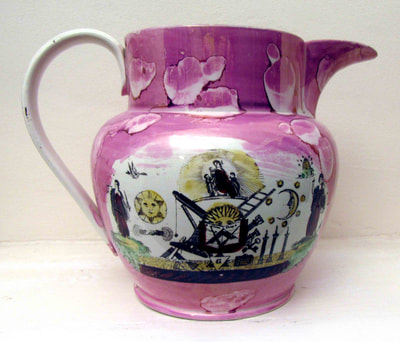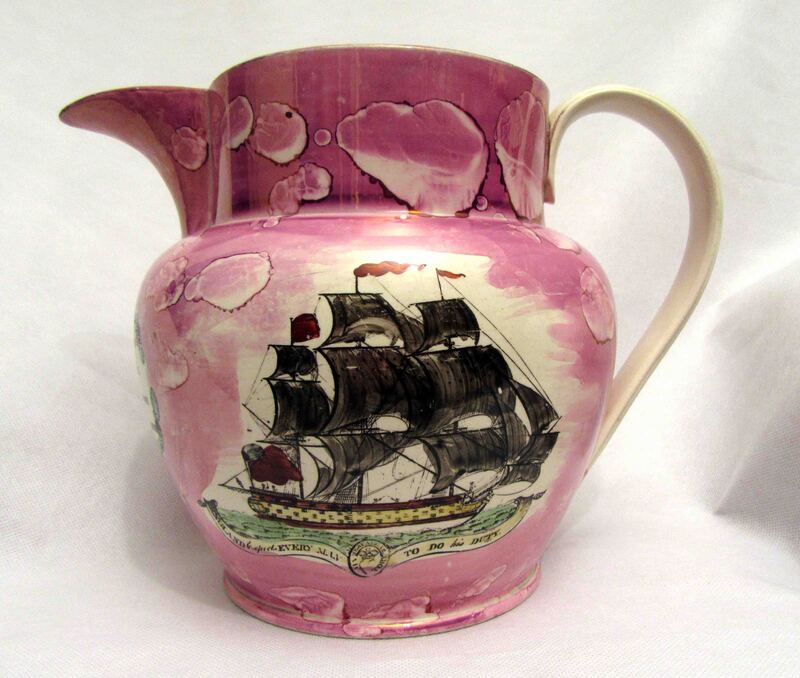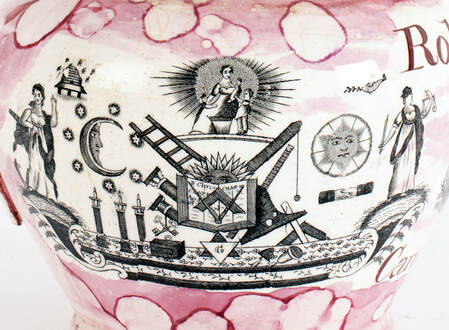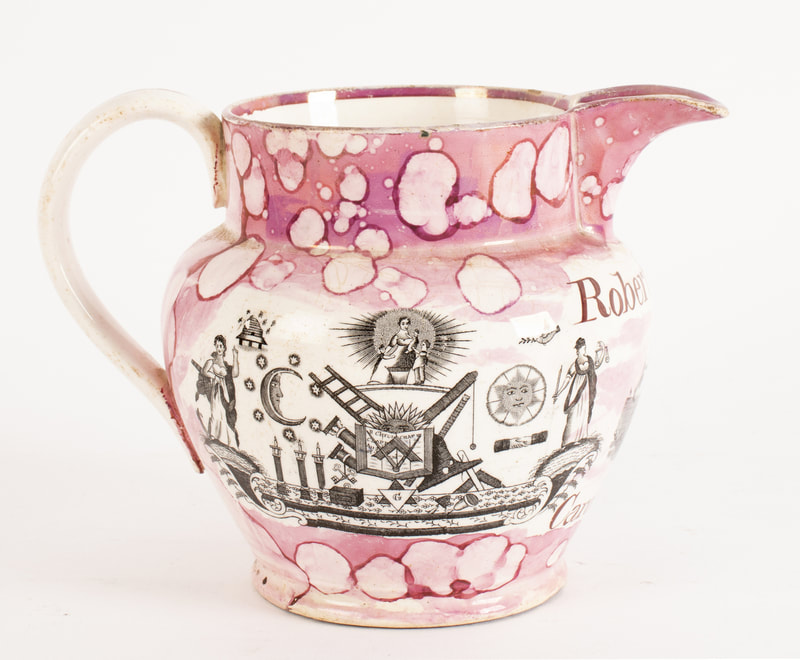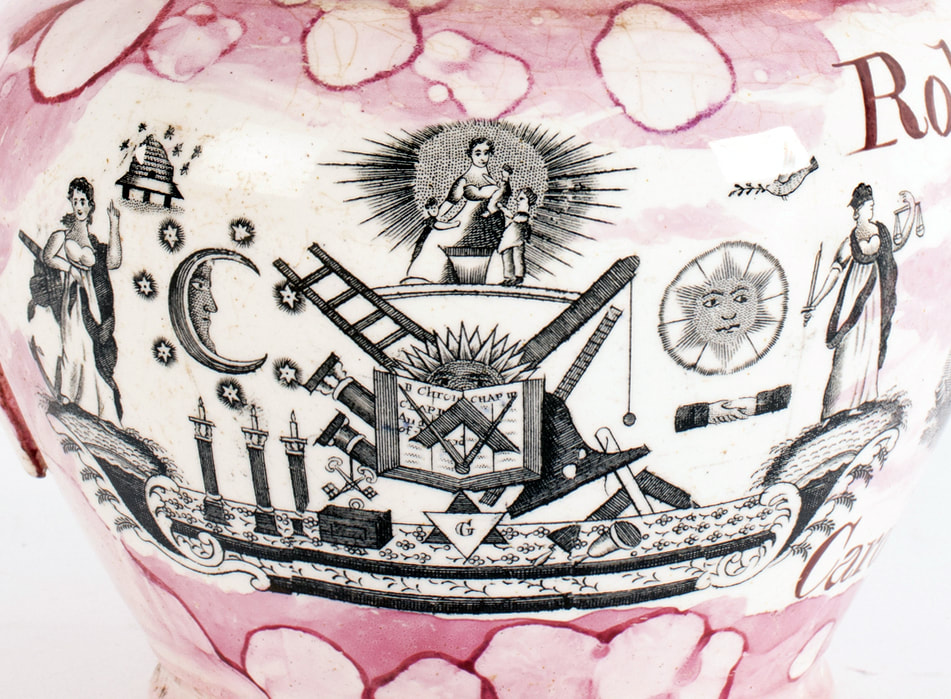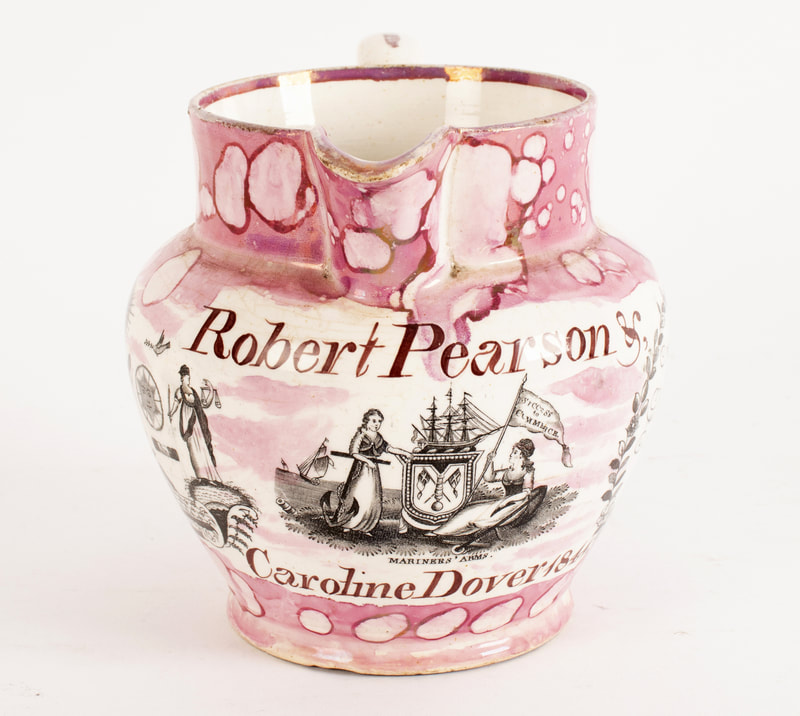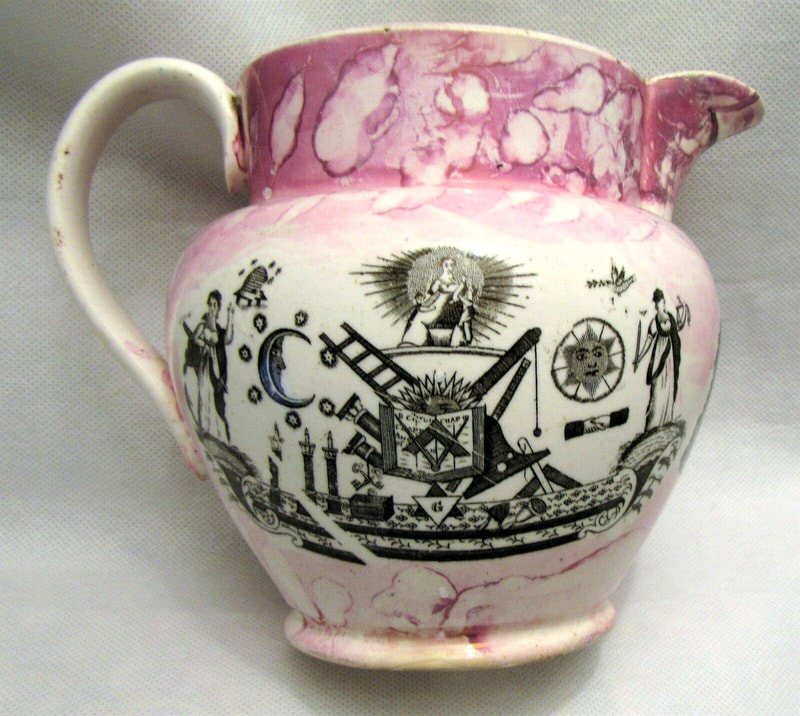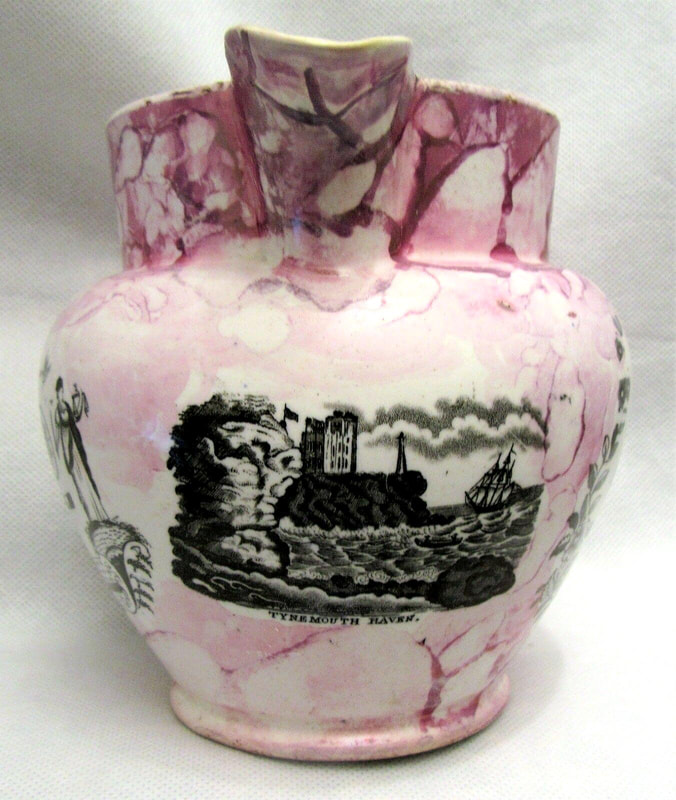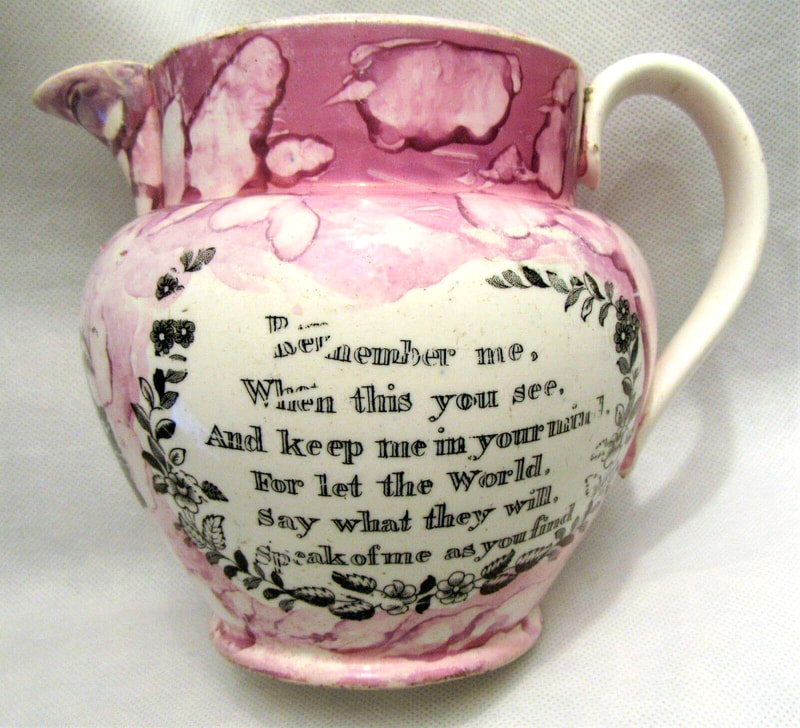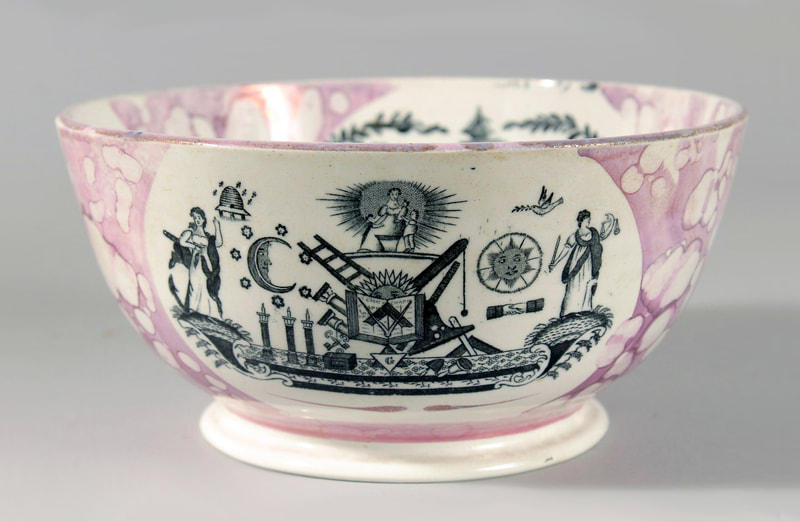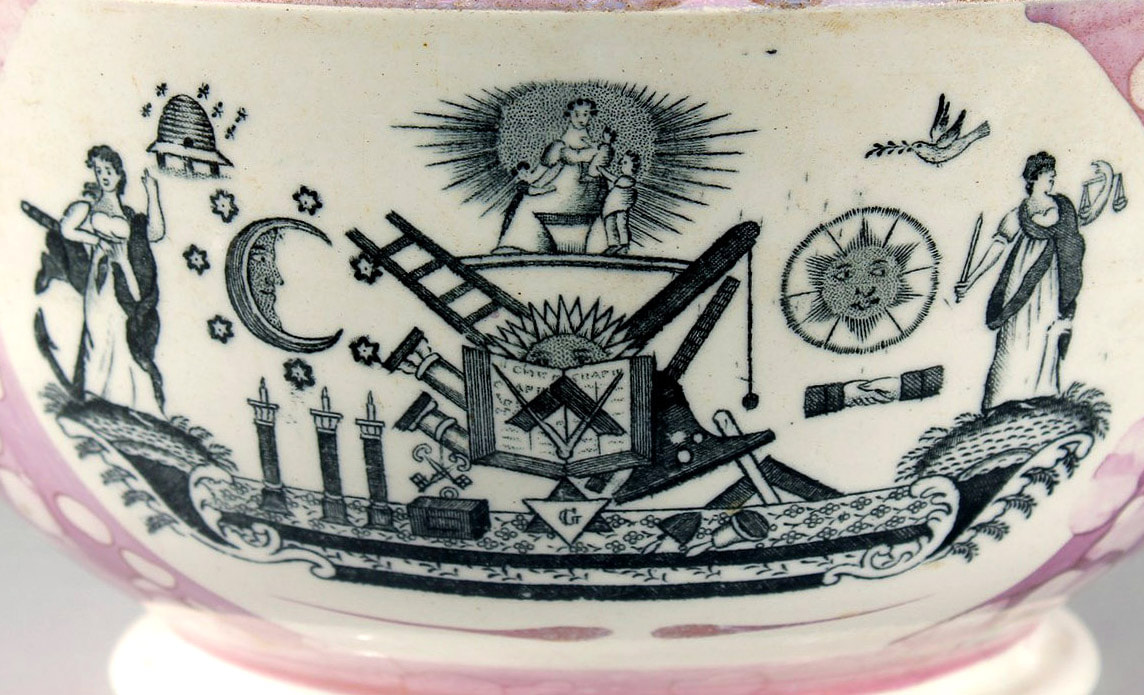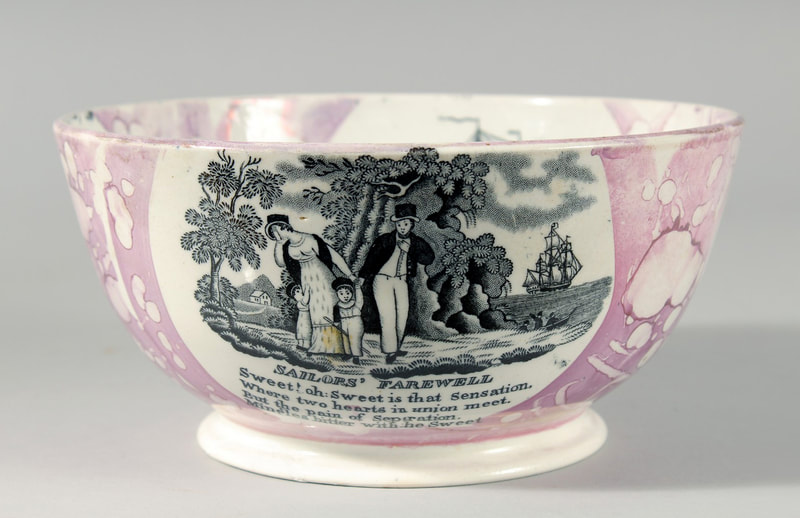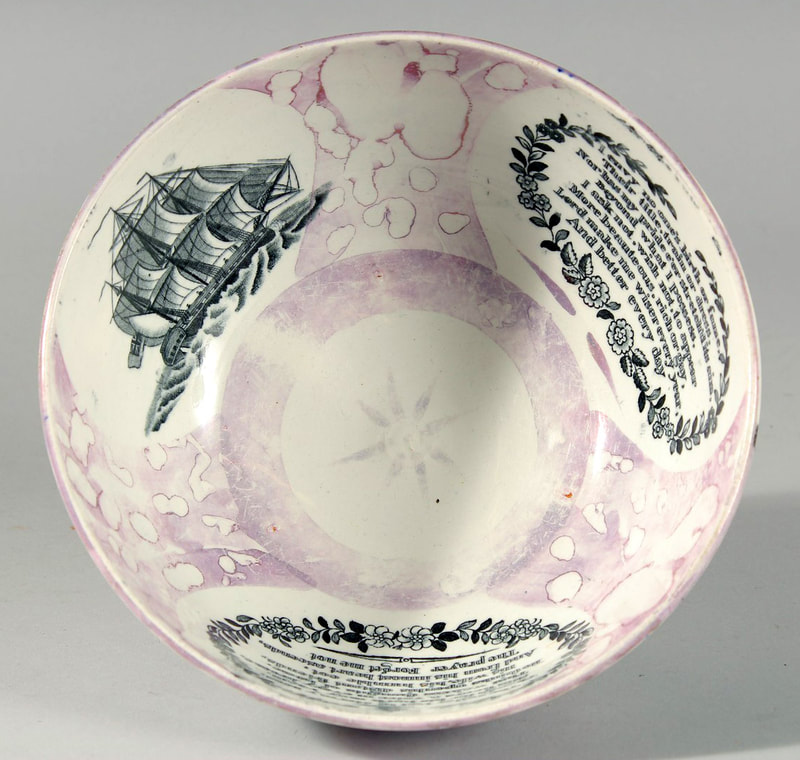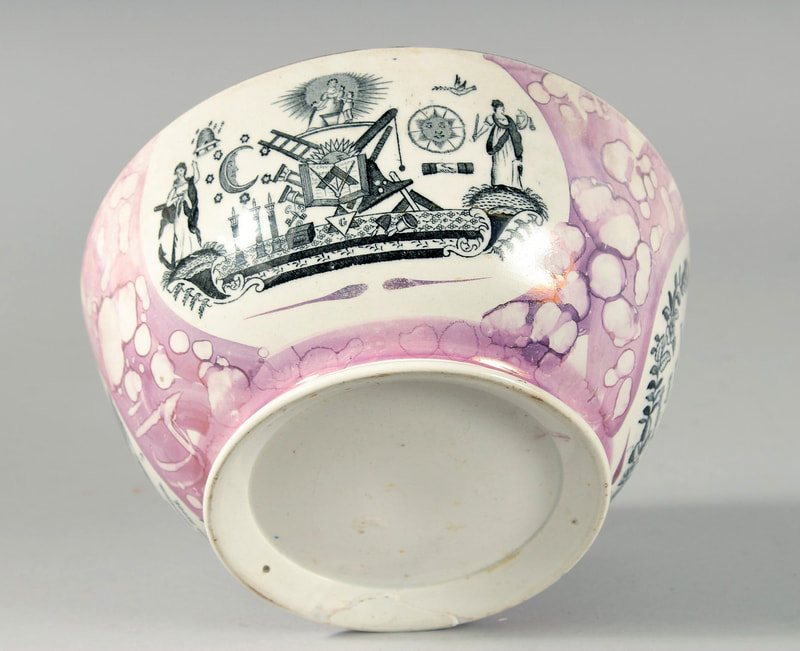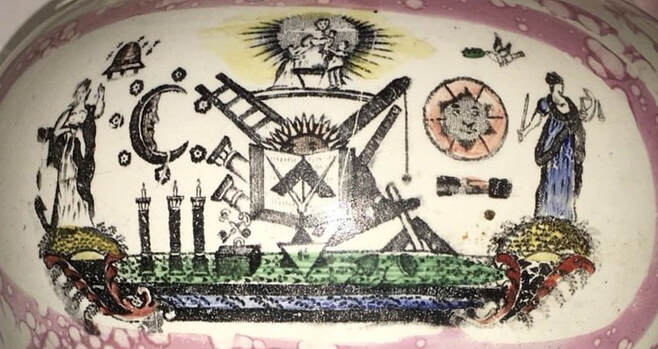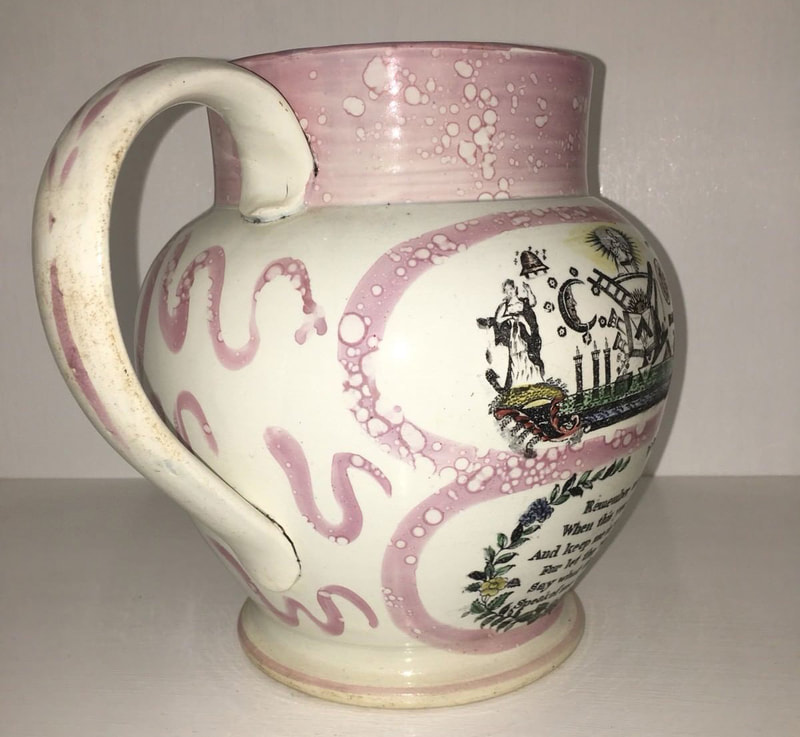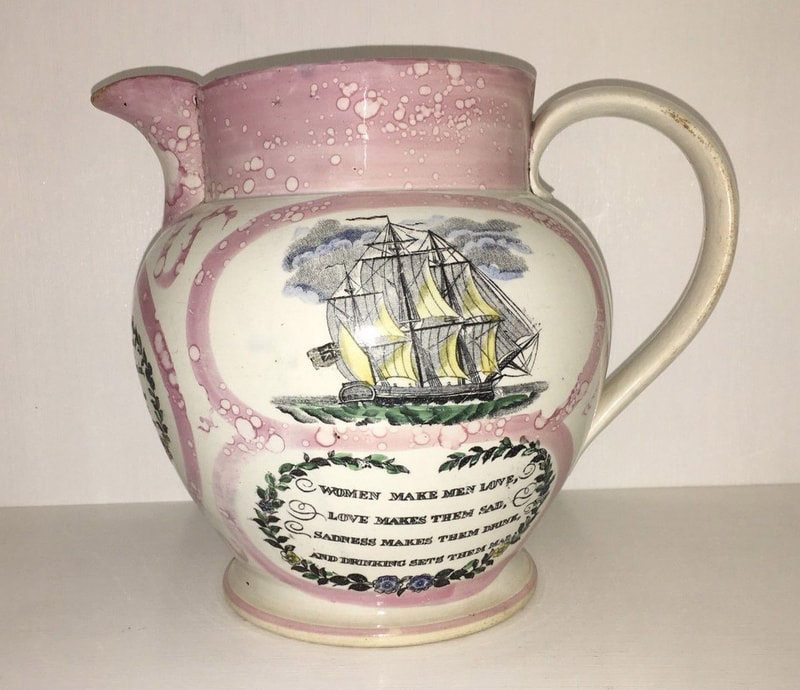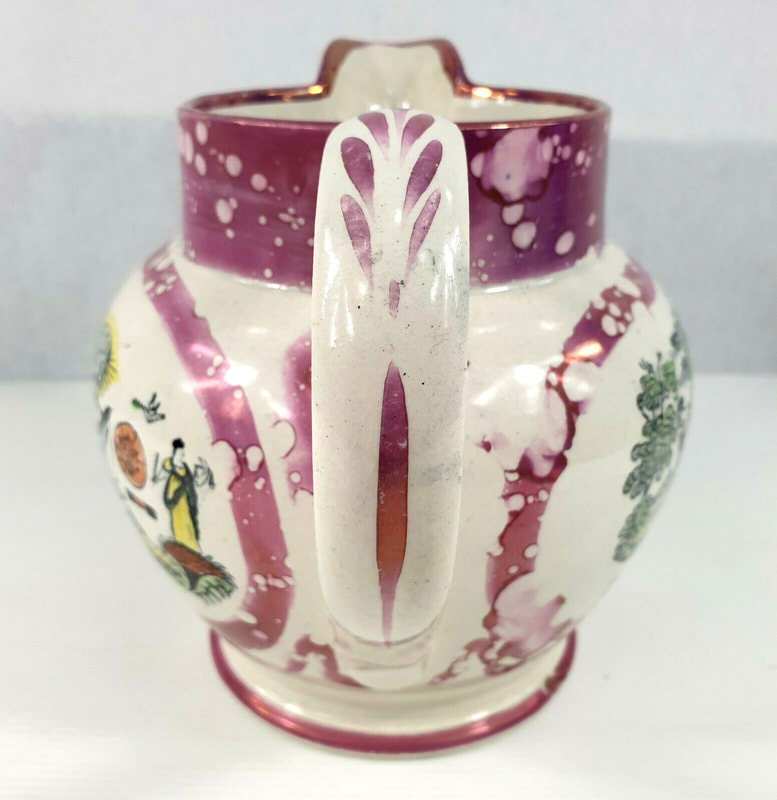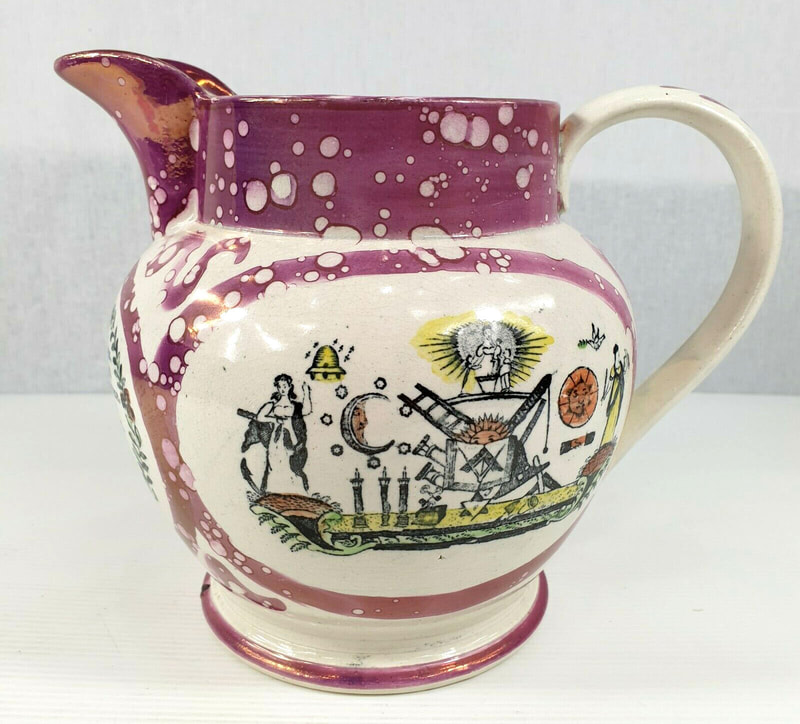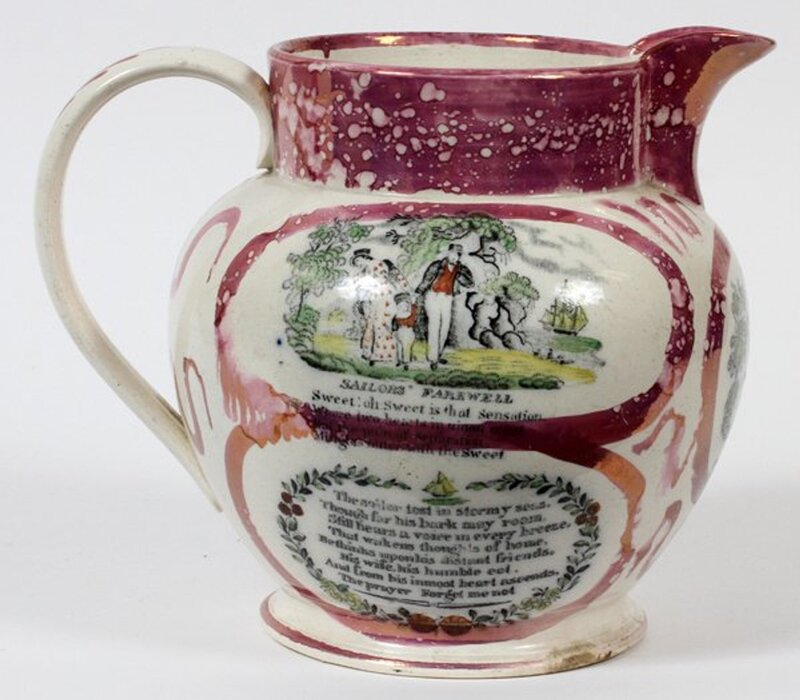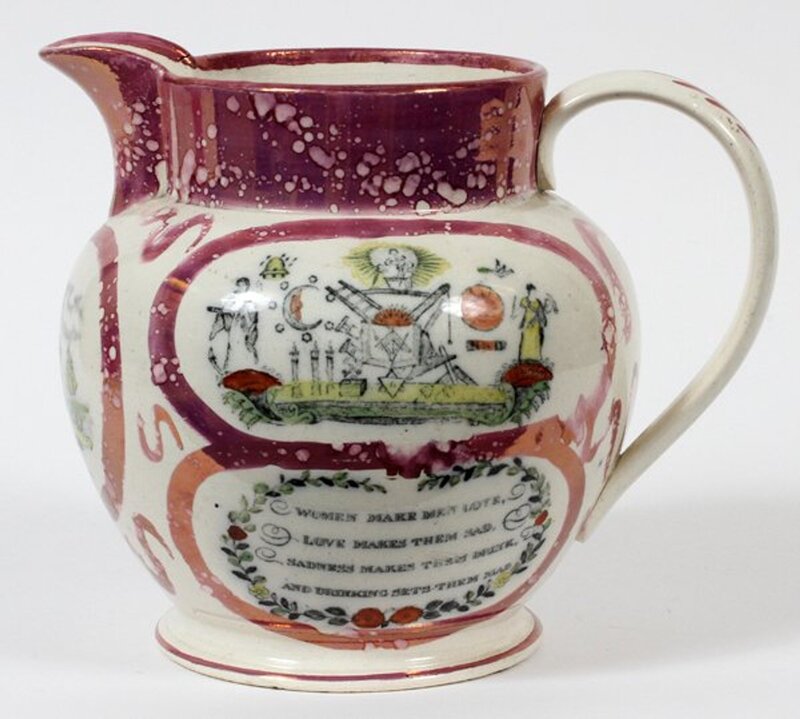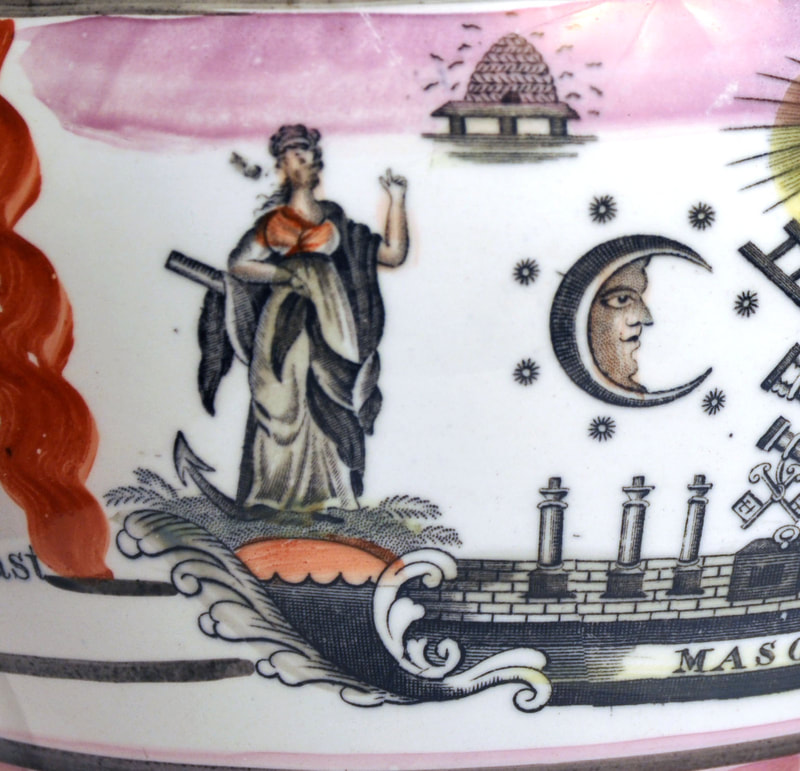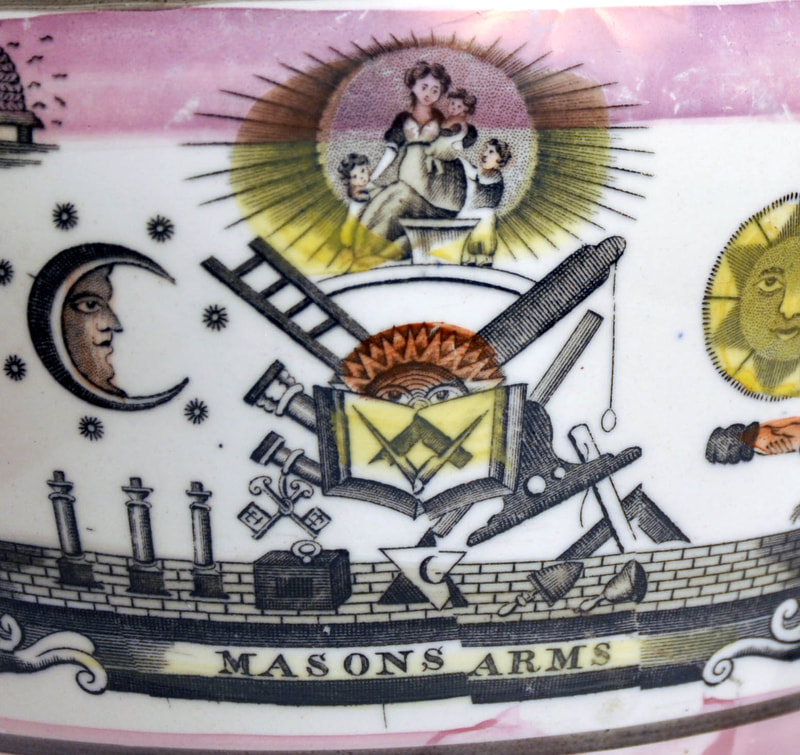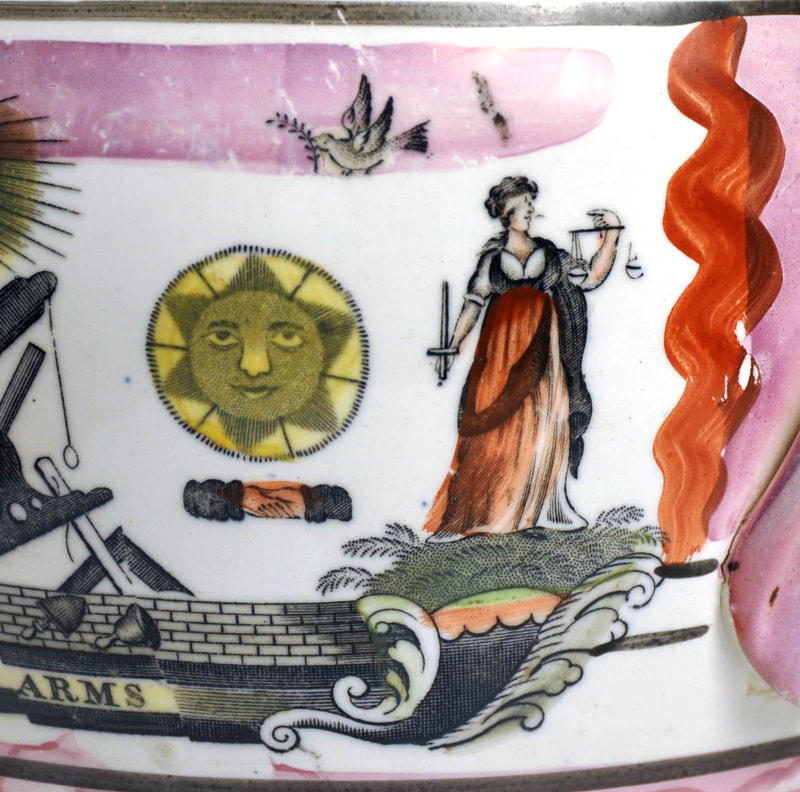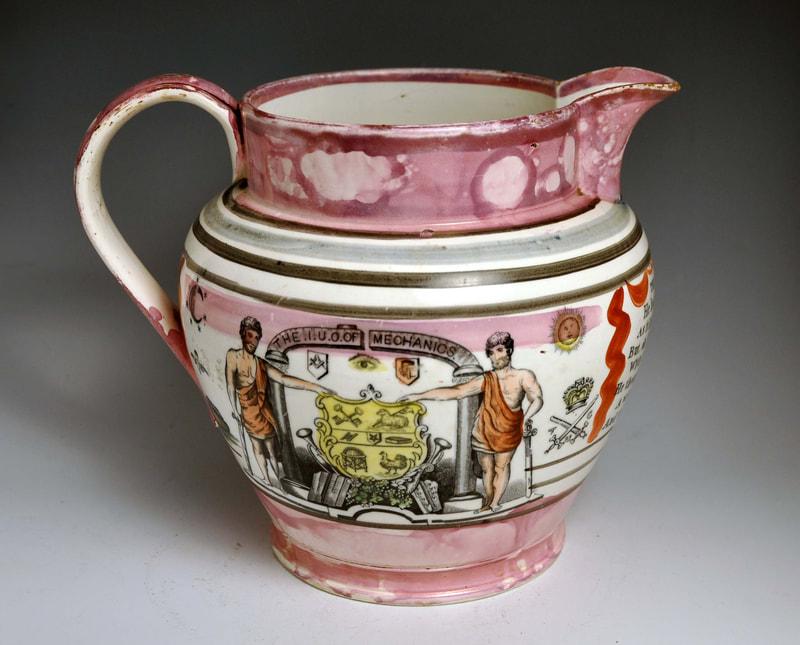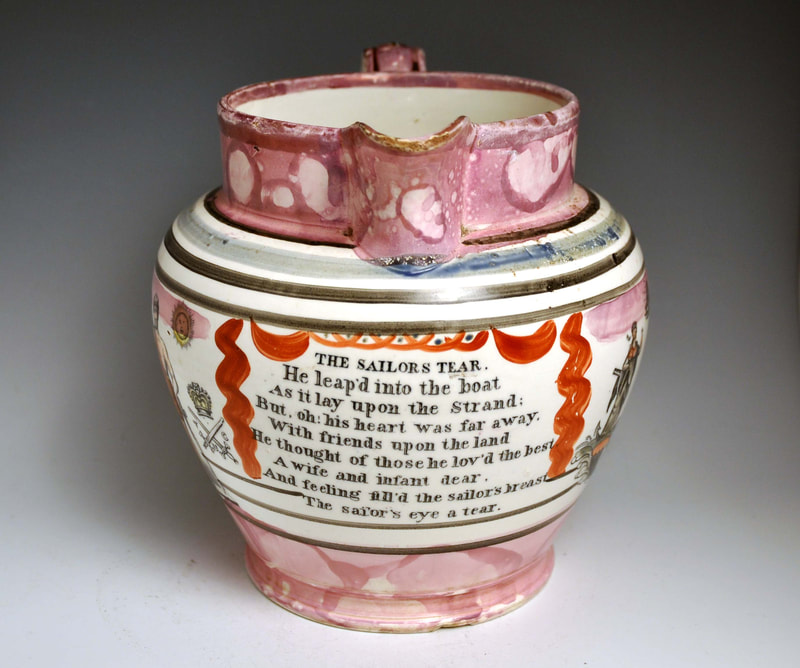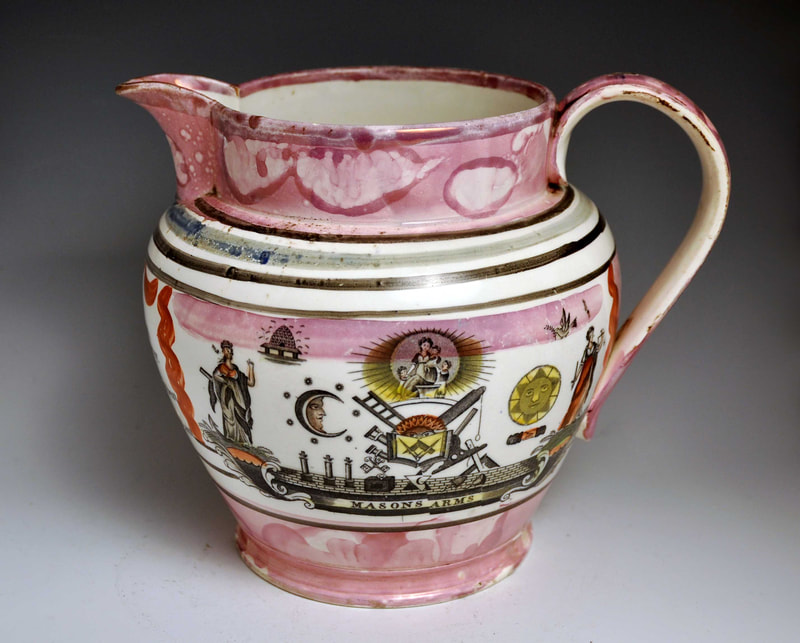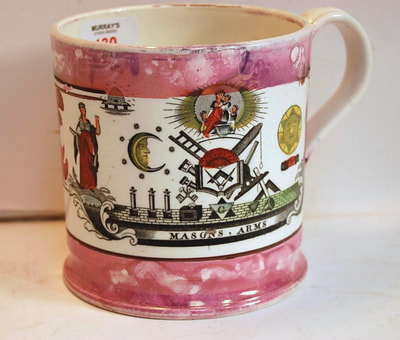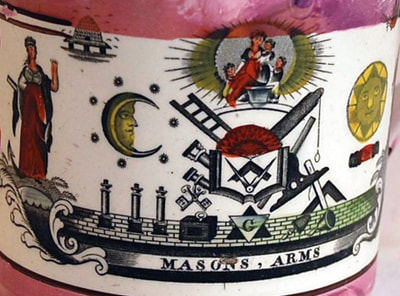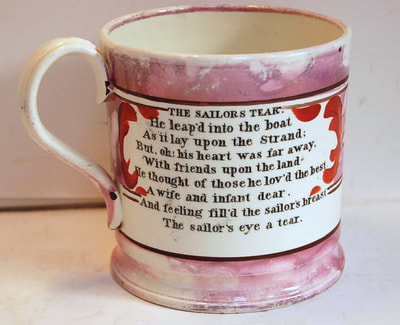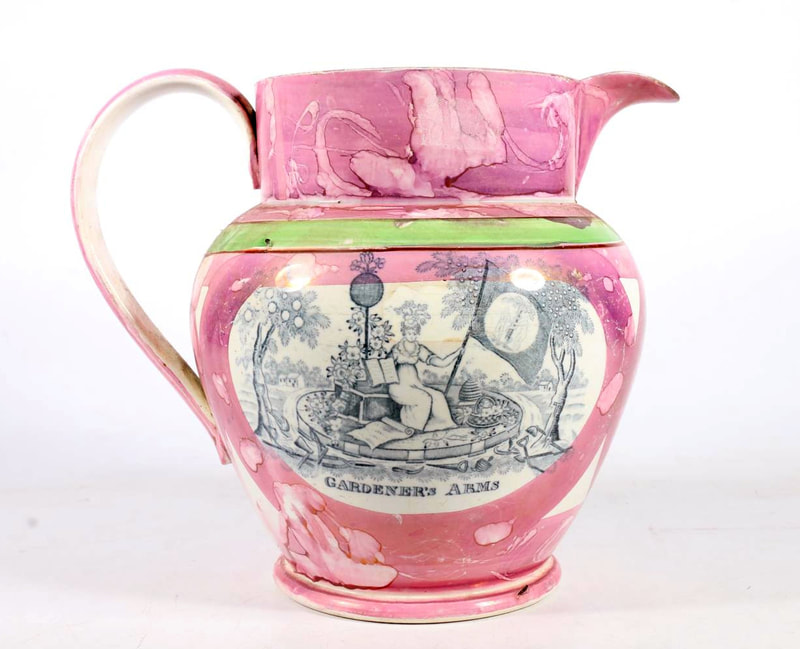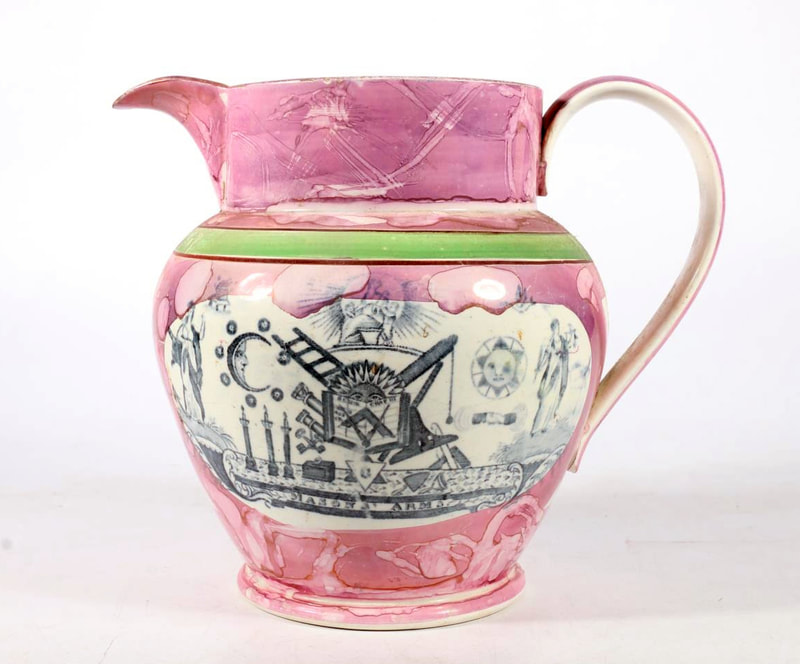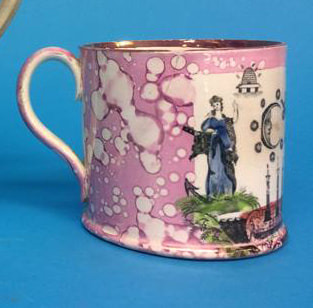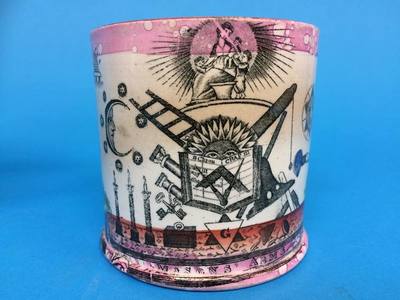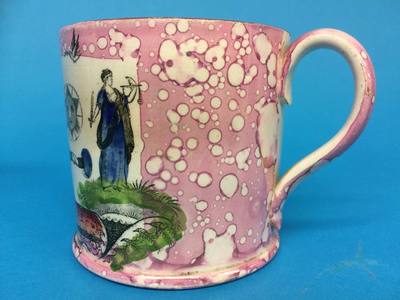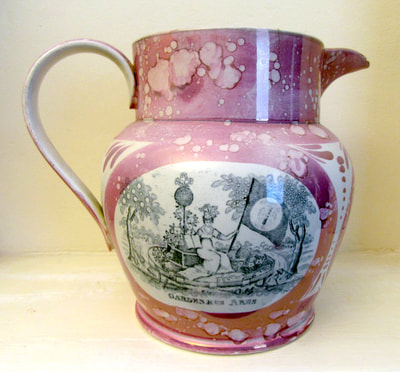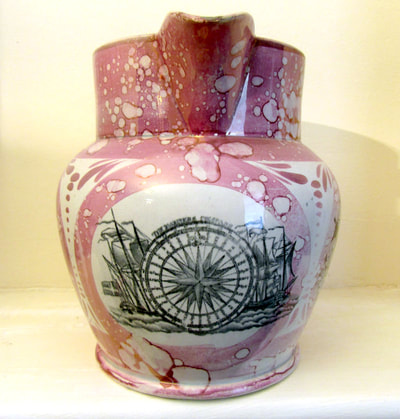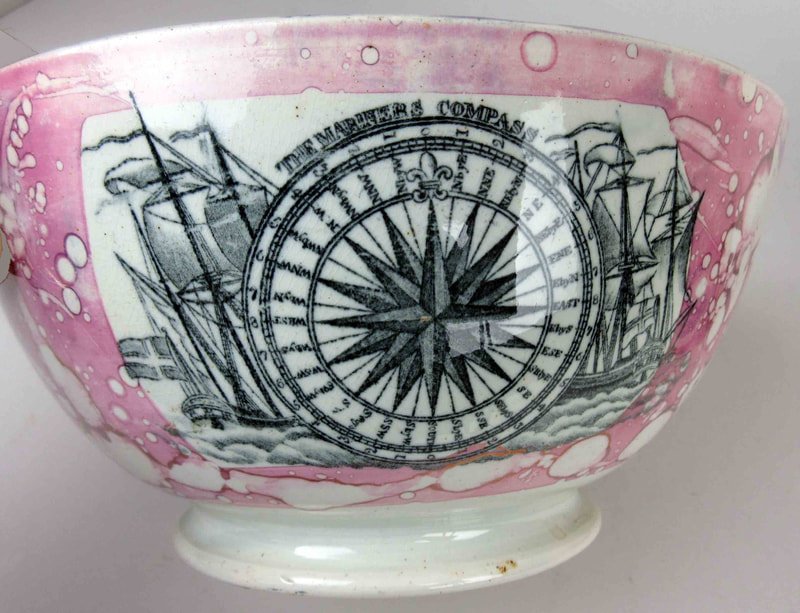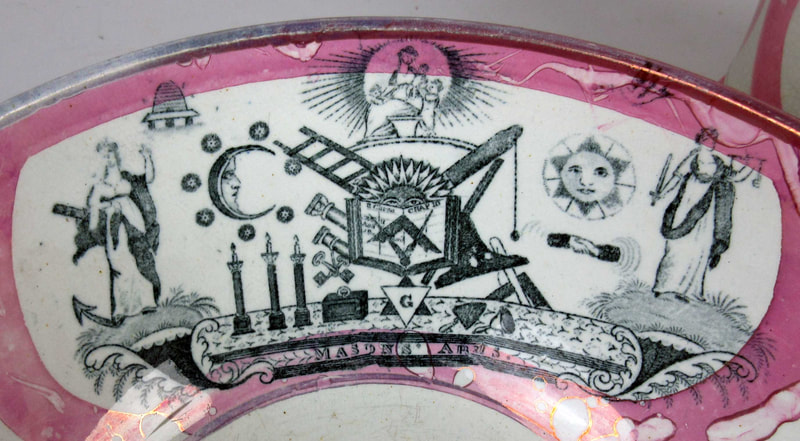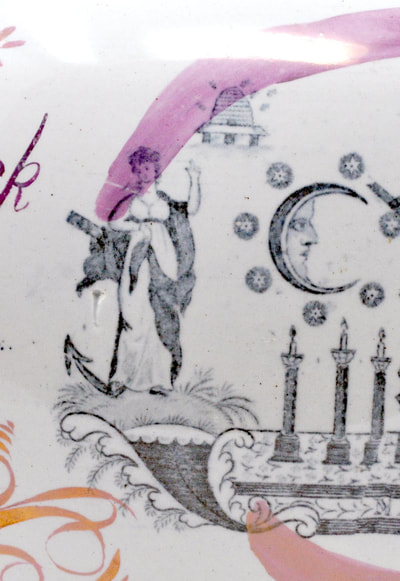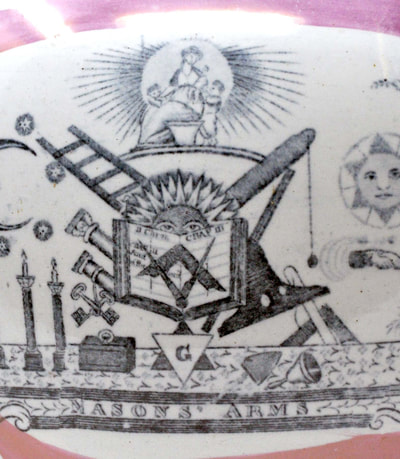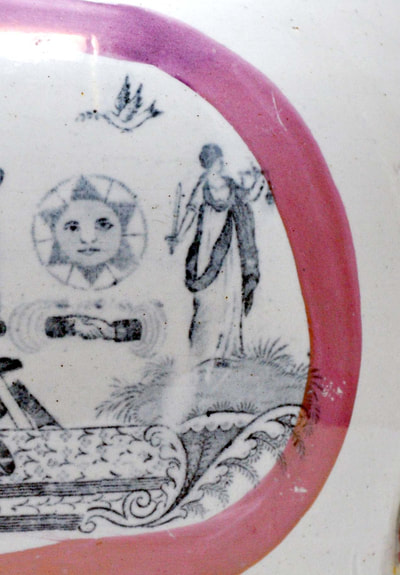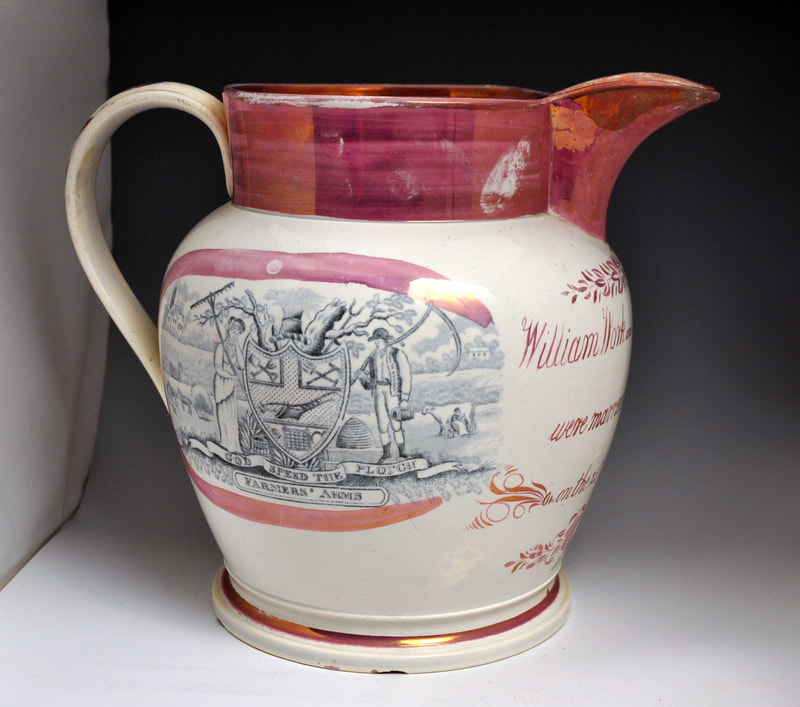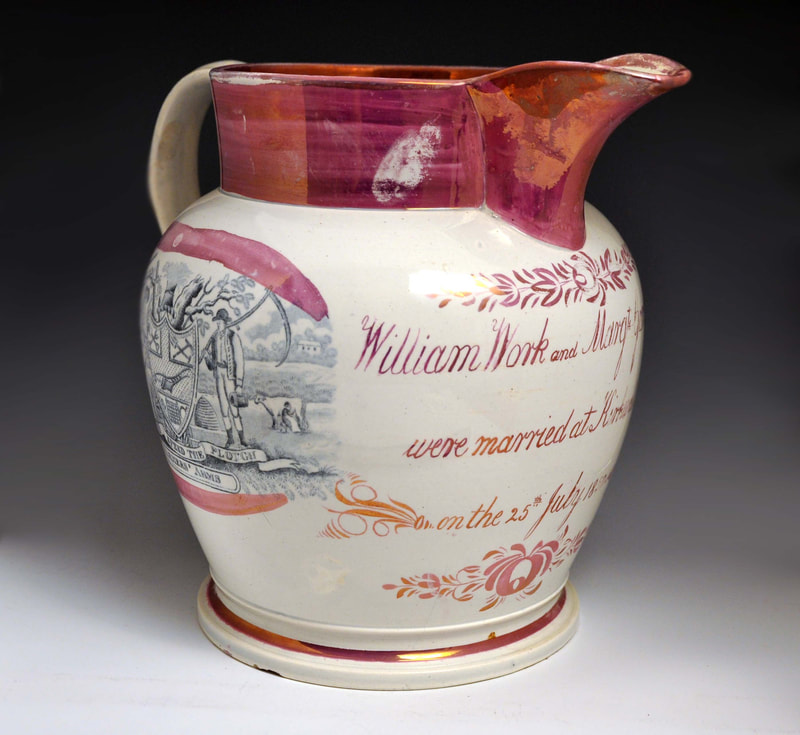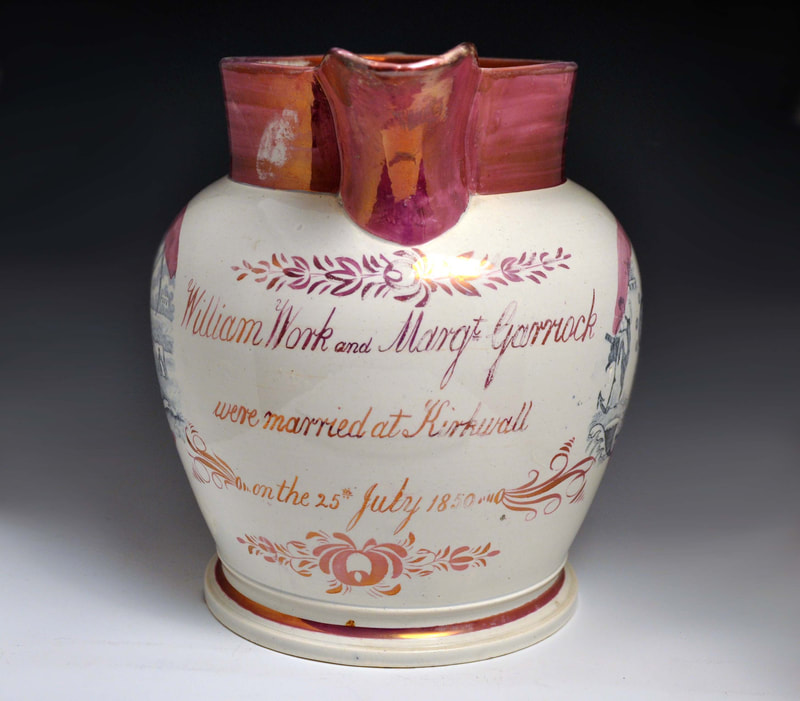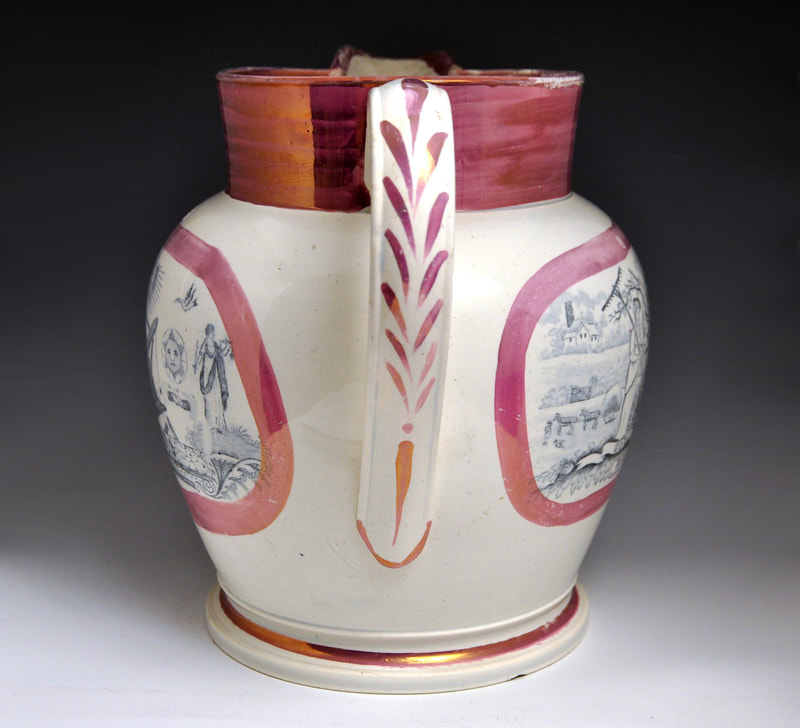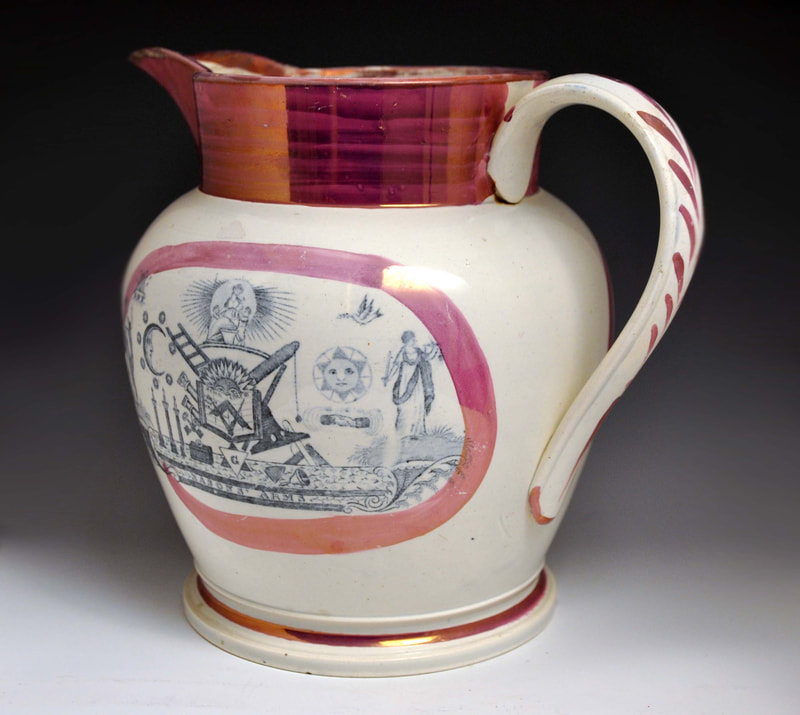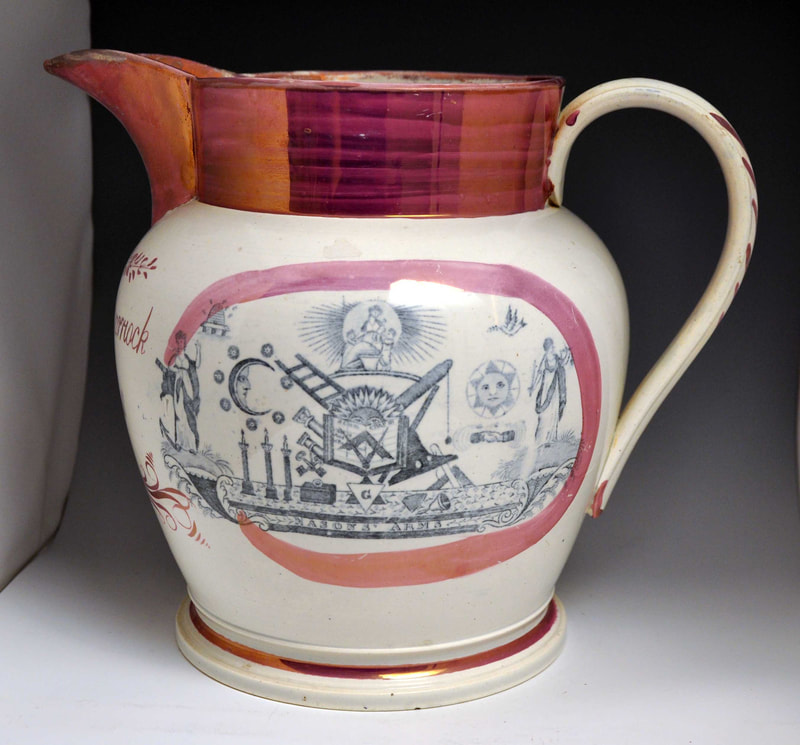Masons' Arms – Sunderland
Moore's Wear Pottery – plate 1
The transfer as it appears on a hand-painted creamware jug from the 1820s or perhaps 1830s.
Baker attributes the view of the bridge on the jug below (number 32) to Dawson, on the basis of its similarity to a marked Dawson bridge transfer. However, the transfer appears on marked 'Moore & Co' wares from the 1830s.
Attributed to Moore's Wear Pottery– plate 2
The wavy green and red decoration is typical of Moore's c1840. This could perhaps be a later imprint from the plate above. The auras around the stars that circle the moon are smaller. The flowers bottom centre, under the letter 'G' have more detail on the petal in this later version, which may have been added through re-engraving.
Attributed to Scott & Sons, Southwick
Although this transfer is similar to the Southwick versions below, it is the only example on this page with two sets of ladders above the sun in the centre. The lustre decoration and frog are similar to those used by Scott's in the 1830s.
Scott & Sons, Southwick – plate 1
I would guess the jug below is c1830, and belongs to the Scott and Sons partnership at Southwick, which Baker says ran from 1829 to 1841. These jugs with distinctive flower motif collars appear with transfers inscribed 'Scott Southwick'.
A similar Scott jug with flowered collar, and a 'Jack on a Cruise' transfer. The mug below it has a weaker imprint of the transfer, but similar enamelling. There is no frog inside it.
Scott Brothers & Co – plate 1
This jug is attributed to the 1841–1872 partnership on the basis that the noble bark transfer on the reverse has a blacked out makers mark. The original mark read S & Sons, Southwick, and was likely concealed when the pottery was rebranded as Scott Brothers and Co in 1841.
It is likely that this transfer is a degraded imprint from the Scott & Sons transfer plate above. The left detail below is from the Scott & Sons jug, and the Scott Brothers & Co jug.
Scott Brothers & Co – plate 2
Another Scott version of the transfer appears on the large mug below, likely 1840s. NB there are no printed factory marks on this item, but the flower transfers on the mug are typical of Scott's Pottery.
Below, the same version of the transfer is shown on two frog mugs (black frogs with pink lips are typical of Scott's), a mug with an inscription for 1848, and a small jug.
The bowl below has the Crimea transfer, and was made c1855.
A much more degraded version of the transfer appears on the larger Scott jug below, from circa 1860.
The engraving looks to have been reworked to restore clarity. The first detail is from the first mug above; the second from the large jug.
Scott Brothers & Co or Ball's Deptford Pottery – plate 2
This transfer appears to be from the same copper plate as the Scott plate 2 items above. The orange lustre suggests a date after 1870. Ball's Deptford Pottery acquired many of Scott's transfer plates and continued to produce lustre items into the 20th century. The simple lustre decoration on this bowl is similar to that found on pink-lustre items made by Ball's.
Scott Brothers & Co – plate 3
An atypically small version of this transfer appears on a Scott-impressed bowl, c1860.
Ball's Deptford Pottery, Sunderland – c1900
Note the clipped text above the transfer. It comes from the transfer above on the transfer plate. The moulded handle is typical of these late items.
Masons' Arms – Tyneside
Attributed to Bird & Co, 1823–1826? – North Shields, plate 1
Unlike the Sunderland examples above, the sun is on the left and the moon on the right. Also, the figures of Justice and Hope are titled.
Attributed to Cornfoot, Colville & Co, North Shields, 1828–1832 or
Cornfoot, Carr and Co, 1832–1838 – North Shields, plate 1
This jug shares the same transfer as the creamware mug above, but the imprint is less clear. More work needs to be done on the dating of wares from the North Shields partnerships. However, the red decoration appears on earlier wares, including items associated with the Alnwick election.
|
This jug (left photo) has distinctive horizontal lustre marks on the handle apparently peculiar to North Shields. These appear on the handles of all the pink-lustre, North Shields-attributed, jugs from the 1830s on this page, the brushstrokes applied with varying degrees of freedom. The right image shows the back of the 'Elizabeth Souhier' jug below. |
Attributed to Cornfoot, Carr and Co – North Shields, plate 2
The green stripes appear to copy the green flecks that appear on Maling items in the late 1830s. On that basis, this jug is attributed to the above partnership. Note that on this version, the moon is on the left and the sun on the right, like the Sunderland versions.
Below, photos showing the other transfers on the jug, and beneath it another similar. Both have the horizontal lustre marks on the handle.
In the absence of an inscription, dating these jugs isn't a precise science. However, the lighter lustre on this item seems in keeping with the above partnership. This large jug appears to have been commissioned by a Masonic lodge.
Attributed to Carr and Patton (1838–1846) – North Shields, plate 2
This transfer was is likely from the same copper plate as the Cornfoot, Carr and Co plate 2 above. I have attributed these heavily lustred jugs to the Carr and Patton partnership, but they could just precede it.
The second jug has an inscription dated 1840.
Attributed to Cornfoot, Carr and Co, North Shields or
Carr and Patton – North Shields, plate 3
The transfer below (sun on the left) was likely used by both Cornfoot, Carr and Co (1832–1838) and Carr and Patton (1838–1846) at North Shields. This jug has a hand-painted inscription. The auction description (Mellors and Kirk) read as follows. Elizabeth Jane Sohier (1823-1909) of the Parish of St Peter and later St Brelades, Jersey was the daughter of Henri Sohier and married firstly, in 1846 Philippe Renouf and secondly Clement Renaut. So the jug could have been a coming of age present, before Elizabeth married in 1846.
Below, the transfer on two similar highly-lustred jugs. These items all have the horizontal lustre marks terminating the decoration on the handle (the back of the Elizabeth Souhier jug is shown in the Cornfoot, Carr & Co 'plate 1' section above).
First below, a jug with maritime transfers and light lustre similar to the first jug above. And second, a jug commemorating the battle of Trafalgar, and the banner 'ENGLAND expects EVERY MAN TO DO his DUTY'.
Carr and Patton – North Shields, plate 4
This transfer appears on a more modern looking North Shields jug, dated 1841. The red painted script is typical of Carr and Patton items from the 1840s. Beneath it, a jug with the Tynemouth Haven transfer attributed to North Shields, also likely made in the 1840s.
The unmarked bowl below appears to have a transfer from the same copper plate. The star in the centre of the bowl is found on plaques from North Shields.
John Carr & Sons, North Shields
These jugs have wavy lustre decoration typical of late Carr items, c1870s. They tend to be heavily potted. The circles of lustre around the transfer are similar to those found on the Ball jugs above.
Redhead, Wilson & Co, Forth Banks, Newcastle Pottery – 1833–1838
The jug and the mug beneath it were likely made c183. Both have typical Newcastle Pottery decoration.
James Wallace & Co, Forth Banks, Newcastle Pottery – 1838–1858
The jug below has a green band associated with Newcastle Pottery. My guess is that the jug and the mug beneath it are later than those above, so c1840. This transfer is from a different copper plate. Note the candles under the moon on the left. Also the apostrophe after the word 'MASONS'. It is a comma on the transfer above.
The next two items have similar splash lustre to the mug above and are likely 1840s.
The huge wedding jug below has an inscription for 25th July 1850.
